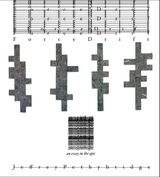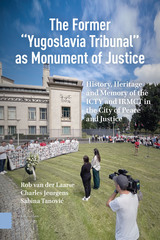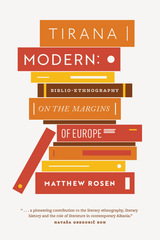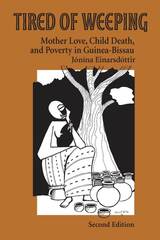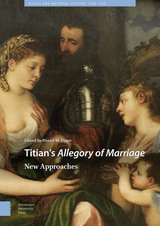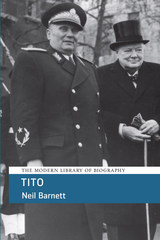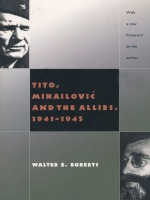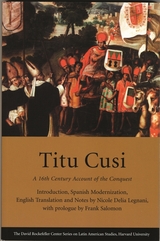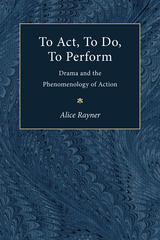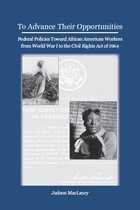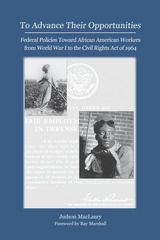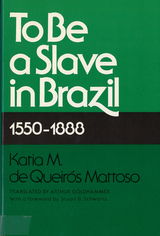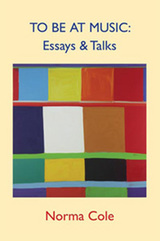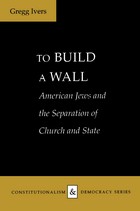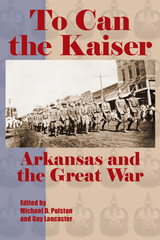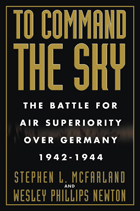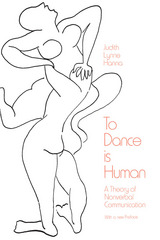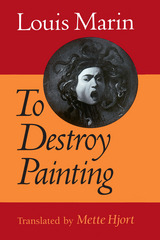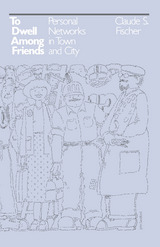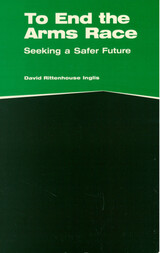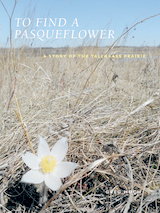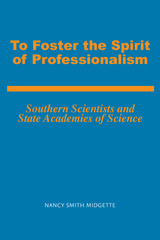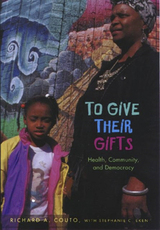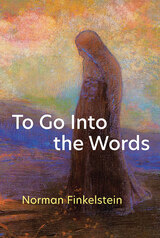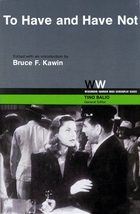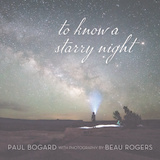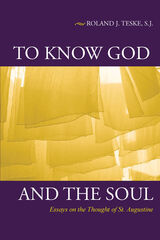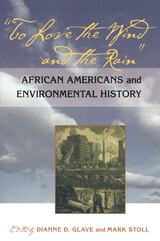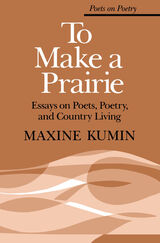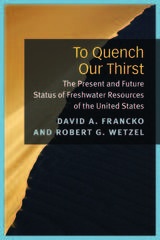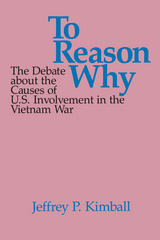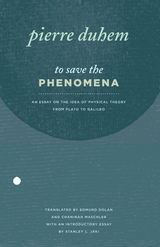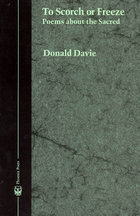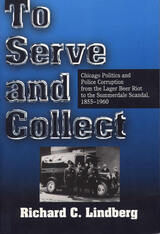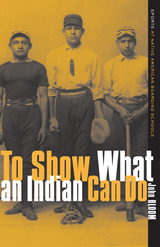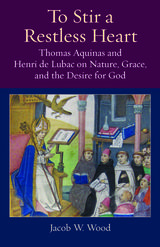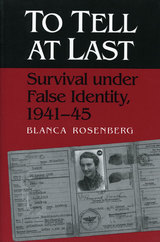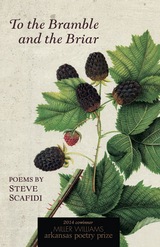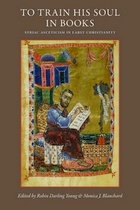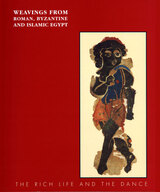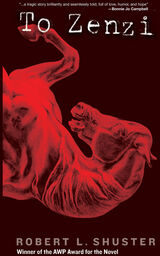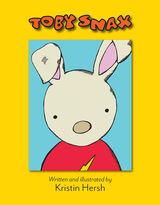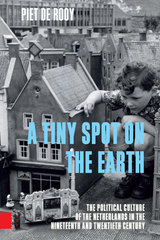 A Tiny Spot on the Earth: The Political Culture of the Netherlands in the Nineteenth and Twentieth Centuries
Piet de Rooy
Amsterdam University Press, 2015 In this survey of the Dutch political culture of the nineteenth and twentieth centuries, Piet de Rooy reveals that the 'polder model' often used to describe economic and social policymaking based on consensus is a myth. Instead, modern political culture in the Dutch Low Countries began with a revolution and is rife with rivalries among political and ideological factions. De Rooy argues that because of its extremely open economy, the country is vulnerable to external political, cultural, and economic pressures, and Dutch politics is a balancing act between profiting from international developments and maintaining sovereignty. The sudden rise of populism and Euroscepticism at the turn of the millennium, then, indicated a loss of this balance. Shining new light on the political culture of the Netherlands, this book provides insights into the polder model and the principles of pillarization in Dutch society.
The Dutch edition of this book, Ons stipje op de wereldkaart, was awarded the Prinsjesboekenprijs for the best book on Dutch national politics in 2014.
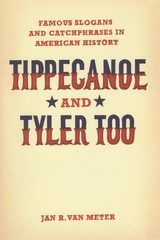 Tippecanoe and Tyler Too: Famous Slogans and Catchphrases in American History
Jan R. Van Meter
University of Chicago Press, 2008 “By necessity, by proclivity, by delight,” Ralph Waldo Emerson said in 1876, “we all quote.” But often the phrases that fall most readily from our collective lips—like “fire when ready,” “speak softly and carry a big stick,” or “nice guys finish last”—are those whose origins and true meanings we have ceased to consider. Restoring three-dimensionality to more than fifty of these American sayings, Tippecanoe and Tyler Too turns clichés back into history by telling the life stories of the words that have served as our most powerful battle cries, rallying points, laments, and inspirations. In individual entries on slogans and catchphrases from the early seventeenth to the late twentieth century, Jan Van Meter reveals that each one is a living, malleable entity that has profoundly shaped and continues to influence our public culture. From John Winthrop’s “We shall be as a city upon a hill” and the 1840 Log Cabin Campaign’s “Tippecanoe and Tyler Too” to Martin Luther King Jr.’s “I have a dream” and Ronald Reagan’s “Mr. Gorbachev, tear down this wall,” each of Van Meter’s selections emerges as a memory device for a larger political or cultural story. Taken together in Van Meter’s able hands, these famous slogans and catchphrases give voice to our common history even as we argue about where it should lead us. “As Van Meter argues, these are important ‘memory devices for a larger story.’ . . . The author has thoroughly researched all the catchphrases . . . . This book would make delightful in-flight reading or a nice gift for a trivia buff. Recommended.”—Choice
 Tips to Help You Do Your Best
Mike Carlson
Tupelo Press, 2025 A record of a poet’s wrestling with how to live and what to do; a provisional manual exploring how to be a better teacher, father, husband, poet, sibling, friend, and son.
Written over a fifteen-year period, a period in which events and politics seemed to defy reason, the poems collected in Tips to Help You Do Your Best seek an imaginative wisdom on the outskirts of conventional thinking. By writing obsessively about the landscape, the objects that litter it, and the people he finds loitering there, Mike Carlson arrives at the emotional truth of his experience, mapping the distance between irreverence and irony, cowardice, and courage, condolences and pure clear words.
In doing so, he also lays out a theory of poetry, a philosophical, aesthetic, and spiritual treatise that values object matter over subject matter. These poems approach understanding by image and rhythm, by light and shadow, and by means of encountering motorcycles and mushrooms and silos. While these poems often assume the authoritative and axiomatic tone of a guide book or set of instructions, they are at odds with easy explanation and drudgery.
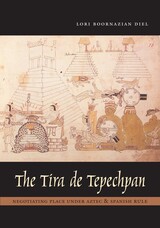 The Tira de Tepechpan: Negotiating Place under Aztec and Spanish Rule
By Lori Boornazian Diel
University of Texas Press, 2008 Created in Tepechpan, a relatively minor Aztec city in Central Mexico, the Tira de Tepechpan records important events in the city's history from 1298 through 1596. Most of the history is presented pictographically. A line of indigenous year signs runs the length of the Tira, with images above the line depicting events in Tepechpan and images below the line recording events at Tenochtitlan, capital of the Aztec empire and later the seat of Spanish rule. Written annotations amplify some of the images. In this volume, which includes color plates of the entire Tira, Lori Boornazian Diel investigates the motives behind the creation and modification of the Tira in the second half of the sixteenth century. She identifies the Tira's different contributors and reconciles their various histories by asking why these painters and annotators, working at different times, recorded the events that they did. Comparing the Tira to other painted histories from Central Mexico, Diel demonstrates that the main goal of the Tira was to establish the antiquity, autonomy, and prestige of Tepechpan among the Central Mexican city-states that vied for power and status in the preconquest and colonial worlds. Offering the unique point of view of a minor city with grand ambitions, this study of the Tira reveals imperial strategy from the grassroots up, showing how a subject city negotiated its position under Aztec and Spanish control.
Tirana Modern: Biblio-Ethnography on the Margins of Europe
Matthew Rosen
Vanderbilt University Press, 2022 Guided by the thesis that literature can transform social reality, Tirana Modern draws on ethnographic and historical material to examine the public culture of reading in modern Albania. As its starting point, this book asks: How has Albanian literature and literary translation shaped social action during the longue durée of Albanian modernity?
Drawing on material collected through fieldwork with a community of readers, writers, and translators attached to the independent Albanian publisher Pika pa sipërfaqe (Point without Surface), Tirana Modern provides a tightly focused ethnography of literary culture in Albania that brings into relief the more general dialectic between social imagination and social reality as mediated by reading and literature.
Tired of Weeping: Mother Love, Child Death, and Poverty in Guinea-Bissau
Jonina Einarsdottir
University of Wisconsin Press, 2004 In this comprehensive and provocative study of maternal reactions to child death in Guinea-Bissau, West Africa, anthropologist Jónína Einarsdóttir challenges the assumption that mothers in high-poverty societies will neglect their children and fail to mourn their deaths as a survival strategy. Based on ethnographic fieldwork conducted from 1993 to 1998 among the matrilineal Papel, who reside in the Biombo region, this work includes theoretical discussion of reproductive practices, conceptions of children, childcare customs, interpretations of diseases and death, and infanticide. Einarsdóttir also brings compelling narratives of life experiences and reflections of Papel women.
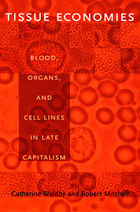 Tissue Economies: Blood, Organs, and Cell Lines in Late Capitalism
Catherine Waldby and Robert Mitchell
Duke University Press, 2006 As new medical technologies are developed, more and more human tissues—such as skin, bones, heart valves, embryos, and stem cell lines—are stored and distributed for therapeutic and research purposes. The accelerating circulation of human tissue fragments raises profound social and ethical concerns related to who donates or sells bodily tissue, who receives it, and who profits—or does not—from the transaction. Catherine Waldby and Robert Mitchell survey the rapidly expanding economies of exchange in human tissue, explaining the complex questions raised and suggesting likely developments. Comparing contemporary tissue economies in the United Kingdom and United States, they explore and complicate the distinction that has dominated practice and policy for several decades: the distinction between tissue as a gift to be exchanged in a transaction separate from the commercial market and tissue as a commodity to be traded for profit. Waldby and Mitchell pull together a prodigious amount of research—involving policy reports and scientific papers, operating manuals, legal decisions, interviews, journalism, and Congressional testimony—to offer a series of case studies based on particular forms of tissue exchange. They examine the effect of threats of contamination—from HIV and other pathogens—on blood banks’ understandings of the gift/commodity relationship; the growth of autologous economies, in which individuals bank their tissues for their own use; the creation of the United Kingdom’s Stem Cell bank, which facilitates the donation of embryos for stem cell development; and the legal and financial repercussions of designating some tissues “hospital waste.” They also consider the impact of different models of biotechnology patents on tissue economies and the relationship between experimental therapies to regenerate damaged or degenerated tissues and calls for a legal, for-profit market in organs. Ultimately, Waldby and Mitchell conclude that scientific technologies, the globalization of tissue exchange, and recent anthropological, sociological, and legal thinking have blurred any strict line separating donations from the incursion of market values into tissue economies.
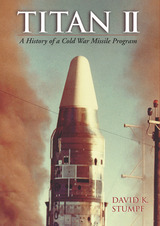 Titan II: A History of a Cold War Missile Program
David K. Stumpf
University of Arkansas Press, 2001 The Titan II ICBM (intercontinental ballistic missile) program was developed by the United States military to bolster the size, strength, and speed of the nation’s strategic weapons arsenal in the 1950s and 1960s. Each missile carried a single warhead—the largest in U.S. inventory—used liquid fuel propellants, and was stored and launched from hardened underground silos. The missiles were deployed at basing facilities in Arkansas, Arizona, and Kansas and remained in active service for over twenty years. Since military deactivation in the early 1980s, the Titan II has served as a reliable satellite launch vehicle.
This is the richly detailed story of the Titan II missile and the men and women who developed and operated the system. David K. Stumpf uses a wide range of sources, drawing upon interviews with and memoirs by engineers and airmen as well as recently declassified government documents and other public materials. Over 170 drawings and photographs, most of which have never been published, enhance the narrative. The three major accidents of the program are described in detail for the first time using authoritative sources.
Titan II will be welcomed by librarians for its prodigious reference detail, by technology history professionals and laymen, and by the many civilian and Air Force personnel who were involved in the program—a deterrent weapons system that proved to be successful in defending America from nuclear attack.
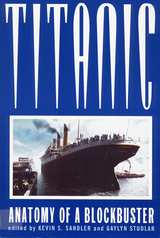 Titanic: Anatomy of a Blockbuster
Edited by Kevin S Sandler and Gaylyn Studlar
Rutgers University Press, 1999 On April 14, 1912, the Titanic struck an iceberg off Newfoundland. Taking more than 1,500 souls with her, Titanic sunk on what was intended to be the glorious maiden voyage of the biggest, most expensive, and most technologically advanced ship ever built. In 1997, James Cameron’s Titanic, the most expensive and technologically advanced movie ever made, hit theaters. In 13 weeks, it became the highest-grossing film in North America, and shortly thereafter, the first motion picture to earn a billion dollars worldwide. The cultural studies and film scholars who have contributed 13 essays to this collection ask the key question—Why? What made Titanic such a popular movie? Why has this film become a cultural and film phenomenon? What makes it so fascinating to the film-going public? The articles address everything from the nostalgia evoked by the film to the semiotic meaningfulness created around “The Heart of the Ocean” diamond that figures so prominently as a symbol in the film. Contributors address questions of the representations of class, sexuality, and gender; analyze the cross-cultural reception of the film in nationally specific contexts; examine the impact of strategies for marketing the film through music; and cover the implications of the budget toward the film’s success. Finally, the contributors address the film’s multi-faceted relationship to genre, history, stardom, and contemporary social and economic means.
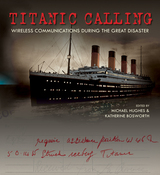 Titanic Calling: Wireless Communications during the Great Disaster
Edited by Michael Hughes and Katherine Bosworth
Bodleian Library Publishing, 2012 Published in commemoration of the one-hundredth anniversary of the Titanic’s sinking, this book tells the story of that fateful night from an unusual angle: through the many wireless communications sent to and from the land stations and the ships involved as the tragic events unfolded. Drawing on the extensive record of wireless transmissions in the Marconi Archives, Titanic Calling recounts this legendary story the way it was first heard, beginning with repeated warnings—just hours before the collision—of several large icebergs unusually far south and alarmingly close to the Titanic’s course. The story follows senior operator Jack Phillips as he sends distress messages to nearby ships and shows how these urgent calls for help were received and rapidly relayed across the Atlantic in a desperate attempt to save the lives of the Titanic’s passengers and crew. Finally, the distant SS Virginian receives the Titanic’s final, broken message. The story concludes with the rescue of the fortunate survivors, who radio messages to loved ones from aboard the RMS Carpathia while safely on their way to New York. Illustrated throughout with photographs of the messages and including full transcripts of original material, the book also features an introduction to the development of maritime wireless communications and a discussion of the Marconi Archives’s Titanic collection. The forced brevity of the messages lends the narrative a startling sense of immediacy and brings to life to the voices of the individuals involved.
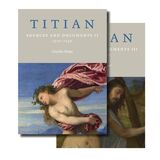 Titian: Sources and Documents
Charles Hope
Paul Holberton Publishing, 2021 This ambitious work collects all known documents related to the painter Titian dating from his era.
Titian was one of the most famous, successful, and long-lived of the Renaissance painters. Much of his output was for rulers or institutions whose archives have been largely preserved, and many of his family papers have also survived. Titian: Sources and Documents includes all known documents relating to Titian and his work dating from his lifetime, along with all known references to Titian in contemporaneous publications. The relevant section of each text is transcribed in full, preceded by a short summary in English, with extensive annotation and, where necessary, a commentary. The collection also includes all biographical material published before 1700 and all other texts that could realistically be thought to reflect first- or second-hand anecdotal information about him. The particular strengths and limitations of the principal early printed sources and the circumstances in which they were produced are discussed in a substantial introduction, which also includes an overview of the main archival collections consulted in the preparation of the book.
Titian's Allegory of Marriage: New Approaches
Daniel M. Unger
Amsterdam University Press, 2022 This book offers nine new approaches toward a single work of art, Titian’s Allegory of Marriage or Allegory of Alfonso d’Avalos, dated to 1530/5. In earlier references, the painting was named simply Allegory, alluding to its enigmatic nature. The work follows in a tradition of such ambiguous Venetian paintings as Giovanni Bellini’s Sacred Allegory and Giorgione’s Tempest. Throughout the years, Titian’s Allegory has engendered a range of diverse interpretations. Art historians such as Hans Tietze, Erwin Panofsky, Walter Friedlaender, and Louis Hourticq, to mention only a few, promoted various explanations. This book offers novel approaches and suggests new meanings toward a further understanding of this somewhat abstruse painting.
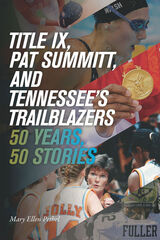 Title IX, Pat Summitt, and Tennessee's Trailblazers: 50 Years, 50 Stories
Mary Ellen Pethel
University of Tennessee Press, 2022 In June 1972, President Richard Nixon put pen to paper and signed the Educational Amendments of 1972 into law. The nearly 150-page document makes no mention of “gender,” “athletics,” “girls,” or “women.” The closest reference to “sport” is transportation. In fact, the bill did not appear to contain anything earth shattering. But tucked into its final pages, a heading appears, “Title IX—Prohibition of Sex Discrimination.” These 37 words would change the world for girls and women across the United States. On its face, Title IX legally guaranteed equal opportunity in education. In time, Title IX would serve as the tipping point for the modern era of women’s sport. Slowly but surely, women’s athletics at the high school and collegiate levels grew to prominence, and Tennessee fast emerged as a national leader.
In Title IX, Pat Summitt, and Tennessee’s Trailblazers, Mary Ellen Pethel introduces readers to past and present pioneers—each instrumental to the success of women’s athletics across the state and nation. Through vibrant profiles, Pethel celebrates the lives and careers of household names like Pat Summitt and Candace Parker, as well as equally important forerunners such as Ann Furrow and Teresa Phillips. Through their lived experiences, these fifty individuals laid the foundation for athletic excellence in Tennessee, which in turn shaped the national landscape for women’s sports. The book also provides readers with a fuller understanding of Title IX, as well as a concise history of women’s athletics in the pre- and post-Title IX eras.
With interviewees ranging from age 20 to 93, Pethel artfully combines storytelling with scholarship. Guided by the voices of the athletes, coaches, and administrators, Pethel vividly documents achievement and adversity, wins and losses, and advice for the next generation. This book represents the first statewide compilation of its kind—offering readers a behind-the- scenes perspective of Tennessee women who dedicated their lives to the advancement of sport and gender equality. Readers will delight in Title IX, Pat Summitt, and Tennessee’s Trailblazers: 50 Years, 50 Stories.
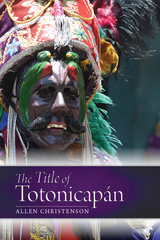 The Title of Totonicapán
transcription, translation, and commentary by Allen J. Christenson
University Press of Colorado, 2022 This work is the first English translation of the complete text of the Title of Totonicapán, one of the most important documents composed by the K’iche’ Maya in the highlands of Guatemala, second only to the Popol Vuh. The original document was completed in 1554, only a few decades after the Spanish Conquest of the K’iche’ people in 1524. This volume contains a wholly new translation from the original K’iche’ Maya text, based on the oldest known manuscript copy, rediscovered by Robert Carmack in 1973.
The Title of Totonicapán is a land title written by surviving members of the K’iche’ Maya nobility, a branch of the Maya that dominated the highlands of western Guatemala prior to the Spanish invasion in 1524, and it was duly signed by the ruling lords of all three major K’iche’ lineages—the Kaweqib’, the Nijayib’, and the Ajaw K’iche’s. Titles of this kind were relatively common for Maya communities in the Guatemalan highlands in the first century after the Spanish Conquest as a means of asserting land rights and privileges for its leaders. Like the Popol Vuh, the Title of Totonicapán is written in the elevated court language of the early Colonial period and eloquently describes the mythic origins and history of the K’iche’ people. For the most part, the Title of Totonicapán agrees with the Popol Vuh’s version of K’iche’ history and cosmology, providing a complementary account that attests traditions that must have been widely known and understood. But in many instances the Totonicapán document is richer in detail and departs from the Popol Vuh’s more cursory description of history, genealogy, and political organization. In other instances, it contradicts assertions made by the authors of the Popol Vuh, perhaps a reflection of internal dissent and jealousy between rival lineages within the K’iche’ hierarchy. It also contains significant passages of cosmology and history that do not appear in any other highland Maya text.
This volume makes a comprehensive and updated edition of the Title of Totonicapán accessible to scholars and students in history, anthropology, archaeology, and religious studies in Latin America, as well as those interested in Indigenous literature and Native American/Indigenous studies more broadly. It is also a stand-alone work of Indigenous literature that provides additional K’iche’ perspectives, enhancing the reading of other colonial Maya sources.
 Titles, Conflict, and Land Use: The Development of Property Rights and Land Reform on the Brazilian Amazon Frontier
Lee J. Alston, Gary D. Libecap, and Bernardo Mueller
University of Michigan Press, 1999 The Amazon, the world's largest rain forest, is the last frontier in Brazil. The settlement of large and small farmers, squatters, miners, and loggers in this frontier during the past thirty years has given rise to violent conflicts over land as well as environmental duress. Titles, Conflict, and Land Use examines the institutional development involved in the process of land use and ownership in the Amazon and shows how this phenomenon affects the behavior of the economic actors. It explores the way in which the absence of well-defined property rights in the Amazon has led to both economic and social problems, including lost investment opportunities, high costs in protecting claims, and violence. The relationship between land reform and violence is given special attention.
The book offers an important application of the New Institutional Economics by examining a rare instance where institutional change can be empirically observed. This allows the authors to study property rights as they emerge and evolve and to analyze the effects of Amazon development on the economy. In doing so they illustrate well the point that often the evolution of economic institutions will not lead to efficient outcomes.
This book will be important not only to economists but also to Latin Americanists, political scientists, anthropologists, and scholars in disciplines concerned with the environment.
Lee Alston is Professor of Economics, University of Illinois, and Research Associate for the National Bureau of Economic Research. Gary Libecap is Professor of Economics and Law, University of Arizona, and Research Associate for the National Bureau of Economic Research. Bernardo Mueller is Assistant Professor, Universidade de Brasilia.
Tito
Neil Barnett
Haus Publishing, 2006 Inspirational partisan leader; doctrinaire communist and yet a thorn in Moscow's side; leading light in the Non Aligned Movement. The break-up of Yugoslavia, the country Tito, the Croat turned Yugoslav had created was inevitable after his death in 1980.
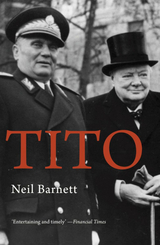 Tito
Neil Barnett
Haus Publishing, 2021 A biography of the charismatic and controversial Yugoslavian leader Josip Broz Tito.
The near-mythological figure Josip Broz Tito was a complicated one. An oppressor, a dictator, a reformer, and a playboy, Tito was an inspirational partisan leader and scourge of the Germans during their occupation of Yugoslavia in the Second World War, a doctrinaire communist, and an ever-present thorn in Moscow’s side. He managed Yugoslavia’s internal tensions through personality, a force of will, and political oppression.
It was only after his death in 1980 that the true scale of his influence was understood. At that time, Yugoslavia’s institutions and politicians were revealed as rudderless, and the country created by Tito—a Croat turned Yugoslav—collapsed into a bloody and at times genocidal civil war. These ethnic conflicts were Tito’s nightmare, yet, as Neil Barnett shows in this short but engaging biography, they were in many ways the result of his own myopic egomania.
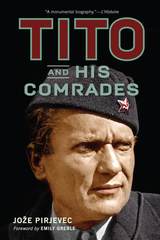 Tito and His Comrades
Jože Pirjevec, Foreword by Emily Greble
University of Wisconsin Press, 2018 This landmark biography reveals the life of one of the most powerful figures of the Cold War era. Josip Broz (1892–1980), nicknamed Tito, led Yugoslavia for nearly four decades with charisma, cunning, and an iron fist.
With his Partisans he fought Hitler during World War II, and after the war he shrewdly resisted the Soviet Union's grasp. A leader of the non-aligned nations, he long enjoyed a reputation in the West as "the only good Communist" despite a dubious human rights record at home. Jože Pirjevec employs impressive research from archives in eight languages to offer this illuminating, definitive portrait of a complex man in turbulent times.
Pirjevec recounts how Tito, with little schooling but an astute intellect and driving ambition, rose through Communist Party ranks to shape and rule the Yugoslav federation. Surviving multiple assassination attempts by Nazis, Soviet spies, and others, Tito boldly threatened Stalin in return and may have, Pirjevec reveals, contrived Stalin's death. The narrative follows Tito's personal and political life into old age, as the specter of a Soviet invasion haunted him until his death at age eighty-seven. Available in English for the first time, this edition includes new material from Pirjevec and a foreword by Emily Greble.
Titu Cusi: A 16th Century Account of the Conquest
Nicole Delia Legnani
Harvard University Press, 2005 First written in 1570, this work now published for the first time in modern Spanish with an English translation sheds light on the Inqa (Inca) world. The writing of the Instrucción followed more than a decade of negotiations and skirmishes between Inqa rebels and Spanish officials who were receiving their orders from Spain to find a diplomatic, or alternatively violent, solution to integrate these independently governed territories under Spanish colonial rule.
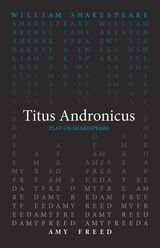 Titus Andronicus
William Shakespeare
Arizona Center for Medieval and Renaissance Studies, 2022 Shakespeare’s tragic story of revenge is reimagined for the twenty-first century.
One of Shakespeare’s goriest plays, Titus Andronicus traces the fall of the Andronicus family in ancient Rome. Clinging to the ways of the past, Titus desperately seeks to remain loyal to the throne as his world crumbles around him. Amy Freed’s translation of Titus Andronicus is careful and meticulous, making small but mighty changes in moments that enhance the drama of each scene. Freed’s version gives this extraordinary play an even faster track on which to run.
This translation of Titus Andronicus was written as part of the Oregon Shakespeare Festival’s Play On! project, which commissioned new translations of thirty-nine Shakespeare plays. These translations present work from “The Bard” in language accessible to modern audiences while never losing the beauty of Shakespeare’s verse. Enlisting the talents of a diverse group of contemporary playwrights, screenwriters, and dramaturges from diverse backgrounds, this project reenvisions Shakespeare for the twenty-first century. These volumes make these works available for the first time in print—a new First Folio for a new era.
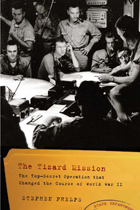 The Tizard Mission: The Top-Secret Operation That Changed the Course of World War II
Stephen Phelps
Westholme Publishing, 2010 Alone Against Germany, Britain Gave America Its Most Astonishing Secrets
In August 1940, a German invasion of Britain looked inevitable. Luftwaffe bombers were pounding British cities, France had surrendered, and the Low Countries were under German control. Although sympathetic to Britain’s plight, the United States remained staunchly neutral. Unknown to the rest of the world, Britain’s brightest scientific and military minds had been working on futuristic technology for a decade, including radar and jet propulsion. While the great value of radar to locate and identify objects at long distance and at night or in bad weather was appreciated, at the time it was thought that practical radar required a room-sized device for generating an effective signal. Now, suddenly, British scientists had something extraordinary—the cavity magnetron, a generator hundreds of times more powerful than any other in use and small enough to be held in the hand. With the British economy and industry reeling from the war, Winston Churchill gambled on an unorthodox plan: a team of scientists and engineers would travel under cover to the United States and give the still-neutral Americans the best of Britain’s military secrets. It was hoped that in exchange the United States would provide financial and manufacturing support—which might even lead to their official entry into the war. The Tizard Mission, named for its leader Sir Henry Tizard, steamed across the Atlantic carrying a suitcase-sized metal deed box. Designed to sink in the event the ship was torpedoed by a U-boat, the box contained details of the Whittle jet engine, research for an atomic bomb, and a precious cavity magnetron. The Americans proved to be astonished, receptive, and efficient: Bell Telephone produced the first thirty magnetrons in October 1940, and over a million by the end of the war. With this device, both warships and aircraft could carry war-winning radar. But Britain did not only give America military secrets, these same technologies would produce a fortune for postwar commercial industries, with the magnetron being the key component to the microwave oven. In The Tizard Mission: The Top-Secret Operation That Changed the Course of World War II, Stephen Phelps reveals how the Tizard Mission was the turning point in the technological war, giving Britain the weapons it desperately needed and laying the groundwork for both the Special Relationship and much of the United States’s postwar economic boom, an effect that still resonates today.
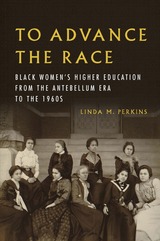 To Advance the Race: Black Women's Higher Education from the Antebellum Era to the 1960s
Linda M. Perkins
University of Illinois Press, 2024 From the United States' earliest days, African Americans considered education essential for their freedom and progress. Linda M. Perkins’s study ranges across educational and geographical settings to tell the stories of Black women and girls as students, professors, and administrators. Beginning with early efforts and the establishment of abolitionist colleges, Perkins follows the history of Black women's post–Civil War experiences at elite white schools and public universities in northern and midwestern states. Their presence in Black institutions like Howard University marked another advancement, as did Black women becoming professors and administrators. But such progress intersected with race and education in the postwar era. As gender questions sparked conflict between educated Black women and Black men, it forced the former to contend with traditional notions of women’s roles even as the 1960s opened educational opportunities for all African Americans. A first of its kind history, To Advance the Race is an enlightening look at African American women and their multi-generational commitment to the ideal of education as a collective achievement.
To Advance their Opportunities: Policies Toward African American Workers from World War I to the Civil Right Act of 1964
Judson MacLaury
University of Tennessee Press, 2008
To Advance Their Opportunities chronicles the development of federal policies and programs impacting African American workers, examining the fascinating and rarely seen workings of federal bureaucracies as they attempted to rein in racism in the nation's federally funded workplaces. The book traces the hard-won gains made by African American workers and the crucial role of the civil rights movement and its supporters in urging the federal government to action. This scholarly and timely work also brings to light the little known story of the birth of affirmative action.
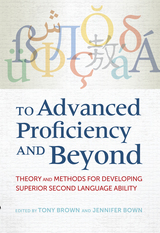 To Advanced Proficiency and Beyond: Theory and Methods for Developing Superior Second Language Ability
Tony Brown and Jennifer Bown, Editors
Georgetown University Press, 2015 To Advanced Proficiency and Beyond: Theory and Methods for Developing Superior Second Language Ability addresses an important issue in Second Language Acquisition—how to help learners progress from Intermediate and Advanced proficiency to Superior and beyond. Due to the pressures of globalization, American society encounters an ever-increasing demand for speakers with advanced language abilities. This volume makes available cutting edge research on working memory and cognition and empirical studies of effective teaching. In addition it can serve as a practical handbook for seasoned and pre-professional instructors alike. The bringing together of the latest in second language acquisition theory, decades of empirical research, and practical classroom application makes for an unprecedented volume examining the achievement of Superior-level foreign language proficiency.
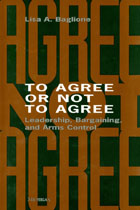 To Agree or Not to Agree: Leadership, Bargaining, and Arms Control
Lisa A. Baglione
University of Michigan Press, 1999 Why were the leaders of the United States and the Soviet Union able to negotiate a series of arms control agreements despite the deep and important differences in their interests during the Cold War? Lisa A. Baglione considers a variety of explanations for the successes--and failures--of these negotiations drawn from international relations theories. Focusing on the goals and strategies of individual leaders--and their ability to make these the goals and strategies of their nation--the author develops a nuanced understanding that better explains the outcome of these negotiations. Baglione then tests her explanation in a consideration of negotiations surrounding the banning of above-ground nuclear tests, the Strategic Arms Limitation Talks of the 1970s, the negotiations for the limitation of intermediate-range nuclear forces in the 1980s, and the last negotiations between the Americans and the disintegrating Soviet Union in 1990 and 1991. How these great rivals were able to negotiate significant arms control agreements not only will shed light on international relations during an important period of history but will help us understand how such agreements might develop in the post-Cold War period, when arms proliferation has become a serious problem.
This book will appeal to scholars of international relations and arms control as well as those interested in bargaining and international negotiations and contemporary military history.
Lisa A. Baglione is Assistant Professor of Political Science, St. Joseph's University.
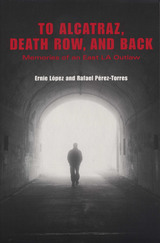 To Alcatraz, Death Row, and Back: Memories of an East LA Outlaw
By Ernie López and Rafael Pérez-Torres
University of Texas Press, 2005 When Ernie López was a boy selling newspapers in Depression-era Los Angeles, his father beat him when he failed to bring home the expected eighty to ninety cents a day. When the beatings became unbearable, he took to petty stealing to make up the difference. As his thefts succeeded, Ernie's sense of necessity got tangled up with ambition and adventure. At thirteen, a joyride in a stolen car led to a sentence in California's harshest juvenile reformatory. The system's failure to show any mercy soon propelled López into a cycle of crime and incarceration that resulted in his spending decades in some of America's most notorious prisons, including four and a half years on death row for a murder López insists he did not commit. To Alcatraz, Death Row, and Back is the personal life story of a man who refused to be broken by either an abusive father or an equally abusive criminal justice system. While López freely admits that "I've been no angel," his insider's account of daily life in Alcatraz and San Quentin graphically reveals the violence, arbitrary infliction of excessive punishment, and unending monotony that give rise to gang cultures within the prisons and practically insure that parolees will commit far worse crimes when they return to the streets. Rafael Pérez-Torres discusses how Ernie López's experiences typify the harsher treatment that ethnic and minority suspects often receive in the American criminal justice system, as well as how they reveal the indomitable resilience of Chicanos/as and their culture. As Pérez-Torres concludes, "López's story presents us with the voice of one who—though subjected to a system meant to destroy his soul—not only endured but survived, and in surviving prevailed."
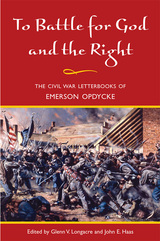 To Battle for God and the Right: The Civil War Letterbooks of Emerson Opdycke
Emerson Opdycke, Ed. by Glenn V. Longacre and John E. Haas.
University of Illinois Press, 2002 Emerson Opdycke, a lieutenant with the 41st Ohio Infantry and later a commander of the 125th Ohio Volunteer Infantry, won fame at the Battle of Franklin when his brigade saved the Union Army from defeat. He also played pivotal roles in some of the major battles of the western theater, including Chickamauga, Chattanooga, and Missionary Ridge. Opdycke's wartime letters to his wife, Lucy, offer the immediacy of the action as it unfolded and provide a glimpse into the day-to-day life of a soldier. Viewing the conflict with the South as a battle between the rights of states and loyalty to the Union, his letters reveal his dislike of slavery, devotion to the Union, disdain for military ineptitude, and opinions of combat strategies and high-ranking officers. A thorough introduction by editors Glenn V. Longacre and John E. Haas and a foreword by Peter Cozzens provide additional historical context and biographical information.
 To Be a Friend of Christ: The Life of Marion D. Hanks
Hanks, Richard D.
Signature Books, 2024 Marion Duff Hanks (1921–2011) was one of the most beloved and influential leaders of the Church of Jesus Christ of Latter-day Saints in the twentieth century, serving as a General Authority (senior leader) for forty years. He was also a leader of national import. As a recognized expert on youth, five US presidents appointed him to their President’s Council on Physical Fitness and Sports. Hanks also served as an executive leader of Rotary International and the Boy Scouts of America. Author Richard Hanks draws on previously unavailable primary sources—journals, correspondence, notebooks, and recordings—to share this first and only authorized biography of his father. Hanks traces his father’s influence as he advocated for numerous changes in the institutional church, including humanitarian efforts, refugee relief services, missionary community service, a focus on mercy for the sinner, and a churchwide emphasis on “coming unto Christ.” A Renaissance man, Duff Hanks felt comfortable mingling with presidents and world leaders and speaking from pulpits and podiums to huge audiences and on television. But he found his greatest joy in assisting the individual, encouraging each in their personal search for happiness. Once, when asked about his goals, he replied, “My strongest desire is to qualify to be a friend of Christ.”
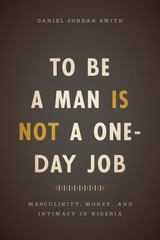 To Be a Man Is Not a One-Day Job: Masculinity, Money, and Intimacy in Nigeria
Daniel Jordan Smith
University of Chicago Press, 2017 Refrains about financial hardship are ubiquitous in contemporary Nigeria, frequently expressed through the idiom “to be a man is not a one-day job.” But while men talk constantly about money, underlying their economic worries are broader concerns about the shifting meanings of masculinity, amid changing expectations and practices of intimacy.
Drawing on twenty-five years of experience in southeastern Nigeria, Daniel Jordan Smith takes readers through the principal phases and arenas of men’s lives: the transition to adulthood; searching for work and making a living; courtship, marriage, and fatherhood; fraternal and political relationships; and finally, the attainment of elder status and death. He relates men’s struggles both to fulfill their own aspirations and to meet society’s expectations. He also considers men who behave badly, mistreat their wives and children, or resort to crime and violence. All of these men face similar challenges as they navigate the complex geometry of money and intimacy. Unraveling these connections, Smith argues, provides us with a deeper understanding of both masculinity and society in Nigeria.
To Be A Slave in Brazil: 1550-1888
Mattoso, Katia M de Queiros
Rutgers University Press, 1986 This book was published originally in French in 1979 and in Portuguese in 1982. Written without scholarly footnotes for a general readership, it is a deceptively simple book direct in its presentation, lacking a specialized jargon, and organized in an imaginative and interesting way. But it also is a volume that reflects some of the most recent and innovative research on the question of slavery. Putting aside the somewhat arid debate over the feudal or capitalist nature of the "slave mode of production" and the political aspects of the movement for abolition, To Be a Slave in Brazil presents an overview of Brazilian slavery which reflects the trend toward study of the slave community, religion, the family, and other features of the internal aspects of slavery.
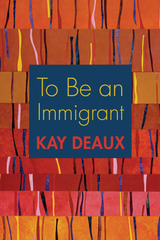 To Be an Immigrant
Kay Deaux
Russell Sage Foundation, 2006 Immigration is often discussed in broad, statistical terms, with a focus on how it affects labor markets, schools, and social services. But at its most basic level, immigration is a process that affects people and their identities in deeply personal ways. In To Be an Immigrant, social psychologist Kay Deaux explores the role of both social conditions and individual capacities in determining how well immigrants adapt to life in their new homelands, and makes a strong case for the relevance of social psychology in immigration studies. To Be an Immigrant looks at how immigrants are defined, shaped, and challenged by the cultural environment they encounter in their new country and offers an integrated psychological framework for studying the immigrant experience. Deaux argues that in addition to looking at macro-level factors like public policies and social conditions and micro-level issues like individual choices, immigration scholars should also study influences that occur on an intermediate level, such as interpersonal encounters. Each of these three levels of analysis is essential to understanding how immigrants adapt to a new homeland and form distinct identities. As a case study for her framework, Deaux examines West Indians, exploring their perceptions of the stereotypes they face in the United States and their feelings of connection to their new home. Though race plays a limited role in the West Indies, it becomes more relevant to migrants once they arrive in the United States, where they are primarily identified by others as black, rather than Guyanese or Jamaican. Deaux's research adds to a growing literature in social psychology on stereotype threat, which suggests that negative stereotypes about one's group can hinder an individual's performance. She finds that immigrants who have been in the United States longer and identify themselves as African American suffer from the negative effects of stereotype threat more than recent immigrants. More than a discrete event, immigration can be understood as a life-long process that continues to affect people well after they have migrated. To Be an Immigrant takes a novel approach to the study of immigration, looking at how societal influences help shape immigrants and their understanding of who they are.
To Be At Music: Essays & Talks
Norma Cole
Omnidawn, 2010 To Be At Music is the first collection of essays by Norma Cole, who is one of our most respected poets writing in the innovative tradition, as well as an esteemed translator and visual artist. These 21 prose pieces reflect her inimitable ability to make the critical essay an art form that engages both the sensual and the cerebral, the aural and the visual, the analytic and the intuitive nature of her readers. Many of these are essays or talks written in response to invitations to discuss the works of writers and artists such as Hans Christian Andersen, Robin Blaser, Edmond Jabès, Mina Loy, Lorine Niedecker, George Oppen, Stanley Whitney, and Christa Wolf. Each offers Cole's unique appreciation of what it means to read, to interact with a work of art, to write, or to translate, and to perceive each activity as a way to attune oneself anew to the world that is both within and beyond our expected methods of understanding.
To Be in This Number
Alane Rollings
Northwestern University Press, 2005 With her fifth book of poetry, Alane Rollings continues to demonstrate her originality and her own poetic style. To Be In This Number shapes personal and national events in 20th Century--America into a narrative which begins before the Depression and ends after 9/11. The historical sweep includes the birth of Jazz, World War II (and antisemitism), the rise of rock music, the civil rights movement, and the expanding women's consciousness. Always keeping in mind the roles of both a national consciousness and the individual, Rollings examines a variety of themes surrounding family, race, and gender relationships to see how they have (or have not) progressed. True to Rollings' courageous style, each poem is part of an unusual journey through poetic narrative, profound emotion, and intimate language.
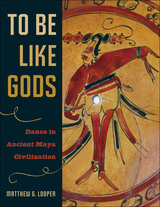 To Be Like Gods: Dance in Ancient Maya Civilization
By Matthew G. Looper
University of Texas Press, 2009 Winner, Association for Latin American Art Book Award, 2010 The Maya of Mexico and Central America have performed ritual dances for more than two millennia. Dance is still an essential component of religious experience today, serving as a medium for communication with the supernatural. During the Late Classic period (AD 600-900), dance assumed additional importance in Maya royal courts through an association with feasting and gift exchange. These performances allowed rulers to forge political alliances and demonstrate their control of trade in luxury goods. The aesthetic values embodied in these performances were closely tied to Maya social structure, expressing notions of gender, rank, and status. Dance was thus not simply entertainment, but was fundamental to ancient Maya notions of social, religious, and political identity. Using an innovative interdisciplinary approach, Matthew Looper examines several types of data relevant to ancient Maya dance, including hieroglyphic texts, pictorial images in diverse media, and architecture. A series of case studies illustrates the application of various analytical methodologies and offers interpretations of the form, meaning, and social significance of dance performance. Although the nuances of movement in Maya dances are impossible to recover, Looper demonstrates that a wealth of other data survives which allows a detailed consideration of many aspects of performance. To Be Like Gods thus provides the first comprehensive interpretation of the role of dance in ancient Maya society and also serves as a model for comparative research in the archaeology of performance.
 To Be Marquette
Sharon Dilworth
Carnegie Mellon University Press, 2024 In this compelling campus novel, a college freshman exposes hidden secrets as she fights for environmental justice in Marquette.
Arriving in Marquette for her freshman year at Northern Michigan University, Molly enrolls in Dr. Robinson’s ecology studies class, hoping to learn more about the natural world and how to protect the planet from human impact. She befriends her classmates, Dr. Robinson’s Crusoes, who share her love of hiking, camping, and building bonfires on the shores of Lake Superior.
Together, Molly and the Crusoes protest the development of Project ELF, a Navy program that is installing a series of extremely low-frequency transmitters across the Great Lakes. The US government claims Project ELF will help the country defend itself in the event of a nuclear invasion, but Upper Peninsula residents fear the communications lines will disrupt the natural environment that they hold sacred.
Initially preoccupied with the contingencies of freshman year—roommate problems, dormitory life, and dating—Molly begins to sense that the Project ELF protests may mask a more problematic dynamic between the students and faculty. As she struggles to find her purpose, Molly uncovers layers of lies and misunderstandings about campus life, Project ELF, and her time in Marquette that make her question her place in the community.
As in other notable campus novels, like Donna Tartt’s The Secret History or Elif Batuman’s The Idiot, Sharon Dilworth’s To Be Marquette portrays an undergraduate narrator groping for meaning in a world where personal transformation takes place alongside conflicting cultural paradigms.
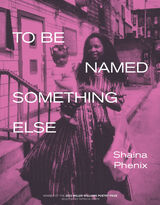 To Be Named Something Else
Shaina Phenix
University of Arkansas Press, 2023 Named one of New York Public Library's Best Books, 2023
Winner, 2023 Miller Williams Poetry Prize To Be Named Something Else is a high-spirited celebration of Black matriarchy and lineage—both familial and literary. Centering the coming-of-age of Black femmes in Harlem, Shaina Phenix’s debut collection, in the words of series judge Patricia Smith: “enlivens the everyday—the everyday miraculous, the everyday hallelujah, the numbing everyday love, the everyday risk of just being Black and living. There is absolutely nowhere these poems aren’t—we’re dancing and sweating through our clothes, terminating a pregnancy in a chilled room of white and silver, finally gettin’ those brows threaded and nails did, practicing gettin’ the Holy Ghost, sending folks to their rest, having babies, listening carefully to the lessons of elders, and sometimes even talking back. . . . To Be Named Something Else is a book of reason and reckoning, substance and shadow. It’s tender and wide-aloud and just about everything we need right now, when both reason and reckoning are in such woefully short supply.” Phenix’s full-throated poetry, with its “superlative combination of formalism and funk,” is assuredly something else.
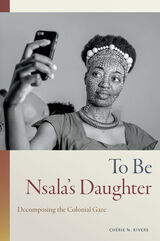 To Be Nsala's Daughter: Decomposing the Colonial Gaze
Chérie N. Rivers
Duke University Press, 2023 In To Be Nsala’s Daughter, Chérie N. Rivers shows how colonial systems of normalized violence condition the way we see and, through collaboration with contemporary Congolese artists, imagines ways we might learn to see differently. Rivers focuses on a photograph of a Congolese man, Nsala, looking at the disembodied hand and foot of his daughter, which were removed as punishment for his failure to deliver the requisite amount of rubber in King Léopold’s Congo. This photograph, taken by British missionary Alice Seeley Harris, featured prominently in abolitionist campaigns to end colonial atrocities in Central Africa in the early twentieth century. But in addition to exposing the visible violence of colonialism, Rivers argues, this photograph also exposes the invisible—and continued—violence of the colonial gaze. With a poetic, personal collage of stories and images, To Be Nsala’s Daughter traces the past and present of the colonial gaze both in Congo and in the author’s lived experience as a mixed-race Black woman in the United States.
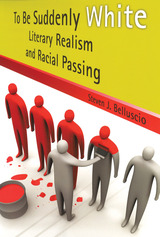 To Be Suddenly White: Literary Realism and Racial Passing
Steven J. Belluscio
University of Missouri Press, 2006 To Be Suddenly White explores the troubled relationship between literary passing and literary realism, the dominant aesthetic motivation behind the late-nineteenth and early-twentieth-century ethnic texts considered in this study. Steven J. Belluscio uses the passing narrative to provide insight into how the representation of ethnic and racial subjectivity served, in part, to counter dominant narratives of difference.
To Be Suddenly White offers new readings of traditional passing narratives from the African American literary tradition, such as James Weldon Johnson’s The Autobiography of an Ex-Coloured Man, Nella Larsen’s Passing, and George Schuyler’s Black No More. It is also the first full-length work to consider a number of Jewish American and Italian American prose texts, such as Mary Antin’s The Promised Land, Anzia Yezierska’s Bread Givers, and Guido d’Agostino’s Olives on the Apple Tree, as racial passing narratives in their own right. Belluscio also demonstrates the contradictions that result from the passing narrative’s exploration of racial subjectivity, racial difference, and race itself.
When they are seen in comparison, ideological differences begin to emerge between African American passing narratives and “white ethnic” (Jewish American and Italian American) passing narratives. According to Belluscio, the former are more likely to engage in a direct critique of ideas of race, while the latter have a tendency to become more simplistic acculturation narratives in which a character moves from a position of ethnic difference to one of full American identity.
The desire “to be suddenly white” serves as a continual point of reference for Belluscio, enabling him to analyze how writers, even when overtly aware of the problematic nature of race (especially African American writers), are also aware of the conditions it creates, the transformations it provokes, and the consequences of both. Byexamining the content and context of these works, Belluscio elucidates their engagement with discourses of racial and ethnic differences, assimilation, passing, and identity, an approach that has profound implications for the understanding of American literary history.
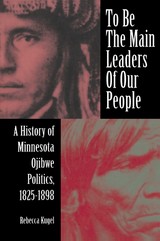 To Be the Main Leaders of Our People: A History of Minnesota Ojibwe Politics, 1825-1898
Rebecca Kugel
Michigan State University Press, 1998 In the spring of 1868, people from several Ojibwe villages located along the upper Mississippi River were relocated to a new reservation at White Earth, more than 100 miles to the west. In many public declarations that accompanied their forced migration, these people appeared to embrace the move, as well as their conversion to Christianity and the new agrarian lifestyle imposed on them. Beneath this surface piety and apparent acceptance of change, however, lay deep and bitter political divisions that were to define fundamental struggles that shaped Ojibwe society for several generations.
In order to reveal the nature and extent of this struggle for legitimacy and authority, To Be The Main Leaders of Our People reconstructs the political and social history of these Minnesota Ojibwe communities between the years 1825 and 1898. Ojibwe political concerns, the thoughts and actions of Ojibwe political leaders, and the operation of the Ojibwe political system define the work's focus. Kugel examines this particular period of time because of its significance to contemporary Ojibwe history. The year 1825, for instance, marked the beginning of a formal alliance with the United States; 1898 represented not an end, but a striking point of continuity, defying the easy categorizations of Native peoples made by non-Indians, especially in the closing years of the nineteenth century.
In this volume, the Ojibwe "speak for themselves," as their words were recorded by government officials, Christian missionaries, fur traders, soldiers, lumbermen, homesteaders, and journalists. While they were nearly always recorded in English translation, Ojibwe thoughts, perceptions, concerns, and even humor, clearly emerge. To Be The Main Leaders of Our People expands the parameters of how oral traditions can be used in historical writing and sheds new light on a complex, but critical, series of events in ongoing relations between Native and non-Native people.
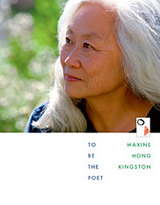 To Be the Poet
Maxine Hong Kingston
Harvard University Press, 2002 "I have almost finished my longbook," Maxine Hong Kingston declares. "Let my life as Poet begin...I won't be a workhorse anymore; I'll be a skylark." To Be the Poet is Kingston's manifesto, the avowal and declaration of a writer who has devoted a good part of her sixty years to writing prose, and who, over the course of this spirited and inspiring book, works out what the rest of her life will be, in poetry. Taking readers along with her, this celebrated writer gathers advice from her gifted contemporaries and from sages, critics, and writers whom she takes as ancestors. She consults her past, her conscience, her time--and puts together a volume at once irreverent and deeply serious, playful and practical, partaking of poetry throughout as it pursues the meaning, the possibility, and the power of the life of the poet.
A manual on inviting poetry, on conjuring the elusive muse, To Be the Poet is also a harvest of poems, from charms recollected out of childhood to bursts of eloquence, wonder, and waggish wit along the way to discovering what it is to be a poet.
 To Become a God: Cosmology, Sacrifice, and Self-Divinization in Early China
Michael J. Puett
Harvard University Press, 2002 Evidence from Shang oracle bones to memorials submitted to Western Han emperors attests to a long-lasting debate in early China over the proper relationship between humans and gods. One pole of the debate saw the human and divine realms as separate and agonistic and encouraged divination to determine the will of the gods and sacrifices to appease and influence them. The opposite pole saw the two realms as related and claimed that humans could achieve divinity and thus control the cosmos. This wide-ranging book reconstructs this debate and places within their contemporary contexts the rival claims concerning the nature of the cosmos and the spirits, the proper demarcation between the human and the divine realms, and the types of power that humans and spirits can exercise.
It is often claimed that the worldview of early China was unproblematically monistic and that hence China had avoided the tensions between gods and humans found in the West. By treating the issues of cosmology, sacrifice, and self-divinization in a historical and comparative framework that attends to the contemporary significance of specific arguments, Michael J. Puett shows that the basic cosmological assumptions of ancient China were the subject of far more debate than is generally thought.
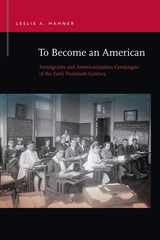 To Become an American: Immigrants and Americanization Campaigns of the Early Twentieth Century
Leslie A. Hahner
Michigan State University Press, 2017 Pledging allegiance, singing the “Star-Spangled Banner,” wearing a flag pin—these are all markers of modern patriotism, emblems that announce the devotion of American citizens. Most of these nationalistic performances were formulized during the early twentieth century and driven to new heights by the panic surrounding national identity during World War I. In To Become an American Leslie A. Hahner argues that, in part, the Americanization movement engendered the transformation of patriotism during this period. Americanization was a massive campaign designed to fashion immigrants into perfect Americans—those who were loyal in word, deed, and heart. The larger outcome of this widespread movement was a dramatic shift in the nation’s understanding of Americanism. Employing a rhetorical lens to analyze the visual and aesthetic practices of Americanization, Hahner contends that Americanization not only tutored students in the practices of citizenship but also created a normative visual metric that modified how Americans would come to understand, interpret, and judge their own patriotism and that of others.
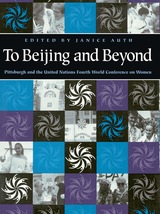 To Beijing and Beyond: Pittsburgh and the United Nations Fourth World Conference on Women
Janice Auth
University of Pittsburgh Press, 1998 Documents 1995 UN Fourth World Conference on Women in Beijing. Forty three essays by men and women who attended the conference tell of their experiences and how they’ve applied what they learned at home.
The words of these college presidents, students, teachers, homemakers, retirees, writers, clergy, and entrepreneurs who participated in the UN Fourth World Conference on Women document the remarkable initiative, energy, and vision of those who began and continue to coordinate the activities of Pittsburgh/Beijing ’95 and Beyond. Auth also offers background information on the three previous UN Women’s Conferences, outlines the work that has been accomplished since the 1995 conference, and the plans for implementing the Beijing Platform for Action at the local level. Her remarks and the stories she has collected offer an intimate portrayal of an historical event that was largely under-reported by popular media. Essential reading for anyone who wants to know what really happened and what they can do now.
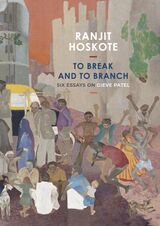 To Break and to Branch: Six Essays on Gieve Patel
Ranjit Hoskote
Seagull Books, 2024 Reflections on the evolution and philosophical depth of Gieve Patel’s art, adorned with illustrations of his paintings.
To Break and to Branch is a collection of six essays on the artist Gieve Patel (1940–2023), written by poet, cultural theorist, and curator Ranjit Hoskote over nearly two decades, gathered together for the first time and accompanied by over fifty illustrations of Patel's paintings. In an introductory essay written especially for this edition, Hoskote looks back over the long friendship he shared with Patel, contextualizing it within the vibrant artistic milieu that was once special to Bombay, their home city: a milieu premised on a mutual curiosity that brought the arts together, hospitable to poetry, painting, theater, cinema, music, and architecture.
Embodying this spirit, Hoskote engages with Patel’s evolving oeuvre as a painter and his experiments with sculpture, while connecting them to his investments in poetry, theater, and his growing philosophical awareness of the more-than-human. Hoskote’s writings trace both the constant preoccupations and the changing interests that gave Patel’s art its distinctive character and reflect on the aesthetic, philosophical, and political dimensions of Patel’s gradual movement from a human-centric understanding of the world to a more holistic view as generated and sustained by interrelationships across orders of being.
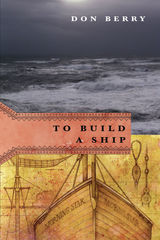 To Build a Ship
Don Berry
Oregon State University Press, 2004 In To Build a Ship, Don Berry explores the extent to which a man can betray himself and his morality for a dream or an obsession. It's the story of a handful of settlers who take up land in the fertile Tillamook Bay Valley in the early 1850s -- defiant dreamers battling the wilderness. With impenetrable mountains at their backs and the open sea as their sole road to trade, they are suddenly isolated from the outside world when the only captain willing to enter their harbor dies. With the survival of their new settlement threatened, they decide to build their own schooner. At first the challenge brings out the best in the men, but soon the tensions inherent in this monumental task engulf them. Obstacles accumulate and complications mount: a death, a murder trial, trouble with restive Indians, and finally a travesty of justice. Excitement, shock, and gripping drama mark this story of men pushed to the point of madness as they see the Morning Star of Tillamook slowly take shape on the wild Pacific shore. Don Berry's three novels about the Oregon Territory — Trask, Moontrap, and To Build a Ship — are as rich and compelling today as when they were first published more than 40 years ago. The new OSU Press editions of these books include an introduction by Jeff Baker, former book critic for The Oregonian.
To Can the Kaiser: Arkansas and the Great War
Michael D. Polston
Butler Center for Arkansas Studies, 2015 On April 2, 1917, the United States officially entered a war that had been raging for nearly three years in Europe. Even though America’s involvement in the “Great War” lasted little more than a year and a half, the changes it wrought were profound. More than seventy thousand Arkansans served as soldiers during the war. Wartime propaganda led to suspicions directed against Germans, Jehovah’s Witnesses, and African Americans in Arkansas, but war production proved a boon to the state in the form of greater demand for cotton, minerals, and timber. World War I connected Arkansas to the world in ways that changed the state and its people forever, as shown in the essays collected here.
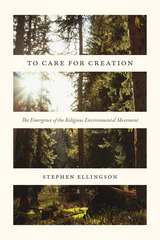 To Care for Creation: The Emergence of the Religious Environmental Movement
Stephen Ellingson
University of Chicago Press, 2016 Controversial megachurch pastor Mark Driscoll proclaimed from a conference stage in 2013, “I know who made the environment and he’s coming back and going to burn it all up. So yes, I drive an SUV.” The comment, which Driscoll later explained away as a joke, highlights what has been a long history of religious anti-environmentalism. Given how firmly entrenched this sentiment has been, surprising inroads have been made by a new movement with few financial resources, which is deeply committed to promoting green religious traditions and creating a new environmental ethic.
To Care for Creation chronicles this movement and explains how it has emerged despite institutional and cultural barriers, as well as the hurdles posed by logic and practices that set religious environmental organizations apart from the secular movement. Ellingson takes a deep dive into the ways entrepreneurial activists tap into and improvise on a variety of theological, ethical, and symbolic traditions in order to issue a compelling call to arms that mobilizes religious audiences. Drawing on interviews with the leaders of more than sixty of these organizations, Ellingson deftly illustrates how activists borrow and rework resources from various traditions to create new meanings for religion, nature, and the religious person’s duty to the natural world.
 To Care for the Sick and Bury the Dead: African American Lodges and Cemeteries in Tennessee
Leigh Ann Gardner
Vanderbilt University Press, 2022 Benevolent Orders, the Sons of Ham, Prince Hall Freemasons—these and other African American lodges created a social safety net for members across Tennessee. During their heyday between 1865 and 1930, these groups provided members with numerous resources, such as sick benefits and assurance of a proper burial, opportunities for socialization and leadership, and the chance to work with local churches and schools to create better communities. Many of these groups gradually faded from existence, but their legacy endures in the form of the cemeteries the lodges left behind.
These Black cemeteries dot the Tennessee landscape, but few know their history or the societies of care they represent. To Care for the Sick and Bury the Dead is the first book-length look at these cemeteries and the lodges that fostered them.
This book is a must-have for genealogists, historians, and family members of the people buried in these cemeteries.
 To Catch a Spy: The Art of Counterintelligence
James M. Olson, Former Chief of CIA Counterintelligence
Georgetown University Press, 2019 How the US is losing the counterintelligence war and what the country should do to better protect our national security and trade secrets The United States is losing the counterintelligence war. Foreign intelligence services, particularly those of China, Russia, and Cuba, are recruiting spies in our midst and stealing our secrets and cutting-edge technologies. In To Catch a Spy: The Art of Counterintelligence, James M. Olson, former chief of CIA counterintelligence, offers a wake-up call for the American public and also a guide for how our country can do a better job of protecting its national security and trade secrets. Olson takes the reader into the arcane world of counterintelligence as he lived it during his thirty-year career in the CIA. After an overview of what the Chinese, Russian, and Cuban spy services are doing to the United States, Olson explains the nitty-gritty of the principles and methods of counterintelligence. Readers will learn about specific aspects of counterintelligence such as running double-agent operations and surveillance. The book also analyzes twelve real-world case studies to illustrate why people spy against their country, the tradecraft of counterintelligence, and where counterintelligence breaks down or succeeds. A “lessons learned” section follows each case study.
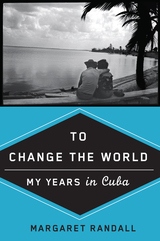 To Change the World: My Years in Cuba
Randall, Margaret
Rutgers University Press, 2009 In To Change the World, the legendary writer and poet Margaret Randall chronicles her decade in Cuba from 1969 to 1980. Both a highly personal memoir and an examination of the revolution's great achievements and painful mistakes, the book paints a portrait of the island during a difficult, dramatic, and exciting time. Randall gives readers an inside look at her children's education, the process through which new law was enacted, the ins and outs of healthcare, employment, internationalism, culture, and ordinary people's lives. She explores issues of censorship and repression, describing how Cuban writers and artists faced them. She recounts one of the country's last beauty pageants, shows us a night of People's Court, and takes us with her when she shops for her family's food rations. Key figures of the revolution appear throughout, and Randall reveals aspects of their lives never before seen. More than fifty black and white photographs, most by the author, add depth and richness to this astute and illuminating memoir. Written with a poet's ear, depicted with a photographer's eye, and filled with a feminist vision, To Change the Worldùneither an apology nor gratuitous attackùadds immensely to the existing literature on revolutionary Cuba.
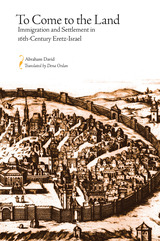 To Come to the Land: Immigration and Settlement in 16th-Century Eretz-Israel
Abraham David, translated by Dena Ordan
University of Alabama Press, 1999
To Come to the Land makes available in English a vast body of research,
previously available only in Hebrew, on the early history of the land now
known as Israel.
Abraham David here focuses on the Spanish and Portuguese Jews who fled
the Iberian Peninsula during the 16th century, tracing the beginnings of
Sephardic influence in the land of Israel. After the Ottoman Turks conquered Syria, Palestine, and Egypt in 1516,
the Ottoman regime, unlike their Mamluk predecessors, encouraged economic
development and settlement throughout the region. This openness to immigration
offered a solution to the crisis Iberian Jews were undergoing as a result
of their expulsion from Spain and the forced conversions in Portugal. Within
a few years of the Ottoman conquest, Jews of Spanish extraction, many of
them clustered in urban areas, dominated the Jewish communities of Eretz-Israel. In this carefully researched study, David examines the lasting impression
made by these enterprising Jewish settlers on the commercial, social, and
intellectual life of the area under early Ottoman rule. Of particular interest
is his examination of the cities of Jerusalem and Safed and David's succinct
biographies of leading Jewish personalities throughout the region. This first English translation of a ground-breaking Hebrew work provides
a comprehensive overview of a significant chapter in the history of Israel
and explores some of the factors that brought to it the best minds of the
age. Essential for scholars of late Medieval Jewish history, To Come to
the Land will also be an important resource for scholars of intellectual
history, as it provides background crucial to an understanding of the intellectual
flourishing of the period.
To Command the Sky: The Battle for Air Superiority Over Germany, 1942-1944
Stephen L. McFarland and Wesley Phillips Newton
University of Alabama Press, 2006 To Command the Sky is a scholarly record of the fight for domination of the skies over western Europe during World War II. It also explains the technical details of the tactics used to defeat the Luftwaffe. This book is important for serious students of World War II or military aviation.
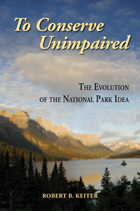 To Conserve Unimpaired: The Evolution of the National Park Idea
Robert B Keiter
Island Press, 2013 When the national park system was first established in 1916, the goal "to conserve unimpaired" seemed straightforward. But Robert Keiter argues that parks have always served a variety of competing purposes, from wildlife protection and scientific discovery to tourism and commercial development. In this trenchant analysis, he explains how parks must be managed more effectively to meet increasing demands in the face of climate, environmental, and demographic changes. Taking a topical approach, Keiter traces the history of the national park idea from its inception to its uncertain future. Thematic chapters explore our changing conceptions of the parks as wilderness sanctuaries, playgrounds, educational facilities, and more. He also examines key controversies that have shaped the parks and our perception of them. Ultimately, Keiter demonstrates that parks cannot be treated as special islands, but must be managed as the critical cores of larger ecosystems. Only when the National Park Service works with surrounding areas can the parks meet critical habitat, large-scale connectivity, clean air and water needs, and also provide sanctuaries where people can experience nature. Today's mandate must remain to conserve unimpaired—but Keiter shows how the national park idea can and must go much farther. Professionals, students, and scholars with an interest in environmental history, national parks, and federal land management, as well as scientists and managers working on adaptation to climate change should find the book useful and inspiring.
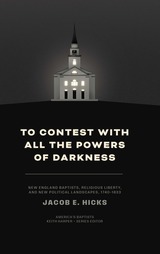 To Contest with All the Powers of Darkness: New England Baptists, Religious Liberty, and New Political Landscapes, 1740–1833
Jacob E. Hicks
University of Tennessee Press, 2024 In this new history of the New England Baptists, Jacob E. Hicks teases out the social and political contexts that transformed “rustic” young men like John Leland not only into volunteers for Christ—as wide-roving preachers in the mold of George Whitefield—but also into influential opinion leaders, media entrepreneurs, networkers, and lobbyists in the contentious First Party era of the Early Republic.
Baptist leaders like Isaac Backus, Noah Alden, Samuel Stillman, John Leland, Jonathan Going, and Luther Rice exploited their church-based ministerial training in public speaking, conflict resolution, and intra-denominational networking to become political organizers. With significant gains in the formation of the Warren Association (1767), the Backus-led Grievance Committee (1769), and Leland’s formative experience in the campaign to disestablish Virginia (1780s), the Baptists allied themselves with the rising Democratic-Republican Party, touching off a coalition of anti-Federalist politics and evangelical religion that, while not directly disestablishing Massachusetts, would bear significant fruit in the Religious Freedom Act of 1811.
To Contest with All the Powers of Darkness brings a unique movement into focus that had at its inception the communal values and ministry preparation practices of a loose network of New England Baptist churches. This movement drove a significant first wedge in the church-state fusion of the Early Republic and, simultaneously, left memorable lessons in successful collective action for a New England Baptist community on the verge of an institutional explosion on the western frontier.
To Dance is Human: A Theory of Nonverbal Communication
Judith Lynne Hanna
University of Chicago Press, 1987 Exploring dance from the rural villages of Africa to the stages of Lincoln Center, Judith Lynne Hanna shows that it is as human to dance as it is to learn, to build, or to fight. Dance is human thought and feeling expressed through the body: it is at once organized physical movement, language, and a system of rules appropriate in different social situations. Hanna offers a theory of dance, drawing on work in anthropology, semiotics, sociology, communications, folklore, political science, religion, and psychology as well as the visual and performing arts. A new preface provides commentary on recent developments in dance research and an updated bibliography.
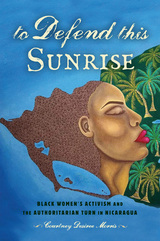 To Defend This Sunrise: Black Women’s Activism and the Authoritarian Turn in Nicaragua
Courtney Desiree Morris
Rutgers University Press, 2023 To Defend this Sunrise examines how black women on the Caribbean coast of Nicaragua engage in regional, national, and transnational modes of activism to remap the nation’s racial order under conditions of increasing economic precarity and autocracy. The book considers how, since the 19th century, black women activists have resisted historical and contemporary patterns of racialized state violence, economic exclusion, territorial dispossession, and political repression. Specifically, it explores how the new Sandinista state under Daniel Ortega and Rosario Murillo has utilized multicultural rhetoric as a mode of political, economic, and territorial dispossession. In the face of the Sandinista state’s co-optation of multicultural discourse and growing authoritarianism, black communities have had to recalibrate their activist strategies and modes of critique to resist these new forms of “multicultural dispossession.” This concept describes the ways that state actors and institutions drain multiculturalism of its radical, transformative potential by espousing the rhetoric of democratic recognition while simultaneously supporting illiberal practices and policies that undermine black political demands and weaken the legal frameworks that provide the basis for the claims of these activists against the state.
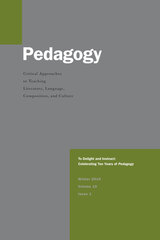 To Delight and Instruct: Celebrating Ten Years of Pedagogy, Volume 10
Jennifer L. Holberg and Marcy Taylor, eds.
Duke University Press This issue considers the sustainability of English studies and of the humanities as a whole in the context of shrinking budgets and job opportunities and of shifting resources. Exploring topics from academic freedom and globalization to digitization, diversity, and the value of a humanities-based education, “To Delight and Instruct” reexamines the work of the English professor and calls for a reassessment of the priorities and means that undergird it. Contributors examine the faculty’s fundamental responsibilities to classroom teaching, the university, and the community. Attending to the relationship between changing technologies and literacy in a global environment, the issue not only argues for a reassertion and reimagining of the humanities in the contemporary university but, perhaps as important, helps articulate a way forward. Contributors: Michael Bérubé, Martin Bickman, Marc Bousquet, Elizabeth Brockman, Sheila T. Cavanagh, Danielle Nicole DeVoss, Patricia Donahue, Gerald Graff, Donald E. Hall, Gail E. Hawisher, Jennifer L. Holberg, Colin Jager, Paul Lauter, Shirley Geok-lin Lim, Julie Lindquist, Harriet Kramer Linkin, Mark C. Long, Donald G. Marshall, Richard E. Miller, James Phelan, Mariolina Rizzi Salvatori, Robert Scholes, Cynthia L. Selfe, Marcy Taylor
To Destroy Painting
Louis Marin
University of Chicago Press, 1994 The work of the eminent French cultural critic Louis Marin (1931-92) is becoming increasingly important to English-speaking scholars concerned with issues of representation. To Destroy Painting, first published in France in 1977, marks a milestone in Marin's thought about the aims of painting in Europe in the sixteenth and seventeenth centuries. A meditation on the work of Poussin and Caravaggio and on their milieux, the book explores a number of notions implied by theories of painting and offers insight into the aims and effects of visual representaion.
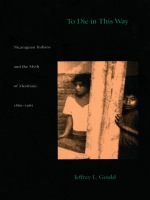 To Die in this Way: Nicaraguan Indians and the Myth of Mestizaje, 1880-1965
Jeffrey L. Gould
Duke University Press, 1998 Challenging the widely held belief that Nicaragua has been ethnically homogeneous since the nineteenth century, To Die in This Way reveals the continued existence and importance of an officially “forgotten” indigenous culture. Jeffrey L. Gould argues that mestizaje—a cultural homogeneity that has been hailed as a cornerstone of Nicaraguan national identity—involved a decades-long process of myth building. Through interviews with indigenous peoples and records of the elite discourse that suppressed the expression of cultural differences and rationalized the destruction of Indian communities, Gould tells a story of cultural loss. Land expropriation and coerced labor led to cultural alienation that shamed the indigenous population into shedding their language, religion, and dress. Beginning with the 1870s, Gould historicizes the forces that prompted a collective movement away from a strong identification with indigenous cultural heritage to an “acceptance” of a national mixed-race identity. By recovering a significant part of Nicaraguan history that has been excised from the national memory, To Die in This Way critiques the enterprise of third world nation-building and thus marks an important step in the study of Latin American culture and history that will also interest anthropologists and students of social and cultural historians.
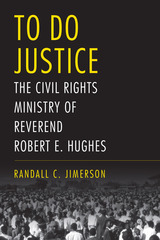 To Do Justice: The Civil Rights Ministry of Reverend Robert E. Hughes
Randall C. Jimerson
University of Alabama Press, 2022 Biography of a civil rights activist who worked tirelessly at the heart of two social and political revolutions
A native Alabamian, Reverend Robert E. Hughes worked full-time in the civil rights movement as executive director of the Alabama Council of Human Relations, where he developed a close relationship with Dr. Martin Luther King Jr. After facing backlash from the Ku Klux Klan, spending four days in jail for refusing to disclose ACHR membership lists, and ultimately being forced to leave the state of Alabama, he served as a Methodist missionary in Southern Rhodesia (now part of Zimbabwe). After two years of organizing Black liberation groups, he was banned as a “prohibited immigrant” by the Ian Smith government. His lifelong commitment to social justice, racial equality, and peaceful resolution of conflicts marks a fascinating career richly documented in this comprehensive biography.
To Do Justice: The Civil Rights Ministry of Reverend Robert E. Hughes traces the life and career of an admirable and lesser-known civil rights figure who fought injustice on two continents. This account presents valuable new evidence about the civil rights movement in the United States as well as human rights and liberation issues in colonial Southern Rhodesia in the years leading up to independence and self-rule. It provides an intimate portrait of a courageous individual who worked outside of the public spotlight but provided essential support and informational resources to public activists and news reporters
.
Randall C. Jimerson explores the interwoven threads of race relations and religious beliefs on two continents, focusing on the dual themes of the American civil rights movement and the African struggles for decolonization and majority rule. The life and career of Robert Hughes provide insight into the international dimensions of racial prejudice and discrimination that can be viewed in comparative context to similar oppressions in other colonial lands.
 To Embody the Marvelous: The Making of Illusions in Early Modern Spain
Esther Fernández
Vanderbilt University Press, 2021 Winner of the Vern Williamsen Comedia Book Prize, Association for Hispanic Classical Theater, 2023
Winner of the Nancy Staub Award, UNIMA-USA (Union Internationale de la Marionnette), 2023
In its exploration of puppetry and animation as the performative media of choice for mastering the art of illusion, To Embody the Marvelous engages with early modern notions of wonder in religious, artistic, and social contexts.
From jointed, wood-carved figures of Christ, saintly marionettes that performed hagiographical dramas, experimental puppets and automata in Cervantes' Don Quixote, and the mechanical sets around which playwright Calderón de la Barca devised secular magic shows to deconstruct superstitions, these historical and fictional artifacts reenvisioned religious, artistic, and social notions that led early modern society to critically wrestle with enchantment and disenchantment.
The use of animated performance objects in Spanish theatrical contexts during the sixteenth and seventeenth centuries became one of the most effective pedagogical means to engage with civil society. Regardless of social strata, readers and spectators alike were caught up in a paradigm shift wherein belief systems were increasingly governed by reason—even though the discursive primacy of supernatural doxa and Christian wonder remained firmly entrenched. Thanks to their potential for motion, religious and profane puppets, automata, and mechanical stage props deployed a rationalized sense of wonder that illustrates the relationship between faith and reason, reevaluates the boundaries of fiction in art and entertainment cultures, acknowledges the rise of science and technology, and questions normative authority.
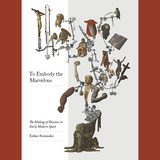 To Embody the Marvelous: The Making of Illusions in Early Modern Spain
Esther Fernández
Vanderbilt University Press, 2022 Winner of the Vern Williamsen Comedia Book Prize, Association for Hispanic Classical Theater, 2023
Winner of the Nancy Staub Award, UNIMA-USA (Union Internationale de la Marionnette), 2023
In its exploration of puppetry and animation as the performative media of choice for mastering the art of illusion, To Embody the Marvelous engages with early modern notions of wonder in religious, artistic, and social contexts.
From jointed, wood-carved figures of Christ, saintly marionettes that performed hagiographical dramas, experimental puppets and automata in Cervantes' Don Quixote, and the mechanical sets around which playwright Calderón de la Barca devised secular magic shows to deconstruct superstitions, these historical and fictional artifacts reenvisioned religious, artistic, and social notions that led early modern society to critically wrestle with enchantment and disenchantment.
The use of animated performance objects in Spanish theatrical contexts during the sixteenth and seventeenth centuries became one of the most effective pedagogical means to engage with civil society. Regardless of social strata, readers and spectators alike were caught up in a paradigm shift wherein belief systems were increasingly governed by reason—even though the discursive primacy of supernatural doxa and Christian wonder remained firmly entrenched. Thanks to their potential for motion, religious and profane puppets, automata, and mechanical stage props deployed a rationalized sense of wonder that illustrates the relationship between faith and reason, reevaluates the boundaries of fiction in art and entertainment cultures, acknowledges the rise of science and technology, and questions normative authority.
To End the Arms Race
David Rittenhouse Inglis
University of Michigan Press, 1986 Since participating in the original development of the atomic bomb at Los Alamos over forty years ago, David Inglis has written more than sixty articles on various aspects of the subject. These articles not only provide a useful background for specific issues of the arms race, but also point out missed opportunities for making our future safer and the major obstacles in reaching any agreements in arms reduction. This book is built around selections from those articles.
 To Exercise Our Talents: The Democratization of Writing in Britain
Christopher Hilliard
Harvard University Press, 2006 In twentieth-century Britain the literary landscape underwent a fundamental change. Aspiring authors--traditionally drawn from privileged social backgrounds--now included factory workers writing amid chaotic home lives, and married women joining writers' clubs in search of creative outlets. In this brilliantly conceived book, Christopher Hilliard reveals the extraordinary history of "ordinary" voices.
Writing as an organized pursuit emerged in the 1920s, complete with clubs, magazines, guidebooks, and correspondence schools. The magazine The Writer helped coordinate a network of "writers' circles" throughout Britain that offered prospective authors--especially women--outside the educated London elite a forum in which to discuss writing. The legacy of Wordsworth and other English Romantics encouraged the belief that would-be authors should write about what they knew personally--that art flowed from genuine experience and technique was of secondary importance. The 1930s saw a boom in the publication of so-called proletarian writing, working-class men writing "in my own language about my own people," as Birmingham writer Leslie Halward put it. During World War II, soldiers turned to poetry to cope with the trauma of war, and the popular magazine Seven promoted the idea that anyone, regardless of social background, could be a creative writer. Self-expression became a democratic right.
In capturing the creative lives of ordinary people--would-be fiction-writers and poets who until now have left scarcely a mark on written history--Hilliard sensitively reconstructs the literary culture of a democratic age.
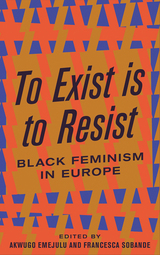 To Exist is to Resist: Black Feminism in Europe
Edited by Akwugo Emejulu and Francesca Sobande
Pluto Press, 2019 This book brings together activists, artists and scholars of colour to show how Black feminism and Afrofeminism are being practiced in Europe today, exploring their differing social positions in various countries, and how they organise and mobilise to imagine a Black feminist Europe.
Deeply aware that they are constructed as 'Others' living in a racialised and hierarchical continent, the contibutors explore gender, class, sexuality and legal status to show that they are both invisible - presumed to be absent from and irrelevant to European societies - and hyper-visible - assumed to be passive and sexualised, angry and irrational.
Through imagining a future outside the neocolonial frames and practices of contemporary Europe, this book explores a variety of critical spaces including motherhood and the home, friendships and intimate relationships, activism and community, and literature, dance and film.
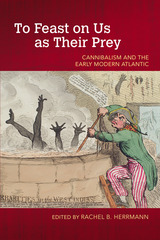 To Feast on Us as Their Prey: Cannibalism and the Early Modern Atlantic
Rachel B. Herrmann
University of Arkansas Press, 2019 Winner, 2020 Association for the Study of Food and Society Book Award, Edited Volume Long before the founding of the Jamestown, Virginia, colony and its Starving Time of 1609–1610—one of the most famous cannibalism narratives in North American colonial history—cannibalism played an important role in shaping the human relationship to food, hunger, and moral outrage. Why did colonial invaders go out of their way to accuse women of cannibalism? What challenges did Spaniards face in trying to explain Eucharist rites to Native peoples? What roles did preconceived notions about non-Europeans play in inflating accounts of cannibalism in Christopher Columbus’s reports as they moved through Italian merchant circles? Asking questions such as these and exploring what it meant to accuse someone of eating people as well as how cannibalism rumors facilitated slavery and the rise of empires, To Feast on Us as Their Prey posits that it is impossible to separate histories of cannibalism from the role food and hunger have played in the colonization efforts that shaped our modern world.
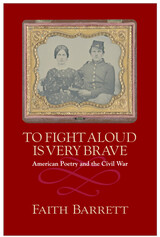 To Fight Aloud Is Very Brave: American Poetry and the Civil War
Faith Barrett
University of Massachusetts Press, 2012 Focusing on literary and popular poets, as well as work by women, African Americans, and soldiers, this book considers how writers used poetry to articulate their relationships to family, community, and nation during the Civil War. Faith Barrett suggests that the nationalist "we" and the personal "I" are not opposed in this era; rather they are related positions on a continuous spectrum of potential stances. For example, while Julia Ward Howe became famous for her "Battle Hymn of the Republic," in an earlier poem titled "The Lyric I" she struggles to negotiate her relationship to domestic, aesthetic, and political stances.
Barrett makes the case that Americans on both sides of the struggle believed that poetry had an important role to play in defining national identity. She considers how poets created a platform from which they could speak both to their own families and local communities and to the nations of the Confederacy, the Union, and the United States. She argues that the Civil War changed the way American poets addressed their audiences and that Civil War poetry changed the way Americans understood their relationship to the nation.
To Find a Pasqueflower: A Story of the Tallgrass Prairie
Greg Hoch
University of Iowa Press, 2022 The tallgrass prairie once stretched from Indiana to Kansas to Minnesota. Most of this land is now growing corn and soybeans. In To Find a Pasqueflower, Greg Hoch shows us that the tallgrass prairie is the most endangered ecosystem on the continent, but it’s also an ecosystem that people can play an active role in restoring.
Hoch blends history, culture, and science into a unified narrative of the tallgrass prairie, with an emphasis on humans’ participation in its development and destruction. Hoch also demonstrates how variable and dynamic the prairie is, creating both challenges and opportunities for those who manage and restore and appreciate it.
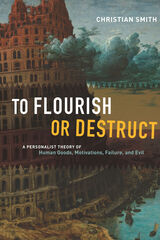 To Flourish or Destruct: A Personalist Theory of Human Goods, Motivations, Failure, and Evil
Christian Smith
University of Chicago Press, 2015
In his 2010 book What Is a Person?, Christian Smith argued that sociology had for too long neglected this fundamental question. Prevailing social theories, he wrote, do not adequately “capture our deep subjective experience as persons, crucial dimensions of the richness of our own lived lives, what thinkers in previous ages might have called our ‘souls’ or ‘hearts.’” Building on Smith’s previous work, To Flourish or Destruct examines the motivations intrinsic to this subjective experience: Why do people do what they do? How can we explain the activity that gives rise to all human social life and social structures?
Smith argues that our actions stem from a motivation to realize what he calls natural human goods: ends that are, by nature, constitutionally good for all human beings. He goes on to explore the ways we can and do fail to realize these ends—a failure that can result in varying gradations of evil. Rooted in critical realism and informed by work in philosophy, psychology, and other fields, Smith’s ambitious book situates the idea of personhood at the center of our attempts to understand how we might shape good human lives and societies.
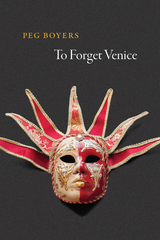 To Forget Venice
Peg Boyers
University of Chicago Press, 2014 To Forget Venice is the improbable challenge and the title of Peg Boyers’s newest collection of poems. The site of several unforgettable years of her adolescence, the place she has returned to more frequently than any other, the city of Venice is both adored and reviled by the speakers in this varied and unconventionally polyphonic work. The voices we hear in these poems belong not only to characters like the mother of Tadzio (think Death in Venice), or the companion of Vladimir Ilych Lenin, or the Victorian prophet John Ruskin and his wife, Effie, but also to wall moss, and sand, and—most especially—an authorial speaker who in 1965, at age thirteen, landed in Venice and never quite recovered from the formative experiences that shaped her there. Ranging over several stages of a life that features adolescent heartbreak and betrayal, marriage and children, friendship and loss, the book insistently addresses the author’s desire to get to the bottom of her obsession with a place that has imprinted itself so profoundly on her consciousness.
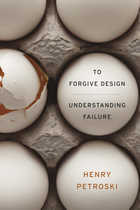 To Forgive Design: Understanding Failure
Henry Petroski
Harvard University Press, 2012 When planes crash, bridges collapse, and automobile gas tanks explode, we are quick to blame poor design. But Henry Petroski says we must look beyond design for causes and corrections. Known for his masterly explanations of engineering successes and failures, Petroski here takes his analysis a step further, to consider the larger context in which accidents occur.
In To Forgive Design he surveys some of the most infamous failures of our time, from the 2007 Minneapolis bridge collapse and the toppling of a massive Shanghai apartment building in 2009 to Boston's prolonged Big Dig and the 2010 Gulf oil spill. These avoidable disasters reveal the interdependency of people and machines within systems whose complex behavior was undreamt of by their designers, until it was too late. Petroski shows that even the simplest technology is embedded in cultural and socioeconomic constraints, complications, and contradictions.
Failure to imagine the possibility of failure is the most profound mistake engineers can make. Software developers realized this early on and looked outside their young field, to structural engineering, as they sought a historical perspective to help them identify their own potential mistakes. By explaining the interconnectedness of technology and culture and the dangers that can emerge from complexity, Petroski demonstrates that we would all do well to follow their lead.
To Foster the Spirit of Professionalism: Southern Scientists and State Academies of Science
Nancy Smith Midgette
University of Alabama Press, 1991 "A welcome contribution to the history of science in the South during the period since the Civil War. . . . By considering the academies in the larger context of scientific professionalism, South and North, Midgette has produced a surprisingly wide-ranging and informative study. This is overall a judicious and carefully researched work. The writing is straightforward and admirably clear, while the topic is effectively organized and presented. The book is a commendably original addition to local and regional history as well as history of American Science."
—Journal of American History
"Midgette’s study is thorough and well organized and should be consulted by anyone interested in American science and American higher education."
—Florida Historical Quarterly
"A very useful survey."
—Choice
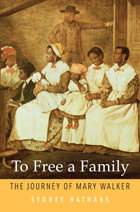 To Free a Family: The Journey of Mary Walker
Sydney Nathans
Harvard University Press, 2013 What was it like for a mother to flee slavery, leaving her children behind? To Free a Family tells the remarkable story of Mary Walker, who in August 1848 fled her owner for refuge in the North and spent the next seventeen years trying to recover her family. Her freedom, like that of thousands who escaped from bondage, came at a great price—remorse at parting without a word, fear for her family’s fate.
This story is anchored in two extraordinary collections of letters and diaries, that of her former North Carolina slaveholders and that of the northern family—Susan and Peter Lesley—who protected and employed her. Sydney Nathans’s sensitive and penetrating narrative reveals Mary Walker’s remarkable persistence as well as the sustained collaboration of black and white abolitionists who assisted her. Mary Walker and the Lesleys ventured half a dozen attempts at liberation, from ransom to ruse to rescue, until the end of the Civil War reunited Mary Walker with her son and daughter.
Unlike her more famous counterparts—Harriet Tubman, Harriet Jacobs, and Sojourner Truth—who wrote their own narratives and whose public defiance made them heroines, Mary Walker’s efforts were protracted, wrenching, and private. Her odyssey was more representative of women refugees from bondage who labored secretly and behind the scenes to reclaim their families from the South. In recreating Mary Walker’s journey, To Free a Family gives voice to their hidden epic of emancipation and to an untold story of the Civil War era.
To Give Their Gifts: Health, Community, and Democracy
Richard A. Couto
Vanderbilt University Press, 2002 Democracy needs the extraordinary efforts of ordinary people. The experiences of the twelve creative community health leaders, which this book presents, provide excellent examples of innovative democratic leadership. To Give Their Gifts recaptures the neglected narratives of democracy. It places community and mutual responsibility for one another at the center of democratic leadership, explains health care as social justice, and asserts the belief that everyone has the "gifts"--and the right--to contribute to community.
To Go Into the Words
Norman Finkelstein
University of Michigan Press, 2023 To Go Into the Words is the latest book of critical prose from renowned poet and scholar of Jewish literature Norman Finkelstein. Through a rigorous examination of poets such as William Bronk, Helen Adam, and Nathaniel Mackey, the book engages the contemporary poetic fascination with transcendence through the radical delight with language. By opening up a given poem, Finkelstein seeks the “gnosis” or insight of what it contains so that other readers can understand and appreciate the works even more. Pulling from Finkelstein’s experience of writing thirteen books of poetry and six books of literary criticism, To Go Into the Words consistently rewards the reader with insights as transformative as they are well-considered and deftly mapped out. This volume opens the world of poetry to poets, scholars, and readers by showcasing “the gnosis that is to be found in modern poetry.”
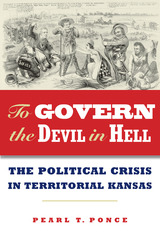 To Govern the Devil in Hell: The Political Crisis of Territorial Kansas
Pearl T. Ponce
Northern Illinois University Press, 2014 One hundred and fifty years after Kansas was admitted to the Union, we still find ourselves fascinated by the specter of “Bleeding Kansas” and the violence that preceded the American Civil War by five years. Although ample attention has been devoted to understanding why territorial violence broke out in Kansas in 1856, of equal concern but less illuminated is the question of why government, both local and national, allowed the violence to continue unstanched for so long. This question is fundamentally about governance—its existence, exercise, limits, and continuance—and its study has ramifications for understanding both Kansas events and why the American experiment in government failed in 1861. In addition, the book also sheds light on the nature of democracy, the challenges of implanting it in distant environs, the necessity of cooperation at the various levels of government, and the value of strong leadership.
To Govern the Devil in Hell uses the prism of governance to investigate what went wrong in territorial Kansas. From the first elections in late 1854 and early 1855, local government was tarnished with cries of illegitimacy that territorial officials could not ameliorate. Soon after, a shadow government was created which further impeded local management of territorial challenges. Ultimately, this book addresses why Presidents Franklin Pierce and James Buchanan failed to act, what hindered Congress from stepping into the void, and why and how the lack of effective governance harmed Kansas and later the United States.
To Have and Have Not
Edited by Bruce F. Kawin; Tino T. Balio, Series Editor
University of Wisconsin Press, 1980 The story of the making of To Have and Have Not (1944) is an exciting and complex one, ranging from the widely reported romance between its stars, Humphrey Bogart and the unknown nineteen-year old Lauren Bacall, to one of the more subtle developments in the wartime alliance between the United States and the Batista regime in Cuba. Bruce F. Kawin's substantial and informed introduction reflects this excitement while explaining the complexities, helping all film scholars, students, and buffs to gain a fuller appreciation of one of Hollywood's most memoriable melodramas.
This is a story also of a collaboration amoung four important writers: Ernest Hemingway, Howard Hawks, Jules Furthman, and William Faulkner.
 To Have and To Hit: CULTURAL PERSPECTIVES ON WIFE BEATING
Edited by Dorothy Ayers Counts, Judith K. Brown, and Jacquelyn C. Campbell
University of Illinois Press, 1999 This vitally important volume places the problem of wife beating in a broad cultural context in a search for strategies to reform societies, including our own, that are prone to this pernicious form of violence. Based on first hand ethnographic data on more than a dozen societies, including a number in Oceania, this collection explores the social and cultural factors that work either to inhibit or to promote domestic violence against women. The volume also includes a study of abuse among nonhuman primates and a cross-cultural analysis of the legal aspects of wife beating. By presenting counterexamples from other cultures, contributors challenge Western assumptions about the factors leading to wife beating. Through a close examination of societies where wife beating is infrequent or absent, To Have and To Hit identifies the factors—economic, social, political, and cultural—that must be explored and transformed in order to combat this violence and eventually eliminate it.
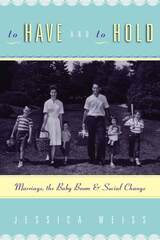 To Have and to Hold: Marriage, the Baby Boom, and Social Change
Jessica Weiss
University of Chicago Press, 2000 Middle-class family life in the 1950s brings to mind images of either smugly satisfied or miserably repressed nuclear families with breadwinning husbands, children, and housewives, much like the families depicted in Ozzie and Harriet and Father Knows Best.
Jessica Weiss delves beneath these mythic images and paints a far more complex picture that reveals strong continuities between the baby boomers and their parents. Drawing on interviews with American couples from the 1950s to the 1980s, Weiss creates a dynamic portrait of family and social change in the postwar era. She pairs these firsthand accounts with a deft analysis of movies, television shows, magazines, and advice books from each decade, providing an unprecedented and intimate look at ordinary marriages in a time of sweeping cultural change.
Weiss shows how young couples in the 1950s attempted to combine egalitarian hopes with traditional gender roles. Middle-class women encouraged their husbands to become involved fathers. Midlife wives and mothers reshaped the labor force and the home by returning to work in the 1960s. And couples strove for fulfilling marriages as they dealt with the pressures of childrearing in the midst of the sexual and divorce revolutions of the 1960s and 1970s. By the 1980s, they were far more welcoming to the ideas of the women's movement than has often been assumed. More than simply changing with the times, the parents of the baby boom contributed to changing times themselves.
Weiss's excellent use of family interviews that span three decades, her imaginative examination of popular culture, and her incisive conclusions make her book an invaluable contribution not only to our understanding of the past but also to our understanding of men's and women's roles in today's family.
"Weiss has written an enlightening book that examines the dynamics of American families past and present. . . . Since Weiss is a historian, she provides analyses of her arguments that are factual rather than emotive, and her use of family interviews further contributes to a strong presentation. Overall, this is a unique works because its multidisciplinary approach informs but never preaches on the emotionally charged topic of the American family.—Sheila Devaney, Library Journal
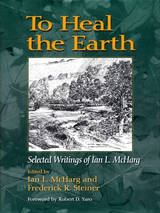 To Heal the Earth: Selected Writings of Ian L. McHarg
Ian L. McHarg; Edited by Frederick R. Steiner; Foreword by Robert D. Yaro
Island Press, 2007 Ian L. McHarg's landmark book Design with Nature changed the face of landscape architecture and planning by promoting the idea that the design of human settlements should be based on ecological principles. McHarg was one of the earliest and most influential proponents of the notion that an understanding of the processes that form landscapes should underlie design decisions. In To Heal the Earth, McHarg has joined with Frederick Steiner, a noted scholar of landscape architecture and planning, to bring forth a valuable cache of his writings produced between the 1950s and the 1990s. McHarg and Steiner have each provided original material that links the writings together, and places them within the historical context of planning design work and within the larger field of ecological planning as practiced today. The book moves from the theoretical-beginning with the 1962 essay "Man and Environment" which sets forth the themes of religion, science, and creativity that emerge and reappear throughout McHarg's work -- to the practical, including discussions of methods and techniques for ecological planning as well as case studies. Other sections address the link between ecology and design, and the issue of ecological planning at a regional scale, covering topics such as education and training necessary to develop the field of ecological planning, how to organize and arrange biophysical information to reveal landscape patterns, the importance of incorporating social factors into ecological planning, and more. To Heal the Earth provides a larger framework and a new perspective on McHarg's work that brings to light the growth and development of his key ideas over a forty year period. It is an important contribution to the literature, and will be essential reading for students and scholars of ecological planning, as well as for professional planners and landscape architects.
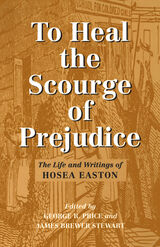 To Heal the Scourge of Prejudice: The Life and Writings of Hosea Easton
Hosea Easton
University of Massachusetts Press, 1999 How did racial prejudice originate and why has it been so deeply rooted in American culture? What have been the long-term effects of prejudice on the intellectual, communal, and psychological resources of African Americans? How might the nightmare of racial domination be truly brought to an end? Still pertinent today, these were among the key questions addressed more than a century and a half ago by Hosea Easton (1799–1837), an important yet long neglected activist and intellectual. A black minister from New England, Easton rose to prominence during the 1820s and 1830s by joining in the struggle of free African Americans to resist southern slavery and secure racial equality. From this experience he developed a deep understanding of the problem of "race" in the United States and became a trenchant critic of white supremacy and its devastating consequences. This volume brings back into print the only extended writings of Easton that have survived into our time: his insightful, almost prescient A Treatise on the Intellectual Character, and the Civil and Political Condition of the Colored People of the U. States, first published in 1837; and his passionate 1828 Thanksgiving Day "Address." The book also provides a biographical portrait of Easton and his family, drawn from primary documents as well as secondary sources in the areas of biography, genealogy, and social history.
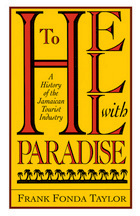 To Hell With Paradise: A History Of The Jamaican Tourist Industry
Frank Fonda Taylor
University of Pittsburgh Press, 2003
In the course of the nineteenth century, Jamaica transformed itself from a pestilence-ridden “white man’s graveyard” to a sun-drenched tourist paradise. Deftly combining economics with political and cultural history, Frank Fonda Taylor examines this puzzling about-face and explores the growth of the tourist industry into the 1990s. He argues that the transformations in image and reality were not accidental or due simply to nature’s bounty. They were the result of a conscious decision to develop this aspect of Jamaica’s economy.
Jamaican tourism emerged formally at an international exhibition held on the island in 1891. The international tourist industry, based on the need to take a break from stressful labor and recuperate in healthful and luxurious surroundings, was a newly awakened economic giant. A group of Jamaican entrepreneurs saw its potential and began to cultivate a tourism psychology which has led, more than one hundred years later, to an economy dependent upon the tourist industry.
The steamships that carried North American tourists to Jamaican resorts also carried U.S. prejudices against people of color. “To Hell withParadise” illustrates the problems of founding a tourist industry for a European or U.S. clientele in a society where the mass of the population is poor, black, and with a historical experience of slavery and colonialism. By the 1990s, tourism had become the lifeblood of the Jamaican economy, but at an enormous cost: enclaves of privilege and ostentation that exclude the bulk of the local population, drug trafficking and prostitution, soaring prices, and environmental degradation. No wonder some Jamaicans regard tourism as a new kind of sugar.
Taylor explores timely issues that have not been previously addressed. Along the way, he offers a series of valuable micro histories of the Jamaican planter class, the origins of agricultural dependency (on bananas), the growth of shipping and communications links, the process of race relations, and the linking of infrastructural development to tourism. The text is illustrated with period photographs of steamships and Jamaican tourist hotels.
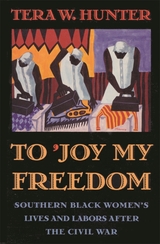 To ’Joy My Freedom: Southern Black Women’s Lives and Labors after the Civil War
Tera W. Hunter
Harvard University Press, 1998 As the Civil War drew to a close, newly emancipated black women workers made their way to Atlanta—the economic hub of the newly emerging urban and industrial south—in order to build an independent and free life on the rubble of their enslaved past. In an original and dramatic work of scholarship, Tera Hunter traces their lives in the postbellum era and reveals the centrality of their labors to the African-American struggle for freedom and justice. Household laborers and washerwomen were constrained by their employers’ domestic worlds but constructed their own world of work, play, negotiation, resistance, and community organization.
Hunter follows African-American working women from their newfound optimism and hope at the end of the Civil War to their struggles as free domestic laborers in the homes of their former masters. We witness their drive as they build neighborhoods and networks and their energy as they enjoy leisure hours in dance halls and clubs. We learn of their militance and the way they resisted efforts to keep them economically depressed and medically victimized. Finally, we understand the despair and defeat provoked by Jim Crow laws and segregation and how they spurred large numbers of black laboring women to migrate north.
Hunter weaves a rich and diverse tapestry of the culture and experience of black women workers in the post–Civil War south. Through anecdote and data, analysis and interpretation, she manages to penetrate African-American life and labor and to reveal the centrality of women at the inception—and at the heart—of the new south.
 To Keep and Bear Arms: The Origins of an Anglo-American Right
Joyce Lee Malcolm
Harvard University Press, 1994 Joyce Malcolm illuminates the historical facts underlying the current passionate debate about gun-related violence, the Brady Bill, and the NRA, revealing the original meaning and intentions behind the individual right to “bear arms.” Few on either side of the Atlantic realize that this extraordinary, controversial, and least understood liberty was a direct legacy of English law. This book explains how the Englishmen’s hazardous duty evolved into a right, and how it was transferred to America and transformed into the Second Amendment.
Malcolm’s story begins in turbulent seventeenth-century England. She shows why English subjects, led by the governing classes, decided that such a dangerous public freedom as bearing arms was necessary. Entangled in the narrative are shifting notions of the connections between individual ownership of weapons and limited government, private weapons and social status, the citizen army and the professional army, and obedience and resistance, as well as ideas about civilian control of the sword and self-defense. The results add to our knowledge of English life, politics, and constitutional development, and present a historical analysis of a controversial Anglo-American legacy, a legacy that resonates loudly in America today.
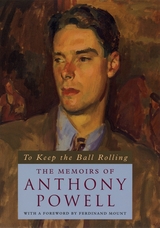 To Keep the Ball Rolling: The Memoirs of Anthony Powell
Anthony Powell
University of Chicago Press, 2001 To earn the reputation of a literary giant within the generation of Waugh, Orwell, and Greene is no mean feat. To do so with the grace and genius that characterized Anthony Powell—whose twelve-volume A Dance to the Music of Time is possibly the only English-language work to match the majestic scope of Proust's Remembrance of Things Past—is nothing short of spectacular. Yet Powell himself remains absent from his writing; he was, said the New York Times, "a writer of mordant succinctness who rewards the reader while revealing little of himself."
Powell did eventually reveal himself in four volumes of memoirs, published between 1976 and 1982. This edition of Anthony Powell's Memoirs is an abridged and revised version of those volumes, a version that has never before been published in this form in the United States. The result is not only a fascinating view of Powell as a man and an author but also a unique history of British literary society and the social elite Powell lampooned and moved within from the twenties through the eighties. From Eton and Oxford to his life as a novelist and critic, Powell observes all—the obscenity trial sparked by Lady Chatterley's Lover; Shirley Temple's libel suit after Graham Greene reviewed Wee Willie Winkie "with even more than his usual verve"—and paints vivid portraits of Kingsley Amis, V.S. Naipaul, T.S. Eliot, Virginia Woolf, and countless others. Most importantly, Powell's lively memoirs banish all thought of the man as a relic of the British gentry. He was a modernist, a Tory, and more than a little interested in genealogy and peerage, but a man who, according to Ferdinand Mount, "miraculously knew what life was like."
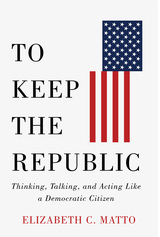 To Keep the Republic: Thinking, Talking, and Acting Like a Democratic Citizen
Elizabeth C. Matto
Rutgers University Press, 2024 American democracy is at an inflection point. With voting rights challenged, election results undermined, and even the US Capitol violently attacked, many Americans feel powerless to save their nation’s democratic institutions from the forces dismantling them. Yet, as founders like Benjamin Franklin knew from the start, the health of America’s democracy depends on the actions its citizens are willing to take to preserve it.
To Keep the Republic is a wake-up call about the responsibilities that come with being a citizen in a participatory democracy. It describes the many ways that individuals can make a difference on both local and national levels—and explains why they matter. Political scientist Elizabeth C. Matto highlights the multiple facets of democratic citizenship, identifies American democracy’s sometimes competing values and ideals, and explains how civic engagement can take various forms, including political conversation. Combining political philosophy with concrete suggestions for how to become a more engaged citizen, To Keep the Republic reminds us that democracy is not a spectator sport; it only works when we get off the sidelines and enter the political arena to make our voices heard.
To Know a Starry Night
Paul Bogard
University of Nevada Press, 2021 Combining the lyrical writing from Paul Bogard with night-sky photography from Beau Rogers, To Know A Starry Night explores the powerful experience of being outside under a natural starry sky.
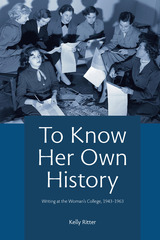 To Know Her Own History: Writing at the Woman’s College, 1943–1963
Kelly Ritter
University of Pittsburgh Press, 2012
To Know Her Own History chronicles the evolution of writing programs at a landmark Southern women’s college during the postwar period. Kelly Ritter finds that despite its conservative Southern culture and vocational roots, the Woman’s College of the University of North Carolina was a unique setting where advanced writing programs and creativity flourished long before these trends emerged nationally.
Ritter profiles the history of the Woman’s College, first as a normal school, where women trained as teachers with an emphasis on composition and analytical writing, then as a liberal arts college. She compares the burgeoning writing program here to those of the Seven Sisters (Wellesley, Smith, Radcliffe, Barnard, Vassar, Bryn Mawr, and Mount Holyoke) and to elite all-male universities, to show the singular progressivism of the Woman’s College. Ritter presents lively student writing samples from the early postwar period to reveal a blurring of the boundaries between “creative” and “expository” styles.
By midcentury, a quantum shift toward creative writing changed administrators’ valuation of composition courses and staff at the Woman’s College. An intensive process of curricular revisions, modeled after Harvard’s “Redbook” plan, was proposed and rejected in 1951, as the college stood by its unique curricula and singular values. Ritter follows the plight of individual instructors of creative writing and composition, showing how their compensation and standing were made disproportionate by the shifting position of expository writing in relation to creative writing. Despite this unsettled period, the Woman’s College continued to gain in stature, and by 1964 it became a prize acquisition of the University of North Carolina system.
Ritter’s study demonstrates the value of local histories to uncover undocumented advancements in writing education, offering insights into the political, cultural, and social conditions that influenced learning and methodologies at “marginalized” schools such as the Woman’s College.
 To Let the Sun
John Allen Taylor
University of Arkansas Press, 2025 Finalist, 2025 Miller Williams Poetry Prize John Allen Taylor’s debut poetry collection To Let the Sun opens with an invitation both generous and resolute: “take a walk with me . . . I hope you’ll come / though I am going anyway.” These poems peel back the layers of recovery as an adult from childhood sexual abuse, the myriad ways a body can change to protect itself from memory, and the difficulty of looking at abuse head-on. Taylor uses a poetics of reclamation to write the child-self from a perspective beyond trauma, to document the messiness of survival, the child’s flight from himself, and the uncertain path home—to a life filled with small and perfect things. Through hermit crabs and golden pothos, fungal gnats and beet seed, the speaker reclaims himself: “I am not lost . . . I know memory / is not healed by time, but / by the oddities / with which we adorn our lives, / the fragilities we need to know / we’re needed by.
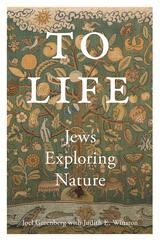 To Life: Jews Exploring Nature
Joel Greenberg
Rutgers University Press, 2026 There have been few if any books on Jewish people who studied the various facets of natural history. There have certainly been those who have done so in the past and in the current world there are many but, for a host of reasons, natural history as a career or serious avocation was much less common in the past. To Life: Jews Exploring Nature offers a unique exploration of Jewish engagement with nature through compelling biographies of eight selected subjects, including infamous ornithologist Nathan Leopold, and intrepid agronomist and spy Aaron Aaronsohn, among others. These individuals, scientists, naturalists, and explorers among them, manifested different aspects of Jewish identity and made significant contributions to their fields. The accounts place the contributions of this diverse mix of individuals into a rich biographical context that connects the personal with the professional, thus providing insights into their lives and work.
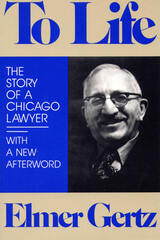 To Life: The Story of a Chicago Lawyer
Elmer Gertz
Southern Illinois University Press, 1990
Elmer Gertz has defended famous people—including Henry Miller, Nathan Leopold, and Jack Ruby—and he has become famous in his own right through his struggle for civil liberties and personal rights.
Gertz has taken on a lengthy list of cases and causes over the six decades of his legal career. He fought successfully against the censorship of Henry Miller’s book Tropic of Cancer,which had been banned in Chicago for obscenity. He got Nathan Leopold released from prison after Leopold had served 34 years for his part in the death of 14-year-old Bobby Franks. An ardent foe of the death penalty, Gertz labored for years as part of a national team of lawyers that was finally able to overturn Jack Ruby’s death sentence for the murder of Lee Harvey Oswald. Gertz’s cases have helped make libel law in the nation.
For this edition, Gertz adds an afterword that covers the 15 years since the book’s first publication. Gertz talks of Henry Miller’s last days and his travels to the USSR on behalf of the Refuseniks.
 To Live and Defy in LA: How Gangsta Rap Changed America
Felicia Angeja Viator
Harvard University Press, 2020 How gangsta rap shocked America, made millions, and pulled back the curtain on an urban crisis.
How is it that gangsta rap—so dystopian that it struck aspiring Brooklyn rapper and future superstar Jay-Z as “over the top”—was born in Los Angeles, the home of Hollywood, surf, and sun? In the Reagan era, hip-hop was understood to be the music of the inner city and, with rare exception, of New York. Rap was considered the poetry of the street, and it was thought to breed in close quarters, the product of dilapidated tenements, crime-infested housing projects, and graffiti-covered subway cars. To many in the industry, LA was certainly not hard-edged and urban enough to generate authentic hip-hop; a new brand of black rebel music could never come from La-La Land.
But it did. In To Live and Defy in LA, Felicia Viator tells the story of the young black men who built gangsta rap and changed LA and the world. She takes readers into South Central, Compton, Long Beach, and Watts two decades after the long hot summer of 1965. This was the world of crack cocaine, street gangs, and Daryl Gates, and it was the environment in which rappers such as Ice Cube, Dr. Dre, and Eazy-E came of age.
By the end of the 1980s, these self-styled “ghetto reporters” had fought their way onto the nation’s radio and TV stations and thus into America’s consciousness, mocking law-and-order crusaders, exposing police brutality, outraging both feminists and traditionalists with their often retrograde treatment of sex and gender, and demanding that America confront an urban crisis too often ignored.
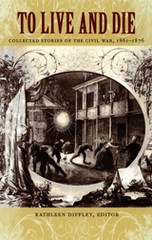 To Live and Die: Collected Stories of the Civil War, 1861–1876
Kathleen Diffley, ed.
Duke University Press, 2002 Even before the first cannonballs were fired at Fort Sumter, American writers were trying to make creative sense of the War Between the States. These thirty-one stories were culled from hundreds that circulated in popular magazines between 1861 and the celebration of the American centennial in 1876. Arranged to echo the sequence of the unfolding drama of the war and Reconstruction, together these short stories constitute an “inadvertent novel,” a collective narrative about a domestic crisis that was still ongoing as the stories were being written and published.
The authors, who include Louisa May Alcott and Mark Twain, depict the horrors of the battlefield, the suffering in prison camps and field hospitals, and the privations of the home front. In these pages, bushwhackers carry the war to out-of-the-way homesteads, spies work households from the inside, journeying paymasters rely on the kindness of border women, and soldiers turn out to be girls. The stories are populated with nurses, officers, speculators, preachers, slaves, and black troops, and they take place in cities, along the frontier, and on battlefields from Shiloh to Gettysburg.
The book opens with a prewar vigilante attack on the Underground Railroad and a Kansas parson in Henry King’s “The Cabin at Pharoah’s Ford” and concludes with an ex-slave recalling the loss of her remaining son in Twain’s “A True Story.” In between are stories written by both women and men that were published in magazines from the South and West as well as the culturally dominant Northeast. Wartime wood engravings highlight the text. Kathleen Diffley’s introduction provides literary and historical background, and her commentary introduces readers to magazine authors as well as the deepening disruptions of a country at war.
Just as they did for nineteenth-century readers, these stories will bring the war home to contemporary readers, giving shape to a crisis that rocked the nation then and continues to haunt it now.
To Live and Die in America: Class, Power, Health and Healthcare
Robert Chernomas and Ian Hudson
Pluto Press, 2013 To Live and Die in America details how the United States has among the worst indicators of health in the industrialised world and at the same time spends significantly more on its health care system than any other industrial nation.
Robert Chernomas and Ian Hudson explain this contradictory phenomenon as the product of the unique brand of capitalism that has developed in the US. It is this particular form of capitalism that created both the social and economic conditions that largely influence health outcomes and the inefficient, unpopular and inaccessible health care system that is incapable of dealing with them.
The authors argue that improving health in America requires a change in the conditions in which people live and work as well as a restructured health care system.
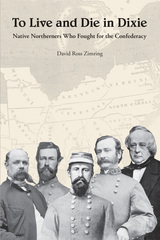 To Live and Die in Dixie: Native Northerners Who Fought for the Confederacy
David Zimring
University of Tennessee Press, 2015 According to the 1860 census, nearly 350,000 native northerners resided in a southern state by the time of the Civil War. Although northern in birth and upbringing, many of these men and women identified with their adopted section once they moved south. In this innovative study, David Ross Zimring examines what motivated these Americans to change sections, support (or not) the Confederate cause, and, in many cases, rise to considerable influence in their new homeland. By analyzing the lives of northern emigrants in the South, Zimring deepens our understanding of the nature of sectional identity as well as the strength of Confederate nationalism.
Focusing on a representative sample of emigrants, Zimring identifies two subgroups: “adoptive southerners,” individuals born and raised in a state above the Mason-Dixon line but who but did not necessarily join the Confederacy after they moved south, and “Northern Confederates,” emigrants who sided with the Confederacy during the Civil War. After analyzing statistical data on states of origin, age, education, decade of migration, and, most importantly, the reasons why these individuals embarked for the South in the first place, Zimring goes on to explore the prewar lives of adoptive southerners, the adaptations they made with regard to slavery, and the factors that influenced their allegiances during the secession crisis. He also analyzes their contributions to the Confederate military and home front, the emergence of their Confederate identities and nationalism, their experiences as prisoners of war in the North, and the reactions they elicited from native southerners.
In tracing these journeys from native northerner to Confederate veteran, this book reveals not only the complex transformations of adoptive southerners but also the flexibility of sectional and national identity before the war and the loss of that flexibility in its aftermath. To Live and Die in Dixie is a thought-provoking work that provides a novel perspective on the revolutionary changes the Civil War unleashed on American society.
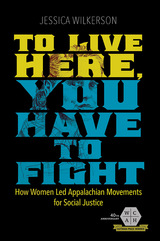 To Live Here, You Have to Fight: How Women Led Appalachian Movements for Social Justice
Jessica Wilkerson
University of Illinois Press, 2019 Launched in 1964, the War on Poverty quickly took aim at the coalfields of southern Appalachia. There, the federal government found unexpected allies among working-class white women devoted to a local tradition of citizen caregiving and seasoned by decades of activism and community service. Jessica Wilkerson tells their stories within the larger drama of efforts to enact change in the 1960s and 1970s. She shows white Appalachian women acting as leaders and soldiers in a grassroots war on poverty--shaping and sustaining programs, engaging in ideological debates, offering fresh visions of democratic participation, and facing personal political struggles. Their insistence that caregiving was valuable labor clashed with entrenched attitudes and rising criticisms of welfare. Their persistence, meanwhile, brought them into unlikely coalitions with black women, disabled miners, and others to fight for causes that ranged from poor people's rights to community health to unionization. Inspiring yet sobering, To Live Here, You Have to Fight reveals Appalachian women as the indomitable caregivers of a region--and overlooked actors in the movements that defined their time.
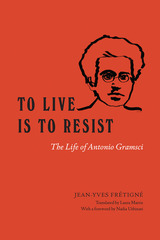 To Live Is to Resist: The Life of Antonio Gramsci
Jean-Yves Frétigné
University of Chicago Press, 2021 This in-depth biography of Italian intellectual Antonio Gramsci casts new light on his life and writing, emphasizing his unflagging spirit, even in the many years he spent in prison.
One of the most influential political thinkers of the twentieth century, Antonio Gramsci (1891–1937) has left an indelible mark on philosophy and critical theory. His innovative work on history, society, power, and the state has influenced several generations of readers and political activists, and even shaped important developments in postcolonial thought. But Gramsci’s thinking is scattered across the thousands of notebook pages he wrote while he was imprisoned by Italy’s fascist government from 1926 until shortly before his death.
To guide readers through Gramsci’s life and works, historian Jean-Yves Frétigné offers To Live Is to Resist, an accessible, compelling, and deeply researched portrait of an extraordinary figure. Throughout the book, Frétigné emphasizes Gramsci’s quiet heroism and his unwavering commitment to political practice and resistance. Most powerfully, he shows how Gramsci never surrendered, even in conditions that stripped him of all power—except, of course, the power to think.
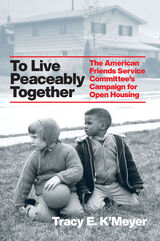 To Live Peaceably Together: The American Friends Service Committee's Campaign for Open Housing
Tracy E. K'Meyer
University of Chicago Press, 2022 A groundbreaking look at how a predominantly white faith-based group reset the terms of the fight to integrate US cities.
The bitterly tangled webs of race and housing in the postwar United States hardly suffer from a lack of scholarly attention. But Tracy K’Meyer’s To Live Peaceably Together delivers something truly new to the field: a lively examination of a predominantly white faith-based group—the Quaker-aligned American Friends Service Committee (AFSC)—that took a unique and ultimately influential approach to cultivating wider acceptance of residential integration. Built upon detailed stories of AFSC activists and the obstacles they encountered in their work in Chicago, Philadelphia, and Richmond, California, To Live Peaceably Together is an engaging and timely account of how the organization allied itself to a cause that demanded constant learning, reassessment, and self-critique. K’Meyer details the spiritual and humanist motivations behind the AFSC, its members’ shifting strategies as they came to better understand structural inequality, and how those strategies were eventually adopted by a variety of other groups. Her fine-grained investigation of the cultural ramifications of housing struggles provides a fresh look at the last seventy years of racial activism.
 To Live Peaceably Together: The American Friends Service Committee's Campaign for Open Housing
Tracy E. K'Meyer
University of Chicago Press, 2022 This is an auto-narrated audiobook edition of this book. A groundbreaking look at how a predominantly white faith-based group reset the terms of the fight to integrate US cities.
The bitterly tangled webs of race and housing in the postwar United States hardly suffer from a lack of scholarly attention. But Tracy K’Meyer’s To Live Peaceably Together delivers something truly new to the field: a lively examination of a predominantly white faith-based group—the Quaker-aligned American Friends Service Committee (AFSC)—that took a unique and ultimately influential approach to cultivating wider acceptance of residential integration. Built upon detailed stories of AFSC activists and the obstacles they encountered in their work in Chicago, Philadelphia, and Richmond, California, To Live Peaceably Together is an engaging and timely account of how the organization allied itself to a cause that demanded constant learning, reassessment, and self-critique. K’Meyer details the spiritual and humanist motivations behind the AFSC, its members’ shifting strategies as they came to better understand structural inequality, and how those strategies were eventually adopted by a variety of other groups. Her fine-grained investigation of the cultural ramifications of housing struggles provides a fresh look at the last seventy years of racial activism.
 To Lose a War: Memories of a German Girl
Regina Maria Shelton
Southern Illinois University Press, 1982
Martin Blumenson refers to this book as a “sensitive, beautifully written personal memoir,” and calls it a contribution to understanding, “particularly to Americans who know little of how World War II and its immediate aftermath disrupted the lives of those who survived the defeat of Germany.”
Vividly, humanly, Shelton tells her story from the point of view of a teen-age German girl, one who witnessed her country’s surge to power and who felt the ignominy of both Germany and Germans after the fall. She reaches a point during the war when “Sometimes the way we now live seems unreal, as if we were marionettes, with orders and permits and schedules attached to us instead of strings.”
But after the defeat of Germany life gets considerably worse. The victorious Russians evict the natives from their homes. They sneer and leer at the women who must venture forth for food. In this defeated land “the nights become unbearably long; without any physical activity by day, sleep refuses to come. I yearn for sleep, be it temporary or eternal. Death is becoming a friend; the enemy has a new name now: Rape.”
Then comes the dreaded order to evacuate all Germans from Lower Silesia: “How can a whole people be uprooted, disowned, tossed aside like useless flotsam—how? With the stroke of a pen, with a new line drawn on a map, we are sentenced to homelessness.” Not knowing where they will be sent, they plod out into darkness and cold with the other Germans, their worldly goods reduced to what they can carry. Embittered, they are herded into vermin-infested freight cars, still unaware of their destination.
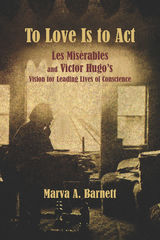 To Love Is to Act: Les Misérables and Victor Hugo’s Vision for Leading Lives of Conscience
Marva A. Barnett
Swan Isle Press, 2019 “To love is to act”— “Aimer, c’est agir.” These words, which Victor Hugo wrote three days before he died, epitomize his life’s philosophy. His love of freedom, democracy, and all people—especially the poor and wretched—drove him not only to write his epic Les Misérables but also to follow his conscience. We have much to learn from Hugo, who battled for justice, lobbied against slavery and the death penalty, and fought for the rights of women and children. In a series of essays that interweave Hugo’s life with Les Misérables and point to the novel’s contemporary relevance, To Love Is to Act explores how Hugo reveals his guiding principles for life, including his belief in the redemptive power of love and forgiveness. Enriching the book are insights from artists who captured the novel’s heart in the famed musical, Les Mis creators Alain Boublil and Claude-Michel Schönberg, producer of the musical Les Misérables Cameron Mackintosh, film director Tom Hooper, and award-winning actors who have portrayed Jean Valjean: Colm Wilkinson and Hugh Jackman.
To Love the Wind and the Rain: African Americans and Environmental History
Dianne D. Glave
University of Pittsburgh Press, 2005 “To Love the Wind and the Rain” is a groundbreaking and vivid analysis of the relationship between African Americans and the environment in U.S. history. It focuses on three major themes: African Americans in the rural environment, African Americans in the urban and suburban environments, and African Americans and the notion of environmental justice. Meticulously researched, the essays cover subjects including slavery, hunting, gardening, religion, the turpentine industry, outdoor recreation, women, and politics. “To Love the Wind and the Rain” will serve as an excellent foundation for future studies in African American environmental history.
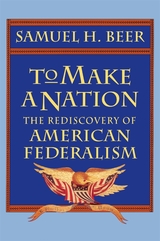 To Make a Nation: The Rediscovery of American Federalism
Samuel H. Beer
Harvard University Press, 1993 Lyndon Johnson heralded a “new federalism,” as did Ronald Reagan. It was left to the public to puzzle out what such a proclamation, coming from both ends of the political spectrum, could possibly mean. Of one thing we can be certain: theories of federalism, in whatever form they take, are still shaping our nation. The origin of these theories—what they meant to history and how they apply today—becomes clear in this book by one of our most distinguished writers on political thought.
The great English republicans of the seventeenth century appear in this story along with their American descendants, who took the European idea of a federal republic and recast it as new and unique. Samuel Beer’s extraordinary knowledge of European political thought, displayed especially in discussions of Thomas Aquinas and James Harrington, allows him to show at every turn the historical precedents and the originality of American federalism in theory and practice. In deft comparisons with Hume, Burke, Blackstone, and Montesquieu, the familiar figures of Madison and Hamilton emerge with new substance and depth, while some who would seem fully known by now, such as Ben Franklin, reveal unsuspected dimensions, and others, such as James Wilson, are lifted from obscurity.
Beer uses this history to highlight the contrast between the nation-centered federalism of the framers of the Constitution and the state-centered federalism of its opponents. His concern is not only with historical origins but, more important, with a conflict of ideas which reaches far into our history and continues on to this day. The result is the clearest articulation ever given of the provenance and purpose of the ideas of nationalism and federalism in American political philosophy. A masterpiece of historical and political analysis, this book provides an innovative interpretive framework for understanding democracy and the American Constitution.
 To Make a World Safe for Revolution: Cuba’s Foreign Policy
Jorge I. Domínguez
Harvard University Press, 1989 The twentieth-century history of Cuba borders on fantasy. This diminutive country boldly and repeatedly exercises the foreign policy of a major power. Although closely tied to the United States through most of its modern history, Cuba successfully defied the U.S. government after 1959, consolidated its own power, and defeated an invasion of U.S.-backed exiles at the Bay of Pigs in 1961. Fidel Castro then brought the world alarmingly close to nuclear war in 1962.
Jorge Domínguez presents a comprehensive survey of Cuban international relations since Castro came to power. Domínguez unravels Cuba’s response to the 1962 missile crisis and the U.S.–Soviet understandings that emerged from that. He explores the ties that link Cuba to the U.S.S.R. and other Communist countries; analyzes Cuban support for revolutionary movements throughout the world, especially in Latin America and Africa; and assesses the significance of Cuban political and economic relations with Western Europe, Canada, and Japan.
Some have charged that Cuba does not have a foreign policy, that Fidel Castro merely takes orders from his Soviet bosses. Domínguez argues that there is indeed a specifically Cuban foreign policy, poised not only between hegemony and autonomy, between compliance and self-assertion, but also between militancy and pragmatism. He believes that within the context of Soviet hegemony Cuba’s foreign policy is very much its own, and he marshals impressive evidence to support this belief. His book is based on extensive documentation from Cuba, the United States, and other countries, as well as from many in-depth interviews carried out during trips to Cuba.
 To Make My Bread
Grace Lumpkin
University of Illinois Press, 1959 A story of the growth of the
new South, To Make My Bread revolves around a family of Appalachian
mountaineers—small farmers, hunters, and moonshiners—driven
by economic conditions to the milltown and transformed into millhands,
strikers, and rebels against the established order. Recognized as one
of the major works on the Gastonia textile strike, Grace Lumpkin's novel
is also important for anyone interested in cultural or feminist history
as it deals with early generations of women radicals committed to addressing
the difficult connections of class and race. Suzanne Sowinska's introduction
looks at Lumpkin's volatile career and this book's critical reception.
Originally published in 1932
"[The book's] meaning
rises out of people in dramatic conflict with other people and with the
conditions of their life. . . . [Lumpkin] treats her theme with a craftsman's
and a psychologist's respect. The novel springs naturally from its author's
immersion in and personal knowledge of her absorbing subject material."
-- The New York Times
"Unpretentious . . .
written in a simple and matter-of-fact prose, and yet reading it has been
a more real, more satisfying experience than that which almost any other
recent work of fiction has given me. I cannot imagine how anyone could
read it and not be moved by it." -- The Nation
"A beautiful and sincere
novel, outstanding." -- The New Republic
The late
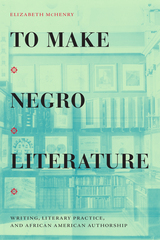 To Make Negro Literature: Writing, Literary Practice, and African American Authorship
Elizabeth McHenry
Duke University Press, 2021 In To Make Negro Literature Elizabeth McHenry traces African American authorship in the decade following the 1896 legalization of segregation. She shifts critical focus from the published texts of acclaimed writers to unfamiliar practitioners whose works reflect the unsettledness of African American letters in this period. Analyzing literary projects that were unpublished, unsuccessful, or only partially achieved, McHenry recovers a hidden genealogy of Black literature as having emerged tentatively, laboriously, and unevenly. She locates this history in books sold by subscription, in lists and bibliographies of African American authors and books assembled at the turn of the century, in the act of ghostwriting, and in manuscripts submitted to publishers for consideration and the letters of introduction that accompanied them. By attending to these sites and prioritizing overlooked archives, McHenry reveals a radically different literary landscape, revising concepts of Black authorship and offering a fresh account of the development of “Negro literature” focused on the never published, the barely read, and the unconventional.
 To Make the Earth Bear Fruit: Ethnographic Essays on Fertility, Work and Gender in Highland Bolivia
Olivia Harris
University of London Press, 1999 This volume opens a new series by the Institute of Latin American Studies dedicated to collecting the best work of leading Latin Americanists in the United Kingdom. The book brings together previously published ethnographic essays based on anthropological fieldwork in Northern Potosi, Bolivia, spanning the last 25 years. The introduction puts into context the pieces within the empirical and analytical developments in Latin American and Andean anthropology. The essays discuss key concerns and cultural symbols of the indigenous peasants of the Andes: the importance of the land and practices relating to its continued fertility; the cult of the dead; the complex division of labor and forms of circulation within the indigenous economy; the work of gender; and the mythological figure of the earth-mother. While based upon detailed ethnographic research, all the chapters also engage in theoretical and analytical debate both within and beyond the discipline.
 To My Dearest Wife, Lide: Letters from George B. Gideon Jr. during Commodore Perry’s Expedition to Japan, 1853–1855
Edited by M. Patrick Sauer and David A. Ranzan
University of Alabama Press, 2019 A personal account of Commodore Perry’s landmark expedition to Japan and life in the antebellum navy
George B. Gideon Jr. served as second assistant engineer aboard the USS Powhatan from 1852 to 1856. From his position on the steam frigate, Gideon traveled to Singapore, Labuan, Borneo, Hong Kong, and many other Asian lands. During his time at sea, Gideon penned dozens of letters to his wife, Lide, back home in Philadelphia. Recently discovered in the attic of his great-great-grandniece, were fifty-one letters penned by Gideon providing thorough and insightful commentary throughout the voyage.
Through these correspondences, Gideon laboriously documents the details of his daily life on board, from the food they ate to the technical aspects of his work, as well as observations concerning the historical events unfolding around him, such as Chinese piracy, the Taiping Rebellion, the Crimean War, and the devastation of Shimoda. To My Dearest Wife, Lide: Letters from George B. Gideon Jr. during Commodore Perry’s Expedition to Japan, 1853–1855 is a rare first-person account of the landmark American naval expedition to Japan to establish commercial relations between the two countries. Gideon’s letters have been meticulously transcribed and annotated by the editors and are an invaluable primary historical source.
Gideon’s letters are candid and revealing, delving into the rampant dysfunction in the navy of the 1850s—sickness and disease, alcohol abuse, and poor leadership, among other challenges. Gideon also unabashedly shares his own cynical views of the navy’s role in supporting American economic interests in Japan. This firsthand account of the political mission of the Perry expedition is a unique contribution to naval and military history and gives readers a better view of life aboard a navy ship.
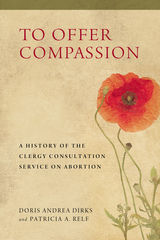 To Offer Compassion: A History of the Clergy Consultation Service on Abortion
Doris Andrea Dirks and Patricia A. Relf
University of Wisconsin Press, 2019 In 1967, when abortion was either illegal or highly restricted in every U.S. state, a group of ministers and rabbis formed to counsel women with unwanted pregnancies—including referral to licensed physicians willing to perform the procedure. By 1973, when the Roe v. Wade court decision made abortion legal nationwide, the Clergy Consultation Service on Abortion (CCS) had spread from coast to coast, referred hundreds of thousands of women for safe abortions without a single fatality, become a medical consumer advocacy group, and opened its own clinic in New York City.
As religious leaders spoke out on issues of civil rights, peace, or poverty, CCS members were also called to action by the suffering of women who had approached them for help. Overwhelmingly male, white, affluent, and middle-aged, these mainline Protestant and Jewish clergy were nonetheless outspoken advocates for the rights of women, particularly poor women. To Offer Compassion is a detailed history of this unique and largely forgotten movement, drawing on extensive interviews with original participants and on primary documents from the CCS's operations.
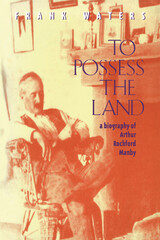 To Possess The Land: A Biography Of Arthur Rochford Manby
Frank Waters
Ohio University Press, 1993 Ambitious and only twenty-four years old, Arthur Manby arrived from England to the Territory of New Mexico in 1883 and saw in its wilderness an empire that he believed himself destined to rule. For his kingdom, he chose a vast Spanish land grant near Taos, a wild 100,000 acres whose title was beyond question. Obsessed, he poured more than twenty years into his dream of glory, and schemed, stole, lied, cajoled, begged, and bribed to take the vast grant from its rightful owners. With great mastery, Waters draws us into this obsession, and the intense drama of these years is at once psychological and historical. In May 1913, Manby came at last to possess the grant, but within three years it had slipped again from his grasp. The story does not end there, and perhaps only Frank Waters could have portrayed the strange disintegration of Manby’s personality as he aged, his frantic but ingenious efforts to regain “his” land. Among these was the creation of a secret society which terrorized whole towns and villages, becoming so powerful that even Manby no longer knew all its members and workings. At the same time he turned deeper inward, locked and bolted his gates against the outside world which hated and feared him more than ever. On July 3, 1929, a swollen, headless body was discovered in Manby’s Taos home. Some said it was murder; others swore the body was not Manby’s; still others reported seeing him alive afterward. The story blazed into national headlines and an official inquiry followed. Step by step, Waters takes us into the web of strange clues, evidence, more murders and complications—an investigation which the New Mexican government inexplicably called to a halt. The case remains one of the West’s greatest unsolved mysteries.
To Quench Our Thirst: The Present and Future Status of Freshwater Resources of the United States
David A. Francko and Robert G. Wetzel
University of Michigan Press, 1983 Freshwater resources underlie all agricultural and industrial processes and are fundamental to our survival. No technological substitutes for fresh water exist. United States society faces acute and chronic water resource crises, analogous to those that have repeatedly contributed to the demise and reduced standards in previous cultures. Corrective measures to reduce inefficient consumption, use, and degradation of existing water supplies can be accomplished with existing technology without losses of real economic productivity.
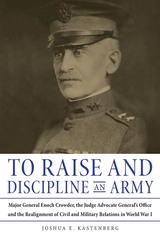 To Raise and Discipline an Army: Major General Enoch Crowder, the Judge Advocate General’s Office, and the Realignment of Civil and Military Relations in World War I
Joshua E. Kastenberg
Northern Illinois University Press, 2017 Major General Enoch Crowder served as the Judge Advocate General of the United States Army from 1911 to 1923. In 1915, Crowder convinced Congress to increase the size of the Judge Advocate General’s Office—the legal arm of the United States Army—from thirteen uniformed attorneys to more than four hundred. Crowder’s recruitment of some of the nation’s leading legal scholars, as well as former congressmen and state supreme court judges, helped legitimize President Woodrow Wilson’s wartime military and legal policies. As the United States entered World War I in 1917, the army numbered about 120,000 soldiers. The Judge Advocate General’s Office was instrumental in extending the military’s reach into the everyday lives of citizens to enable the construction of an army of more than four million soldiers by the end of the war. Under Crowder’s leadership, the office was responsible for the creation and administration of the Selective Service Act, under which thousands of men were drafted into military service, as well as enforcement of the Espionage Act and wartime prohibition.
In this first published history of the Judge Advocate General’s Office between the years of 1914 and 1922, Joshua Kastenberg examines not only courts-martial, but also the development of the laws of war and the changing nature of civil-military relations. The Judge Advocate General’s Office influenced the legislative and judicial branches of the government to permit unparalleled assertions of power, such as control over local policing functions and the economy. Judge advocates also altered the nature of laws to recognize a person’s diminished mental health as a defense in criminal trials, influenced the assertion of US law overseas, and affected the evolving nature of the law of war. This groundbreaking study will appeal to scholars, students, and general readers of US history, as well as military, legal, and political historians.
 To Raise Up a Nation: John Brown, Frederick Douglass, and the Making of a Free Country
William S. King
Westholme Publishing, 2013 A Choice Academic Book of the Year: The Sweeping Story of the Men and Women Who Fought to End Slavery in America
Drawing on decades of research, and demonstrating remarkable command of a great range of primary sources, William S. King has written an important history of African Americans’ own contributions and points of crossracial cooperation to end slavery in America. Beginning with the civil war along the border of Kansas and Missouri, the author traces the life of John Brown and the personal support for his ideas from elite New England businessmen, intellectuals such as Emerson and Thoreau, and African Americans, including his confidant, Frederick Douglass, and Harriet Tubman. Throughout, King links events that contributed to the growing antipathy in the North toward slavery and the South’s concerns for its future, including Nat Turner’s insurrection, the Amistad affair, the Fugitive Slave law, the Kansas-Nebraska Act, and the Dred Scott decision. The author also effectively describes the debate within the African American community as to whether the U.S. Constitution was colorblind or if emigration was the right course for the future of blacks in America.
Following Brown’s execution after the failed raid on Harper’s Ferry in 1859, King shows how Brown’s vision that only a clash of arms would eradicate slavery was set into motion after the election of Abraham Lincoln. Once the Civil War erupted on the heels of Brown’s raid, the author relates how black leaders, white legislators, and military officers vigorously discussed the use of black manpower for the Union effort as well as plans for the liberation of the “veritable Africa” within the southern United States. Following the Emancipation Proclamation of January 1863, recruitment of black soldiers increased and by war’s end they made up nearly ten percent of the Union army, and contributed to many important victories.
To Raise Up a Nation: John Brown, Frederick Douglass, and the Making of a Free Country is a sweeping history that explains how the destruction of American slavery was not directed primarily from the counsels of local and national government and military men, but rather through the grassroots efforts of extraordinary men and women. As King notes, the Lincoln administration ultimately armed black Americans, as John Brown had attempted to do, and their role was a vital part in the defeat of slavery.
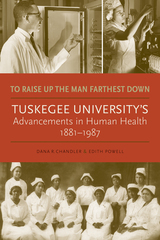 To Raise Up the Man Farthest Down: Tuskegee University’s Advancements in Human Health, 1881–1987
Dana R. Chandler and Edith Powell
University of Alabama Press, 2018 An important historical account of Tuskegee University’s significant advances in health care, which affected millions of lives worldwide.
Alabama’s celebrated, historically black Tuskegee University is most commonly associated with its founding president, Booker T. Washington, the scientific innovator George Washington Carver, or the renowned Tuskegee Airmen. Although the university’s accomplishments and devotion to social issues are well known, its work in medical research and health care has received little acknowledgment. Tuskegee has been fulfilling Washington’s vision of “healthy minds and bodies” since its inception in 1881. In To Raise Up the Man Farthest Down, Dana R. Chandler and Edith Powell document Tuskegee University’s medical and public health history with rich archival data and never-before-published photographs. Chandler and Powell especially highlight the important but largely unsung role that Tuskegee University researchers played in the eradication of polio, and they add new dimension and context to the fascinating story of the HeLa cell line that has been brought to the public’s attention by popular media.
Tuskegee University was on the forefront in providing local farmers the benefits of agrarian research. The university helped create the massive Agricultural Extension System managed today by land grant universities throughout the United States. Tuskegee established the first baccalaureate nursing program in the state and was also home to Alabama’s first hospital for African Americans. Washington hired Alabama’s first female licensed physician as a resident physician at Tuskegee. Most notably, Tuskegee was the site of a remarkable development in American biochemistry history: its microbiology laboratory was the only one relied upon by the National Foundation for Infantile Paralysis (the organization known today as the March of Dimes) to produce the HeLa cell cultures employed in the national field trials for the Salk and Sabin polio vaccines. Chandler and Powell are also interested in correcting a long-held but false historical perception that Tuskegee University was the location for the shameful and infamous US Public Health Service study of untreated syphilis.
Meticulously researched, this book is filled with previously undocumented information taken directly from the vast Tuskegee University archives. Readers will gain a new appreciation for how Tuskegee’s people and institutions have influenced community health, food science, and national medical life throughout the twentieth century.
To Reason Why
Jeffrey Kimball
Temple University Press, 1990 This anthology provides a comprehensive overview of the major theories about the causes of American involvement in Southeast Asia from 1945 to 1975. Presenting the often conflicting arguments advanced by national leaders, policy makers, strategists, historians, social scientists, journalists, and activists, this volume represents the major reasons why and how the U.S. became involved, diplomatically and militarily, in the quagmire of Vietnam. As the first book to focus on the debate about the reasoning and causes of U.S. involvement, it fills a major gap in the study of the Vietnam war.
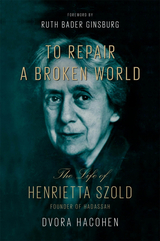 To Repair a Broken World: The Life of Henrietta Szold, Founder of Hadassah
Dvora Hacohen
Harvard University Press, 2021 The authoritative biography of Henrietta Szold, founder of Hadassah, introduces a new generation to a remarkable leader who fought for women’s rights and the poor.
Born in Baltimore in 1860, Henrietta Szold was driven from a young age by the mission captured in the concept of tikkun olam, “repair of the world.” Herself the child of immigrants, she established a night school, open to all faiths, to teach English to Russian Jews in her hometown. She became the first woman to study at the Jewish Theological Seminary, and was the first editor for the Jewish Publication Society. In 1912 she founded Hadassah, the international women’s organization dedicated to humanitarian work and community building. A passionate Zionist, Szold was troubled by the Jewish–Arab conflict in Palestine, to which she sought a peaceful and equitable solution for all.
Noted Israeli historian Dvora Hacohen captures the dramatic life of this remarkable woman. Long before anyone had heard of intersectionality, Szold maintained that her many political commitments were inseparable. She fought relentlessly for women’s place in Judaism and for health and educational networks in Mandate Palestine. As a global citizen, she championed American pacifism. Hacohen also offers a penetrating look into Szold’s personal world, revealing for the first time the psychogenic blindness that afflicted her as the result of a harrowing breakup with a famous Talmudic scholar.
Based on letters and personal diaries, many previously unpublished, as well as thousands of archival documents scattered across three continents, To Repair a Broken World provides a wide-ranging portrait of a woman who devoted herself to helping the disadvantaged and building a future free of need.
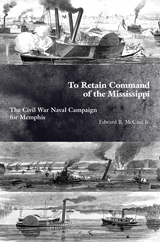 To Retain Command of the Mississippi: The Civil War Naval Campaign for Memphis
Edward B. McCaul Jr.
University of Tennessee Press, 2014 The Mississippi River was a strategic priority for the Union army from the outset of the American Civil War. By controlling the Mississippi, the North’s military forces could effectively split the Confederacy in two and create economic and logistical havoc for Confederate supply lines that relied on river transportation. A number of battles were fought for control of the Mississippi, and ultimately the combination of Union troops supported by Federal gunboats and armored paddle steamers culminated in the surrender of Port Hudson in July 1863 and Union dominance over the Mississippi waterways.
The Battle of Memphis was one such fray waged for control of the Mississippi. It was a major victory for the Union, one that was over almost before it began because of luck and lessons the Union fleet learned at a hard-fought battle with the Confederate River Defense Fleet at Plum Point. Perhaps owing to its swift conclusion, the Battle of Memphis has not received the scholarly attention of other battles, such as Vicksburg and Forts Henry and Donelson. In To Retain Command of the Mississippi, Edward B. McCaul Jr. argues that the Battle of Memphis was pivotal in the Union’s efforts to control the Mississippi River. The Union command, by narrowly escaping defeat at Plum Point, learned invaluable lessons about the Confederate River Defense Fleet and masterfully enacted those lessons in decisively defeating the Confederate fleet at Memphis. With the Confederacy’s river forces severely crippled after the Battle of Memphis, the Union fleets pushed onward to eventual victory at Vicksburg.
McCaul brings this pivotal river battle back into the American Civil War discussion by highlighting the Union gains and Confederate losses that led up to the Battle of Memphis and maintaining that had the battle gone differently, Grant’s plans for taking Vicksburg would have been drastically altered
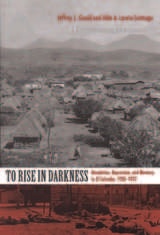 To Rise in Darkness: Revolution, Repression, and Memory in El Salvador, 1920–1932
Jeffrey L. Gould, Aldo A. Lauria-Santiago
Duke University Press, 2008 To Rise in Darkness offers a new perspective on a defining moment in modern Central American history. In January 1932 thousands of indigenous and ladino (non-Indian) rural laborers, provoked by electoral fraud and the repression of strikes, rose up and took control of several municipalities in central and western El Salvador. Within days the military and civilian militias retook the towns and executed thousands of people, most of whom were indigenous. This event, known as la Matanza (the massacre), has received relatively little scholarly attention. In To Rise in Darkness, Jeffrey L. Gould and Aldo A. Lauria-Santiago investigate memories of the massacre and its long-term cultural and political consequences. Gould conducted more than two hundred interviews with survivors of la Matanza and their descendants. He and Lauria-Santiago combine individual accounts with documentary sources from archives in El Salvador, Guatemala, Washington, London, and Moscow. They describe the political, economic, and cultural landscape of El Salvador during the 1920s and early 1930s, and offer a detailed narrative of the uprising and massacre. The authors challenge the prevailing idea that the Communist organizers of the uprising and the rural Indians who participated in it were two distinct groups. Gould and Lauria-Santiago demonstrate that many Communist militants were themselves rural Indians, some of whom had been union activists on the coffee plantations for several years prior to the rebellion. Moreover, by meticulously documenting local variations in class relations, ethnic identity, and political commitment, the authors show that those groups considered “Indian” in western El Salvador were far from homogeneous. The united revolutionary movement of January 1932 emerged out of significant cultural difference and conflict.
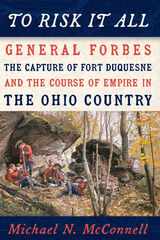 To Risk It All: General Forbes, the Capture of Fort Duquesne, and the Course of Empire in the Ohio Country
Michael McConnell
University of Pittsburgh Press, 2020 General John Forbes’s campaign against Fort Duquesne was the largest over-land expedition during the Seven Years’ War in America. While most histories of the time period include the Forbes Campaign as an aside, McConnell documents how and why Forbes and his army succeeded, and what his success meant to the subsequent history of the mid-Atlantic colonies, native inhabitants of the Ohio Country, and the empire he represented.
A close look at the Forbes Campaign and its personnel reveals much about both British relations with native peoples and the nature of Britain’s American empire during a time of stress. Unlike other campaigns, this one was composed largely of colonial—not professional British—troops. In addition, individual colonies negotiated their role in the campaign and frequently placed their own local interests ahead of those of the empire as a whole. The campaign thus suggests the limits of imperial power and how Britain’s hold over its American frontiers was, at best, tenuous and helped lead to an eventual break-down of empire in the 1760s and 1770s.
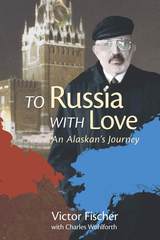 To Russia with Love: An Alaskan's Journey
Victor Fischer with Charles Wohlforth
University of Alaska Press, 2012 Son of the famous American journalist Louis Fischer, who corresponded from Germany and then Moscow, and the Russian writer Markoosha Fischer, Victor Fischer grew up in the shadow of Hitler and Stalin, watching his friends’ parents disappear after political arrests. Eleanor Roosevelt personally engineered the Fischer family’s escape from Russia, and soon after Victor was serving in the United States Army in World War II and fighting opposite his childhood friends in the Russian and German armies. As a young adult, he went on to help shape Alaska’s map by planning towns throughout the state. This unique autobiography recounts Fischer’s earliest days in Germany, Russia, and Alaska, where he soon entered civic affairs and was elected as a delegate to the Alaska Constitutional Convention—the body responsible for establishing statehood in the territory. A move to Washington, DC, and further government appointments allowed him to witness key historic events of his era, which he also recounts here. Finally, Fischer brings his memoir up to the present, describing how he has returned to Russia many times to bring the lessons of Alaska freedom and prosperity to the newly democratic states.
 To Save and to Destroy: Writing as an Other
Viet Thanh Nguyen
Harvard University Press, 2025 From the Pulitzer Prize–winning author of The Sympathizer (now an HBO series) comes a moving and unflinchingly personal meditation on the literary forms of otherness and a bold call for expansive political solidarity.
Born in war-ravaged Vietnam, Viet Nguyen arrived in the United States as a child refugee in 1975. The Nguyen family would soon move to San Jose, California, where the author grew up, attending UC Berkeley in the aftermath of the shocking murder of Vincent Chin, which shaped the political sensibilities of a new generation of Asian Americans.
The essays here, delivered originally as the prestigious Norton Lectures, proffer a new answer to a classic literary question: What does the outsider mean to literary writing? Over the course of six captivating and moving chapters, Nguyen explores the idea of being an outsider through lenses that are, by turns, literary, historical, political, and familial.
Each piece moves between writers who influenced Nguyen’s craft and weaves in the haunting story of his late mother’s mental illness. Nguyen unfolds the novels and nonfiction of Herman Melville, F. Scott Fitzgerald, Ralph Ellison, William Carlos Williams, and Maxine Hong Kingston, until aesthetic theories give way to pressing concerns raised by war and politics. What is a writer’s responsibility in a time of violence? Should we celebrate fiction that gives voice to the voiceless—or do we confront the forces that render millions voiceless in the first place? What are the burdens and pleasures of the “minor” writer in any society? Unsatisfied with the modest inclusion accorded to “model minorities” such as Asian Americans, Nguyen sets the agenda for a more radical and disquieting solidarity with those whose lives have been devastated by imperialism and forever wars.
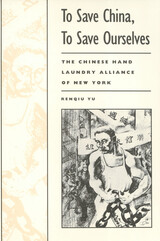 To Save China, To Save Ourselves: The Chinese Hand Laundry Alliance of New York
Renqiu Yu
Temple University Press, 1995 Combining archival research in Chinese language sources with oral history interviews, Renqiu Yu examines the Chinese Hand Laundry Alliance (CHLA), an organization that originated in 1933 to help Chinese laundry workers break their isolation in American society. Yu brings to life the men who labored in New York laundries, depicting their meager existence, their struggles against discrimination and exploitation, and their dreams of returning to China. The persistent efforts of the CHLA succeeded in changing the workers' status in American society and improving the image of the Chinese among the American public. Yu is especially concerned with the political activities of the CHLA, which was founded in reaction to proposed New York City legislation that would have put the Chinese laundries out of business. When the conservative Chinese social organization could not help the launderers, they broke with tradition and created their own organization. Not only did the CHLA defeat the legislative requirements that would have closed them down, but their "people's diplomacy" won American support for China during its war with Japan. The CHLA staged a campaign in the 1930s and 40s which took as its slogan, "To Save China, To Save Ourselves." Focusing on this campaign, Yu also examines the complex relationship between the democratically oriented CHLA and the Chinese American left in the 1930s.
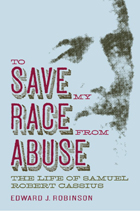 To Save My Race from Abuse: The Life of Samuel Robert Cassius
Edward J. Robinson
University of Alabama Press, 2009 The story of a fascinating and important figure in black American religious history
Samuel Robert Cassius was born to a slave mother and a white father in Virginia in 1853 and became a member of the Restorationist Movement (Disciples of Christ) while a coal miner in Indiana. For the rest of his long life (he died in 1931 at age 78), Cassius was an active evangelist, prolific publicist, dedicated leader of black Disciples, and an outspoken and uncompromising opponent of racism in religion and society.
An indefatigable preacher, Cassius ranged throughout the Midwest, California, and the southwestern states, founding and encouraging black Stone-Campbell Restorationist congregations. After entering the Oklahoma Territory in 1891, he worked for three decades as an educator, newspaper editor, social activist, postmaster, and Justice of the Peace. Because he consistently incorporated social and racial issues into his religious writings, Cassius often found himself at odds with whites in the Stone-Campbell Movement, the very people he relied on for monetary support. He advocated a Booker T. Washington-style self-help ethos while at the same time firmly resisting racism wherever he encountered it. Largely invisible in a world dominated by such towering figures as Washington, Frederick Douglass, Ida B. Wells, and W. E. B. DuBois, Cassius lived a life of virtual obscurity beyond the circle of the Stone-Campbell Movement. His story is important because, as a racial militant and separatist, he presaged the schism that would engulf and fracture the Churches of Christ in the 1960s, when blacks and whites went their separate ways and formed two distinct groups in one religious fellowship.
By combing through a plethora of primary sources that Cassius left behind in both religious and nonreligious journals, Edward J. Robinson has successfully reconstructed and recaptured the essence of Cassius’ complex and extraordinary life. This book offers the first full-length study of a man of remarkable attainment despite daily obstacles and resistance.
To Save the Phenomena: An Essay on the Idea of Physical Theory from Plato to Galileo
Pierre Duhem
University of Chicago Press, 1969 Duhem's 1908 essay questions the relation between physical theory and metaphysics and, more specifically, between astronomy and physics–an issue still of importance today. He critiques the answers given by Greek thought, Arabic science, medieval Christian scholasticism, and, finally, the astronomers of the Renaissance.
To Scorch or Freeze: Poems about the Sacred
Donald Davie
University of Chicago Press, 1988 Here Davie, a writer attuned to both the changes of the modern world and a living literary tradition, turns to the lapsed poetic practice of translation and imitation of the Psalms of David. The result is a series of poems that speak powerfully of moral indignation and spiritual discovery within the complex of modernity.
"Few modern poets have managed to achieve Donald Davie's sense of human worth."—Times Higher Educational Supplement
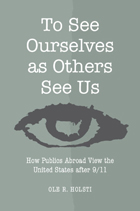 To See Ourselves as Others See Us: How Publics Abroad View the United States after 9/11
Ole R. Holsti
University of Michigan Press, 2008 "Holsti, the authority on American foreign policy attitudes, investigates others' views of us. It's not pretty. It matters. Read this."
---Bruce Russett, Dean Acheson Professor of International Relations, Yale University, and editor of the Journal of Conflict Resolution "Clearly and engagingly written, Holsti's book ranks among the most important---and most objective---of the post-9/11 scholarly studies. It deserves a large readership, both within and beyond academe."
---Ralph Levering, Vail Professor of History, Davidson College In terms of military and economic power, the United States remains one of the strongest nations in the world. Yet the United States seems to have lost the power of persuasion, the ability to make allies and win international support. Why? Immediately after the terrorist attacks of 9/11, leaders and citizens of foreign nations generally expressed sympathy for the United States. Since then, attitudes have changed. Drawing upon public opinion surveys conducted in 30 nations, Ole R. Holsti documents an increasing anti-American sentiment. His analysis suggests that the war in Iraq, human rights violations, and unpopular international policies are largely responsible. Consequently, the United States can rebuild its repute by adopting an unselfish, farsighted approach to global issues. Indeed, the United States must restore goodwill abroad, Holsti asserts, because public opinion indirectly influences the leaders who decide whether or not to side with the Americans. Ole R. Holsti is George V. Allen Professor Emeritus of International Affairs in the Department of Political Science at Duke University and author of Public Opinion and American Foreign Policy.
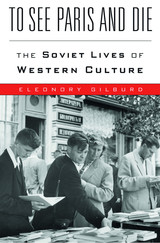 To See Paris and Die: The Soviet Lives of Western Culture
Eleonory Gilburd
Harvard University Press, 2018 A Foreign Affairs Best Book of the Year
Winner of the AATSEEL Prize for Best Book in Cultural Studies
Winner of the Laura Shannon Prize in Contemporary European Studies
Winner of the Marshall D. Shulman Book Prize
Winner of the Wayne S. Vucinich Book Prize
The Soviet Union was a notoriously closed society until Stalin’s death in 1953. Then, in the mid-1950s, a torrent of Western novels, films, and paintings invaded Soviet streets and homes, acquiring heightened emotional significance. To See Paris and Die is a history of this momentous opening to the West.
At the heart of this history is a process of translation, in which Western figures took on Soviet roles: Pablo Picasso as a political rabble-rouser; Rockwell Kent as a quintessential American painter; Erich Maria Remarque and Ernest Hemingway as teachers of love and courage under fire; J. D. Salinger and Giuseppe De Santis as saviors from Soviet clichés. Imported novels challenged fundamental tenets of Soviet ethics, while modernist paintings tested deep-seated notions of culture. Western films were eroticized even before viewers took their seats. The drama of cultural exchange and translation encompassed discovery as well as loss.
Eleonory Gilburd explores the pleasure, longing, humiliation, and anger that Soviet citizens felt as they found themselves in the midst of this cross-cultural encounter. The main protagonists of To See Paris and Die are small-town teachers daydreaming of faraway places, college students vicariously discovering a wider world, and factory engineers striving for self-improvement. They invested Western imports with political and personal significance, transforming foreign texts into intimate belongings.
With the end of the Soviet Union, the Soviet West disappeared from the cultural map. Gilburd’s history reveals how domesticated Western imports defined the last three decades of the Soviet Union, as well as its death and afterlife.
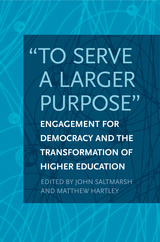 "To Serve a Larger Purpose": Engagement for Democracy and the Transformation of Higher Education
Edited by John Saltmarsh and Matthew Hartley
Temple University Press, 2012 "To Serve a Larger Purpose" calls for the reclamation of the original democratic purposes of civic engagement and examines the requisite transformation of higher education required to achieve it. The contributors to this timely and relevant volume effectively highlight the current practice of civic engagement and point to the institutional change needed to realize its democratic ideals.
Using multiple perspectives, "To Serve a Larger Purpose" explores the democratic processes and purposes that reorient civic engagement to what the editors call "democratic engagement." The norms of democratic engagement are determined by values such as inclusiveness, collaboration, participation, task sharing, and reciprocity in public problem solving and an equality of respect for the knowledge and experience that everyone contributes to education, knowledge generation, and community building. This book shrewdly rethinks the culture of higher education.
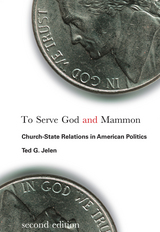 To Serve God and Mammon: Church–State Relations in American Politics, Second Edition
Ted G. Jelen
Georgetown University Press, 2010 Newly revised and updated, To Serve God and Mammon is a classic in the field of religion and politics that provides an unbiased introduction and overview of church–state relations in the United States. Jelen begins by exploring the inherent tension between the Establishment and Free Exercise clauses of the First Amendment. He then examines how different actors in American politics (e.g., the courts, Congress, the president, ordinary citizens) have different and conflicting values that affect their attitudes and actions toward the relationship between the sacred and the secular. Finally, he discusses how the fragmented nature of political authority in the United States provides the basis for continuing conflict concerning church–state relations. This second edition includes analyses of various recent court cases and the implications of living in the post–9/11 era. It also features discussion questions at the end of each chapter, a glossary of terms, and synopses of selected court decisions bearing on religion and politics in the United States.
 To Serve God and Wal-Mart: The Making of Christian Free Enterprise
Bethany Moreton
Harvard University Press, 2009 In the decades after World War II, evangelical Christianity nourished America’s devotion to free markets, free trade, and free enterprise. The history of Wal-Mart uncovers a complex network that united Sun Belt entrepreneurs, evangelical employees, Christian business students, overseas missionaries, and free-market activists. Through the stories of people linked by the world’s largest corporation, Bethany Moreton shows how a Christian service ethos powered capitalism at home and abroad.
While industrial America was built by and for the urban North, rural Southerners comprised much of the labor, management, and consumers in the postwar service sector that raised the Sun Belt to national influence. These newcomers to the economic stage put down the plough to take up the bar-code scanner without ever passing through the assembly line. Industrial culture had been urban, modernist, sometimes radical, often Catholic and Jewish, and self-consciously international. Post-industrial culture, in contrast, spoke of Jesus with a drawl and of unions with a sneer, sang about Momma and the flag, and preached salvation in this world and the next.
This extraordinary biography of Wal-Mart’s world shows how a Christian pro-business movement grew from the bottom up as well as the top down, bolstering an economic vision that sanctifies corporate globalization.
The author has assigned her royalties and subsidiary earnings to Interfaith Worker Justice (www.iwj.org) and its local affiliate in Athens, GA, the Economic Justice Coalition (www.econjustice.org).
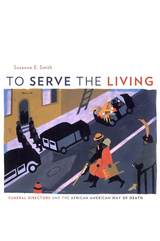 To Serve the Living: Funeral Directors and the African American Way of Death
Suzanne E. Smith
Harvard University Press, 2010 From antebellum slavery to the twenty-first century, African American funeral directors have orchestrated funerals or “homegoing” ceremonies with dignity and pageantry. As entrepreneurs in a largely segregated trade, they were among the few black individuals in any community who were economically independent and not beholden to the local white power structure. Most important, their financial freedom gave them the ability to support the struggle for civil rights and, indeed, to serve the living as well as bury the dead.
During the Jim Crow era, black funeral directors relied on racial segregation to secure their foothold in America’s capitalist marketplace. With the dawning of the civil rights age, these entrepreneurs were drawn into the movement to integrate American society, but were also uncertain how racial integration would affect their business success. From the beginning, this tension between personal gain and community service shaped the history of African American funeral directing.
For African Americans, death was never simply the end of life, and funerals were not just places to mourn. In the “hush harbors” of the slave quarters, African Americans first used funerals to bury their dead and to plan a path to freedom. Similarly, throughout the long—and often violent—struggle for racial equality in the twentieth century, funeral directors aided the cause by honoring the dead while supporting the living. To Serve the Living offers a fascinating history of how African American funeral directors have been integral to the fight for freedom.
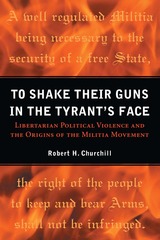 To Shake Their Guns in the Tyrant's Face: Libertarian Political Violence and the Origins of the Militia Movement
Robert H. Churchill
University of Michigan Press, 2011 After the bombings of Oklahoma City in 1995, most Americans were shocked to discover that tens of thousands of their fellow citizens had banded together in homegrown militias. Within the next few years, numerous studies and media reports appeared revealing the unseen world of the American militia movement, a loose alliance of groups with widely divergent views. Not surprisingly, it was the movement’s most extreme voices that attracted the lion's share of attention. In reality the militia movement was neither as irrational nor as new as it was portrayed in the press, Robert Churchill writes. What bound the movement together was the shared belief that citizens have a right, even a duty, to take up arms against wanton exercise of unconstitutional power by the federal government. Many were motivated to join the movement by what they saw as a rise in state violence, illustrated by the government assaults at Ruby Ridge, Idaho in 1992, and Waco, Texas in 1993. It was this perception and the determination to deter future state violence, Churchill argues, that played the greatest role in the growth of the American militia movement. Churchill uses three case studies to illustrate the origin of some of the core values of the modern militia movement: Fries' Rebellion in Pennsylvania at the end of the eighteenth century, the Sons of Liberty Conspiracy in Civil War-era Indiana and Illinois, and the Black Legion in Michigan and Ohio during the Depression. Building on extensive interviews with militia members, the author places the contemporary militia movement in the context of these earlier insurrectionary movements that, animated by a libertarian interpretation of the American Revolution, used force to resist the authority of the federal government. A historian of early America, Robert H. Churchill has published numerous articles on American political violence and the right to keep and bear arms. He is currently Associate Professor of History at the University of Hartford. "This book is about how we think about the past, how cultural memories are formed and evolve, and how these memories then come to impact current understandings of issues. Churchill provides an enlightening analysis of the ideology, structure, and purpose of the militia movement. Where much scholarship has categorized it as a cohesive, single movement, Churchill begins the process of unraveling its complexity."
---Steve Chermak, Michigan State University "To Shake Their Guns in the Tyrant's Face addresses an area---the relationship of American political violence to American ideology---that is of growing importance and that is commanding an ever increasing audience, and it does so in a way like nothing else in the field."
---David Williams, Indiana University Bloomington
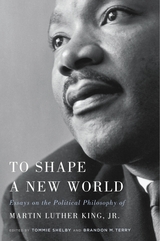 To Shape a New World: Essays on the Political Philosophy of Martin Luther King, Jr.
Tommie Shelby
Harvard University Press, 2018 “Fascinating and instructive…King’s philosophy, speaking to us through the written word, may turn out to constitute his most enduring legacy.”
—Annette Gordon-Reed, New York Review of Books
Martin Luther King, Jr., is one of America’s most revered figures, yet despite his mythic stature, the significance of his political thought remains underappreciated. In this indispensable reappraisal, leading scholars—including Cornel West, Martha Nussbaum, and Danielle Allen—consider the substance of his lesser known writings on racism, economic inequality, virtue ethics, just-war theory, reparations, voting rights, civil disobedience, and social justice and find in them an array of compelling challenges to some of the most pressing political dilemmas of our time.
“King was not simply a compelling speaker, but a deeply philosophical intellectual…We still have much to learn from him.”
—Quartz
“A compelling work of philosophy, all the more so because it treats King seriously without inoculating him from the kind of critique important to both his theory and practice.”
—Los Angeles Review of Books
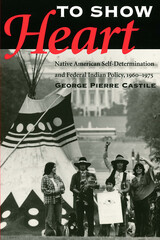 To Show Heart: Native American Self-Determination and Federal Indian Policy, 1960-1975
George Pierre Castile
University of Arizona Press, 1998 Federal policy toward Native Americans has fluctuated wildly in the twentieth century. Washington long envisioned that Indians would be assimilated into American culture—until FDR's New Deal introduced tribal self-government. Then, during the Truman and Eisenhower administrations, its goal became the termination of federal wardship status for Indians. This book considers the changes in attitude that began in 1960 and culminated in the Indian Self-Determination Act of 1975. Drawing on personal interviews with key players, George Castile goes behind the scenes in Washington to reveal what motivated policy makers—and who really shaped policy—from the Kennedy to the Ford administrations.
To Show Heart is a detailed and unbiased account of one of the least understood periods in Indian affairs. It tells how "termination" became a political embarrassment during the civil rights movement, how Lyndon Johnson's War on Poverty prompted politicians to rethink Indian policy, and how championing self-determination presented an opportunity for Presidents Nixon and Ford to "show heart" toward Native Americans. Along the way, Castile assesses the impact of the Indian activism of the 1960s and 1970s and offers an objective view of the American Indian Movement and the standoff at Wounded Knee. He also discusses the recent history of individual tribes, which gives greater meaning to decisions made at the national level. Castile's work greatly enhances our understanding of the formulation of current Indian policy and of the changes that have occurred since 1975. To Show Heart is an important book not only for anthropologists and historians but also for Native Americans themselves, who will benefit from this inside look at how bureaucrats have sought to determine their destinies.
To Show What an Indian Can Do: Sports at Native American Boarding Schools
John Bloom
University of Minnesota Press, 2005 The Carlisle Indian School and the Haskell Institute in Kansas were among the many federally operated boarding schools enacting the U.S. government's education policy toward Native Americans from the late nineteenth to the mid-twentieth century, one designed to remove children from familiar surroundings and impose mainstream American culture on them. To Show What an Indian Can Do explores the history of sports programs at these institutions and, drawing on the recollections of former students, describes the importance of competitive sports in their lives. Author John Bloom focuses on the male and female students who did not typically go on to greater athletic glory but who found in sports something otherwise denied them by the boarding school program: a sense of community, accomplishment, and dignity.
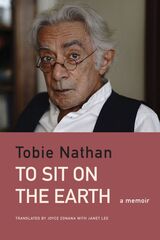 To Sit on the Earth: A Memoir
Tobie Nathan
Seagull Books, 2024 A stirring memoir of exile and self-discovery by a central figure in ethno-psychiatry.
In To Sit on the Earth, pioneering ethno-psychiatrist Tobie Nathan charts his intellectual and emotional journey, from his youthful infatuation with Freud and Wilhelm Reich to his mature adoption of anthropologist Georges Devereux’s ethnographic approach to psychoanalysis.
Expelled from Egypt as a Jew in 1956 when he was just a boy, Nathan spent his formative years on the outskirts of Paris. Caught up in situationist and Marxist politics, he enthusiastically participated in the revolutionary Events of May 1968. He then settled into a distinguished career as a writer, professor, and founding director of a free ethno-psychiatry clinic serving migrant populations in the French capital. Along the way, Nathan’s field research and practice took him to Benin, Burundi, and Brazil, where he sought out sorcerers, shamans, and other indigenous healers. As he did so, he encountered telling echoes of his ancestors’ age-old practices in Judeo-Arab Cairo.
Combining case histories and theoretical reflections with personal and familial anecdotes, while engaging with contemporary thinkers—including Sartre, Lacan, Bourdieu, and Foucault—this multi-layered, genre-defying memoir invites us to reconsider the beliefs that connect us to others and ourselves. To Sit on the Earth lays out a subtle, compelling case for the theological and cultural diversity essential to a thriving modernity.
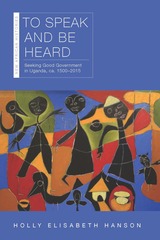 To Speak and Be Heard: Seeking Good Government in Uganda, ca. 1500–2015
Holly Elisabeth Hanson
Ohio University Press, 2021 A history of a political practice through which East Africans have sought to create calm, harmonious polities for five hundred years. “To speak and be heard” is a uniquely Ugandan approach to government that aligns power with groups of people that actively demonstrate their assent both through their physical presence and through essential gifts of goods and labor. In contrast to a parliamentary democracy, the Ugandan system requires a level of active engagement much higher than simply casting a vote in periodic elections. These political strategies—assembly, assent, and powerful gifts—can be traced from before the emergence of kingship in East Africa (ca. 1500) through enslavement, colonial intervention, and anticolonial protest. They appear in the violence of the Idi Amin years and are present, sometimes in dysfunctional ways, in postcolonial politics. Ugandans insisted on the necessity of multiple voices contributing to and affirming authority, and citizens continued to believe in those principles even when colonial interference made good governance through building relationships almost impossible. Through meticulous research, Holly Hanson tells a history of the region that differs from commonly accepted views. In contrast to the well-established perception that colonial manipulation of Uganda’s tribes made state failure inevitable, Hanson argues that postcolonial Ugandans had the capacity to launch a united, functional nation-state and could have done so if leaders in Buganda, Britain, and Uganda’s first governments had made different choices.
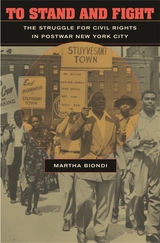 To Stand and Fight: The Struggle for Civil Rights in Postwar New York City
Martha Biondi
Harvard University Press, 2006 The story of the Civil Rights Movement typically begins with the Montgomery bus boycott of 1955 and culminates with the 1965 voting rights struggle in Selma. But as Martha Biondi shows, a grassroots struggle for racial equality in the urban North began a full ten years before the rise of the movement in the South. This story is an essential first chapter, not only to the southern movement that followed, but to the riots that erupted in northern and western cities just as the Civil Rights Movement was achieving major victories.
Biondi tells the story of African Americans who mobilized to make the war against fascism a launching pad for a postwar struggle against white supremacy at home. Rather than seeking integration in the abstract, Black New Yorkers demanded first-class citizenship—jobs for all, affordable housing, protection from police violence, access to higher education, and political representation. This powerful local push for economic and political equality met broad resistance, yet managed to win several landmark laws barring discrimination and segregation.
To Stand and Fight demonstrates how Black New Yorkers launched the modern civil rights struggle and left a rich legacy.
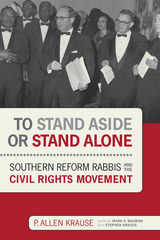 To Stand Aside or Stand Alone: Southern Reform Rabbis and the Civil Rights Movement
P. Allen Krause, Edited by Mark K. Bauman with Stephen Krause
University of Alabama Press, 2016 A landmark collection of previously unpublished interviews with Reform rabbis concerning their roles in the civil rights movement.
In 1966, a young rabbinical student named P. Allen Krause conducted interviews with twelve Reform rabbis from southern congregations concerning their thoughts, principles, and activities as they related to the civil rights movement. Perhaps because he was a young seminary student or more likely because the interviewees were promised an embargo of twenty-five years before the interviews would be released to the public, the rabbis were extremely candid about their opinions on and their own involvement with what was still an incendiary subject. Now, in To Stand Aside or Stand Alone: Southern Reform Rabbis and the Civil Rights Movement, their stories help elucidate a pivotal moment in time.
After a distinguished rabbinical career, Krause wrote introductions to and annotated the interviews. When Krause succumbed to cancer in 2012, Mark K. Bauman edited the manuscripts further and wrote additional introductions with the assistance of Stephen Krause, the rabbi’s son. The result is a unique volume offering insights into these rabbis’ perceptions and roles in their own words and with more depth and nuance than hitherto available. This exploration into the lives of these teachers and civic leaders is supported by important contextual information on the local communities and other rabbis, with such background information forming the basis of a demographic profile of the Reform rabbis working in the South.
The twelve rabbis whom Krause interviewed served in Alabama, Georgia, Louisiana, Mississippi, Tennessee, and Virginia, and the substance and scope of their discussions cover some of the most crucial periods in the civil rights movement. Although some have provided accounts that appeared elsewhere or have written about their experiences themselves, several new voices appear here, suggesting that more southern rabbis were active than previously thought. These men functioned within a harsh environment: rabbis’ homes, synagogues, and Jewish community centers were bombed; one rabbi, who had been beaten and threatened, carried a pistol to protect himself and his family. The views and actions of these men followed a spectrum from gradualism to activism; while several of the rabbis opposed the evils of the separate and unequal system, others made peace with it or found reasons to justify inaction. Additionally, their approaches differed from their activist colleagues in the North even more than from each other.
Within these pages, readers learn about the attitudes of the rabbis toward each other, toward their congregants, toward national Jewish organizations, and toward local leaders of black and white and Protestant and Catholic groups. Theirs are dramatic stories of frustration, cooperation, and conflict.
To Stir a Restless Heart
Jacob W. Wood
Catholic University of America Press, 2019 To Stir a Restless Heart tells for the first time the story of how Thomas Aquinas conversed with his contemporaries about the dynamics of human nature’s longing for God, and documents how he deliberately utilized Greek, Arabic, Hebrew, and Latin sources to develop a version of Aristotelian natural desire that was uniquely Augustinian: natural desire seeks the complete fulfillment of human nature “insofar as is possible,” and so comes to rest in the highest end that God offers to it. Depending on whether God offers the free gift of grace to humanity, one and the same natural desire can come to rest in knowing God through creatures or seeing God directly.
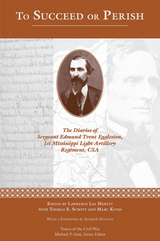 To Succeed or Perish: The Diaries of Sergeant Edmund Trent Eggleston, Company G, 1st Mississippi Light Artillery Regiment
Lawrence Lee Hewitt
University of Tennessee Press, 2015 With the Conscription Act of 1862, the Confederacy enacted the first military draft in American history. Rather than face duty with strangers in an uncertain locale, twenty-eight-year-old Edmund Trent Eggleston of Warren County, Mississippi, took advantage of a thirty-day grace period and joined his neighbors in volunteering for duty in Company G of the 1st Mississippi Light Artillery Regiment. Throughout his service, Eggleston kept a detailed account of his daily activities and those of his unit, a diary that remains one of the very few primary sources from a Confederate artillerist in the West. In To Succeed or Perish, editors Lawrence Lee Hewitt, Thomas E. Schott, and Marc Kunis present Eggleston’s diaries, along with his letters and ledgers, to offer a rare personal perspective on life behind the cannons in the Civil War’s Western Theater and a fascinating window into the world of the Confederate soldier.
Eggleston describes garrison duty near Vicksburg, where he enjoyed visits from his wife and children; the battery’s first engagement with the enemy at Champion Hill on May 16, 1863; and his service during the 1864 campaigns in Georgia and Tennessee. He offers a significant firsthand account of the Atlanta campaign, including the fighting at Resaca, Cassville, New Hope Church, Kennesaw Mountain, and the Chattahoochee River, as well as the siege of Atlanta. Because of the destruction of Hood’s Army, Confederate records of these engagements are extremely rare, and Eggleston’s observations are invaluable. In Tennessee, he recounts the action at the Battle of Nashville and the capture of his battery.
Featuring an introduction that traces the wartime actions of Company G as well as a complete roster of the men with whom Eggleston served, To Succeed or Perish provides an important primary account of artillery service in an underrepresented theater of the Civil War.
Lawrence Lee Hewitt is professor of history emeritus at Southeastern Louisiana University. He is the author of Port Hudson, Confederate Bastion on the Mississippi and co-editor of six anthologies dealing with America’s Civil War.
Thomas E. Schott worked as a historian for the Department of Defense. He is the author of Alexander H. Stephens of Georgia: A Biography, winner of the Jefferson Davis Award, and co-editor with Lawrence Hewitt of Lee and His Generals: Essays in Honor of T. Harry Williams.
Marc Kunis is a certified public accountant and the director of accounting at Resolution Productions.
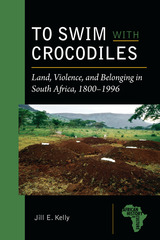 To Swim with Crocodiles: Land, Violence, and Belonging in South Africa, 1800-1996
Jill E Kelly
Michigan State University Press, 2018 To Swim with Crocodiles: Land, Violence, and Belonging in South Africa, 1800–1996 offers a fresh perspective on the history of rural politics in South Africa, from the rise of the Zulu kingdom to the civil war at the dawn of democracy in KwaZulu-Natal. The book shows how Africans in the Table Mountain region drew on the cultural inheritance of ukukhonza—a practice of affiliation that binds together chiefs and subjects—to seek social and physical security in times of war and upheaval. Grounded in a rich combination of archival sources and oral interviews, this book examines relations within and between chiefdoms to bring wider concerns of African studies into focus, including land, violence, chieftaincy, ethnic and nationalist politics, and development. Colonial indirect rule, segregation, and apartheid attempted to fix formerly fluid polities into territorial “tribes” and ethnic identities, but the Zulu practice of ukukhonza maintained its flexibility and endured. By exploring what Zulu men and women knew about and how they remembered ukukhonza, Kelly reveals how Africans envisioned and defined relationships with the land, their chiefs, and their neighbors as white minority rule transformed the countryside and local institutions of governance.
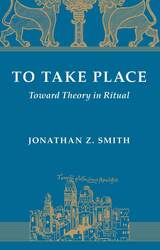 To Take Place: Toward Theory in Ritual
Jonathan Z. Smith
University of Chicago Press, 1987 In this broad-ranging inquiry into ritual and its relation to place, Jonathan Z. Smith prepares the way for a new approach to the comparative study of religion.
Smith stresses the importance of place—in particular, constructed ritual environments—to a proper understanding of the ways in which "empty" actions become rituals. He structures his argument around the territories of the Tjilpa aborigines in Australia and two sites in Jerusalem—the temple envisioned by Ezekiel and the Church of the Holy Sepulchre. The first of these locales—the focus of one of the more important contemporary theories of religious ritual—allows Smith to raise questions concerning the enterprise of comparison. His close examination of Eliade's influential interpretation of the Tjilpa tradition leads to a powerful critique of the approach to religion, myth, and ritual that begins with cosmology and the category of "The Sacred."
In substance and in method, To Take Place represents a significant advance toward a theory of ritual. It is of great value not only to historians of religion and students of ritual, but to all, whether social scientists or humanists, who are concerned with the nature of place.
"This book is extraordinarily stimulating in prompting one to think about the ways in which space, or place, is perceived, marked, and utilized religiously. . . . A provocative example of the application of humanistic geography to our understanding of what takes place in religion."—Dale Goldsmith, Interpretation
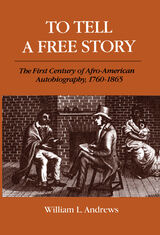 To Tell a Free Story: The First Century of Afro-American Autobiography, 1760-1865
William L. Andrews
University of Illinois Press, 1986 To Tell A Free Story traces in unprecedented detail the history of Black autobiography from the colonial era through Emancipation. Beginning with the 1760 narrative by Briton Hammond, William L. Andrews explores first-person public writings by Black Americans. Andrews includes but also goes beyond slave narratives to analyze spiritual biographies, criminal confessions, captivity stories, travel accounts, interviews, and memoirs. As he shows, Black writers continuously faced the fact that northern whites often refused to accept their stories and memories as sincere, and especially distrusted portraits of southern whites as inhuman. Black writers had to silence parts of their stories or rely on subversive methods to make facts tellable while contending with the sensibilities of the white editors, publishers, and readers they relied upon and hoped to reach.
To Tell At Last: Survival under False Identity, 1941-45
Blanca Rosenberg
University of Illinois Press, 1993 "Searing. . . . With
an even hand and understated prose, Ms. Rosenberg, now a New York City
psychotherapist, bravely depicts Nazi carnage in chilling detail."
-- Susan Shapiro, New York Times Book Review
"[A] harrowing account
of intrigue and danger with all the elements of a war movie adventure."
-- Miriam Rinn, The Forward
This memoir of how a Jewish
woman survived Nazi Germany by passing as an Aryan was selected as the
best book on Holocaust and Jewish Resistance Literature by the Israeli
committee of the Egit Grants.
 To Test or Not To Test: A Guide to Genetic Screening and Risk
Zallen, Dorris Teichler
Rutgers University Press, 2008 Tests are a standard part of modern medicine. We willingly screen our blood, urine, vision, and hearing, and submit to a host of other exams with names so complicated that we can only refer to them by their initials: PET, ECG, CT, and MRI. Genetic tests of our risks for disease are the latest trend in medicine, touted as an approach to informed and targeted treatment. They offer hope for some, but also raise medical, ethical, and psychological concerns for many including when genetic information is worth having. To Test or Not to Test arms readers with questions that should be considered before they pursue genetic screening. - Am I at higher risk for a disorder?
- Can genetic testing give me useful information?
- Is the timing right for testing?
- Do the benefits of having the genetic information outweigh the problems that testing can bring?
Determining the answers to these questions is no easy task. In this highly readable book, Doris Teichler Zallen provides a template that can guide individuals and families through the decision-making process and offers additional resources where they can gain more information. She shares interviews with genetic specialists, doctors, and researchers, as well as the personal stories of nearly 100 people who have faced genetic-testing decisions. Her examples focus on genetic testing for four types of illnesses: breast/ovarian cancer (different disorders but closely connected), colon cancer, late-onset Alzheimer's disease, and hereditary hemochromatosis. From the more common diseases to the rare hereditary conditions, we learn what genetic screening is all about and what it can tell us about our risks. Given that we are now bombarded with ads in magazines and on television hawking the importance of pursuing genetic-testing, it is critical that we approach this tough issue with an arsenal of good information. To Test or Not to Test is an essential consumer tool-kit for the genetic decision-making process.
 To the Arctic!: The Story of Northern Exploration from Earliest Times
Jeannette Mirsky
University of Chicago Press, 1970 "Who Reached the North Pole First?" A recent article in the New York Times (February 17, 1997) presented new evidence from the journals of Admiral Robert E. Peary and Dr. Frederick A. Cook that sheds light on this long-argued debate. Questioning whether the journal entries are truthful, new theories indicate that neither explorer was first, despite their individual claims. To the Arctic contributes valuable information to this debate in its lively narrative of Arctic exploration from the time of the ancient Greeks to the mid-1940s. Revealing stories of the many men who attempted to map the lands or search for means to live there, Mirsky describes the weather and resources they encountered, the temptations and odds of success, and the role of nationalism and individual character in the many conflicting accounts of Arctic exploration.
"Excellent. . . . This is a book which anyone interested in almost any facet of the north will find of value."—William Cody, Canadian Field Naturalist
"A book filled with adventure."—Daily News Journal
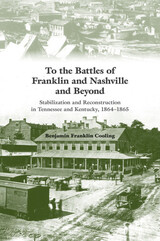 To the Battles of Franklin and Nashville and Beyond: Stabilization and Reconstruction in Tennessee and Kentucky, 1864–1865
Benjamin Franklin Cooling
University of Tennessee Press, 2011
“Benjamin Franklin Cooling has produced a triumphant third volume to his definitive study of Tennessee and Kentucky in the Civil War. Like his first two volumes, this one perfectly integrates the home front and battlefield, demonstrating that civilians were continually embroiled in the war in intense ways comparable to and often surpassing the violence experienced by soldiers on the battlefield. The impacts of armies, guerrillas, and other military forces on civilians was continual, terrifying, and brutal in nearly all parts of the Confederacy’s Heartland.” —T. Michael Parrish, Linden G. Bowers Professor of American History, Baylor University
“Cooling’s scholarship is indeed sound and based on extensive research in a variety of original sources that range from manuscript collections to newspapers, with an exhaustive list of secondary sources. His work represents the first new interpretations of this important part of the war in decades.” —Archie P. McDonald, Regent’s Professor and Community Liaison, Stephen F. Austin State University
In two preceding volumes, Forts Henry and Donelson and Fort Donelson’s Legacy, Benjamin Franklin Cooling offered a sweeping portrayal of war and society in the upper southern heartland of Kentucky and Tennessee during the first two and a half years of the Civil War. This book continues that saga as Cooling probes the profound turmoil—on the battlefield, on the home front, within the shadow areas where lawlessness reigned—that defined the war in the region as it ground to its close.
By 1864 neither the Union’s survival nor the South’s independence was any more apparent than at the beginning of the war. The grand strategies of both sides were still evolving, and Tennessee and Kentucky were often at the cusp of that work. With his customary command of myriad sources, Cooling examines the heartland conflict in all its aspects: the Confederate cavalry raids and Union counteroffensives; the harsh and punitive Reconstruction policies that were met with banditry and brutal guerrilla actions; the disparate political, economic, and sociocultural upheavals; the ever-growing war weariness of the divided populations; and the climactic battles of Franklin and Nashville that ended the Confederacy’s hopes in the Western Theater. Especially notable in this volume is Cooling’s use of the latest concepts of “hybrid” or “compound war” that national security experts have applied to the twenty-first-century wars in Iraq and Afghanistan—a mode of analysis that explores how catastrophic terrorism and disruptive lawlessness mix with traditional combat and irregular operations to form a new kind of warfare. Not only are such concepts relevant to the historical study of the Civil War in the heartland, Cooling suggests, but by the same token, their illumination of historical events can only enrich the ways in which policymakers view present-day conflicts.
In chronicling Tennessee and Kentucky’s final rite of passage from war to peace, To the Battles of Franklin and Nashville and Beyond is in every way a major contribution to Civil War literature by a masterful historian.
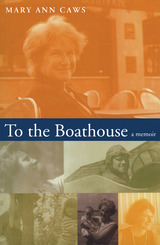 To the Boathouse: A Memoir
Mary Ann Caws
University of Alabama Press, 2008 From Southern roots to scholarly heights—one woman’s journey to find peace, purpose, and her place in the world. A neat and lavish, if constricting, childhood in the lush landscapes of North Carolina. Summers at a calm, remote beach house. A proper and religiously influenced prep school in Washington. Years at Bryn Mawr, an impulsive study trip to Paris, further education at Yale, married life, and divorced life. These are the settings for Mary Ann Caws’s passionate memoir, in which she recounts the highs and lows of her journey through life. Marked by complicated relationships and a passion for learning, Caws’s story is one that resonates not only with writers like herself, but with all who have struggled with determining their path within the surrounding world.
Caws writes of her formal, stylish parents, her rebellious and deeply admired sister, and her artistic grandmother, whom she respected and idolized more than anyone else. She describes her marriage and subsequent divorce, her bouts with therapy, her children, and her growth as a student and writer. Throughout the memoir is evidence of her love for writing, teaching, art, and poetry as well as her deep respect for the people in her life that ultimately guided her into her career.
Mary Ann Caws describes Southern society and her own life with fondness, nostalgia, and a tinge of honest criticism. The carefully selected details and delicate balance of sentiment and fact bring readers into the fascinating, complicated, and all-too-real world of Caws’s—and our own—past.
 To the Bone: NEW AND SELECTED POEMS
Sydney Lea
University of Illinois Press, 1996 This is the first comprehensive study in the English language of the commentaries of Didymus the Blind, who was revered as the foremost Christian scholar of the fourth century and an influential spiritual director of ascetics.
The writings of Didymus were censored and destroyed due to his posthumous condemnation for heresy. This study recovers the uncensored voice of Didymus through the commentaries among the Tura papyri, a massive set of documents discovered in an Egyptian quarry in 1941.
This neglected corpus offers an unprecedented glimpse into the internal workings of a Christian philosophical academy in the most vibrant and tumultuous cultural center of late antiquity. By exploring the social context of Christian instruction in the competitive environment of fourth-century Alexandria, Richard A. Layton elucidates the political implications of biblical interpretation.
Through detailed analysis of the commentaries on Psalms, Job, and Genesis, the author charts a profound tectonic shift in moral imagination as classical ethical vocabulary becomes indissolubly bound to biblical narrative. Attending to the complex interactions of political competition and intellectual inquiry, this study makes a unique contribution to the cultural history of late antiquity.
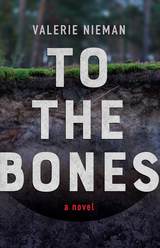 To the Bones
VALERIE NIEMAN
West Virginia University Press, 2019 2020 Killer Nashville Silver Falchion Award finalist
Darrick MacBrehon, a government auditor, wakes among the dead. Bloodied and disoriented from a gaping head wound, the man who staggers out of the mine crack in Redbird, West Virginia, is much more powerful—and dangerous—than the one thrown in. An orphan with an unknown past, he must now figure out how to have a future. Hard-as-nails Lourana Taylor works as a sweepstakes operator and spends her time searching for any clues that might lead to Dreama, her missing daughter. Could this stranger’s tale of a pit of bones be connected? With help from disgraced deputy Marco DeLucca and Zadie Person, a local journalist investigating an acid mine spill, Darrick and Lourana push against everyone who tries to block the truth. Along the way, the bonds of love and friendship are tested, and bodies pile up on both sides. In a town where the river flows orange and the founding—and controlling—family is rumored to “strip a man to the bones,” the conspiracy that bleeds Redbird runs as deep as the coal veins that feed it.
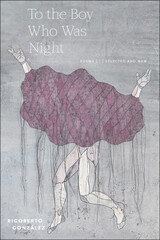 To the Boy Who Was Night: Poems: Selected and New
Rigoberto González
Four Way Books, 2023 The capstone of a quarter-century career in poetry, To the Boy Who Was Night collects the poetry published by Rigoberto González since 1999, including selections from five previous books as well as new work. Mirroring González’s personal trajectory, the arc of this work articulates the course of a life: these poems recall leaving a beloved homeland, confront masculinity and sexuality in new adulthood, imagine the earth devoid of human inhabitants, descend into the realm of ghosts, and return to arrive at Dispatches from the Broken World. This latest section ventures into foreign terrain — an autobiographical confrontation with isolation and the aging body. His lyrical exploration, like the weather reports scrawled on ancient temple walls, will preserve this age-old message: “likely a poem, surely an epitaph.” To the Boy Who Was Night bears the fruit of 25 years of poetry, González’s boldest and most comprehensive volume yet.
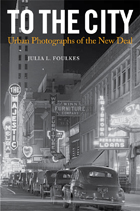 To The City: Urban Photographs of the New Deal
Authored by Julia L. Foulkes
Temple University Press, 2011 In the 1930s and 1940s, as the United States moved from a rural to an urban nation, the pull of the city was irrepressible. It was so strong that even a photographic mission designed to record the essence of rural America could not help but capture the energy of urbanization too. To the City showcases over 100 photographs from the Farm Security Administration (FSA) project along with extracts from the Works Progress Administration (WPA) guidebooks and oral histories, to convey the detail and dimensions of that transformation. This artfully grouped collection of photographs includes magnificent images by notable photographers Dorothea Lange, Walker Evans and Gordon Parks, among many others. Foulkes organizes this history of Americana into five themes: Intersection; Traffic; High Life and Low Life; The City in the Country; and Citizens to illuminate the changes in habits, landscapes, and aspirations that the march to cities encompassed. As the rural past holds symbolic sway and the suburb presents demographic force, the urban portion of our history—why and how cities have been a destination for hope—recedes from view. To the City is a thoughtful, engaging reminder.
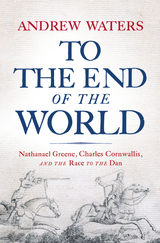 To the End of the World: Nathanael Greene, Charles Cornwallis, and the Race to the Dan
Andrew Waters
Westholme Publishing, 2023 A Stranded American Army, a Relentless Enemy, and a Thrilling Pursuit and Escape that Changed the Outcome of the American Revolution
“In the most barren inhospitable unhealthy part of North America, opposed by the most savage, inveterate perfidious cruel Enemy, with zeal and with Bayonets only, it was resolv’d to follow Green’s Army, to the end of the World.” So wrote British general Charles O’Hara about the epic confrontation between Nathanael Greene and Charles Cornwallis during the winter of 1780-81. Only Greene’s starving, threadbare Continentals stood between Cornwallis and control of the South—and a possible end to the American rebellion. Burning their baggage train so that they could travel more quickly, the British doggedly pursued Greene’s bedraggled soldiers, yet the rebels remained elusive. Daniel Morgan’s stunning victory at Cowpens over a superior British force set in motion the “Race to the Dan,” Greene’s month-long strategic retreat across the Carolinas. In constant rain and occasional snow, Greene’s soldiers—tracking the ground with their bloody feet—bound toward a secret stash of boats on the Dan River. Just before Cornwallis could close his trap, the Continentals crossed into Virginia and safety. Greene’s path featured three near-miss river escapes, the little-known Battle of Cowan’s Ford, and a final chase so close that the fate of the American South—and the American effort—rested on one wrong British move.
With a background section on the Southern theater in 1780, and a summary outlining the lives and careers of its important officers, To the End of the World: Nathanael Greene, Charles Cornwallis, and the Race to the Dan is a carefully documented and beautifully written account of this extraordinary chapter of American history. The book not only showcases the incredible dramatics of the American Revolution’s “Great Escape,” but also provides a compelling look at the psychological and intellectual distinctions between its two great generals, Greene and Cornwallis.
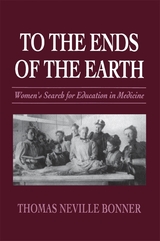 To the Ends of the Earth: Women’s Search for Education in Medicine
Thomas Bonner
Harvard University Press, 1992 In this engagingly written book Thomas Bonner unveils the dramatic story of women’s long struggle to become physicians. Focusing both on international comparisons and on the personal histories of many of the pioneers, their determination and dedication, their setbacks and successes, he shows how European and American women gradually broke through the wall of resistance to women in medicine. In pre–Civil War America, in Tsarist Russia, in Victorian England, special schools of medicine for women were widely established as early as 1850 as a kind of way-station on the road to medical coeducation. Only in Switzerland and France, at first, could women study medicine in classes with men. As a result, hundreds and then thousands of women from Russia, Eastern Europe, England, and the United States enrolled in Swiss or Parisian universities to gain the first-class education that was denied them at home. Coming almost literally from “the ends of the earth,” they formed the largest migration of professional women in history.
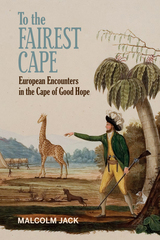 To the Fairest Cape: European Encounters in the Cape of Good Hope
Jack, Malcolm
Bucknell University Press, 2019 Crossing the remote, southern tip of Africa has fired the imagination of European travellers from the time Bartholomew Dias opened up the passage to the East by rounding the Cape of Good Hope in 1488. Dutch, British, French, Danes, and Swedes formed an endless stream of seafarers who made the long journey southwards in pursuit of wealth, adventure, science, and missionary, as well as outright national, interest. Beginning by considering the early hunter-gatherer inhabitants of the Cape and their culture, Malcolm Jack focuses in his account on the encounter that the European visitors had with the Khoisan peoples, sometimes sympathetic but often exploitative from the time of the Portuguese to the abolition of slavery in the British Empire in 1833. This commercial and colonial background is key to understanding the development of the vibrant city that is modern Cape Town, as well as the rich diversity of the Cape hinterland.
Published by Bucknell University Press. Distributed worldwide by Rutgers University Press.
To the Golden Cities: Pursuing the American Jewish Dream in Miami and L.A
Deborah Dash Moore
Harvard University Press The first great modern migration of the Jewish people, from the Old World to America, has been often and expertly chronicled, but until now the second great wave of Jewish migration has been overlooked. After World War II, spurred by a postwar economic boom, American Jews sought new beginnings in the nation's South and West. There, they shaped a new, postwar style of American Judaism for the second half of the twentieth century. Today these sun-soaked, entrepreneurial communities contribute greatly to the American Jewish landscape. In this book, the vibrant Jewish culture of Los Angeles and Miami comes to life through Moore's skillful weaving of individual voices, dreams, and accomplishments.
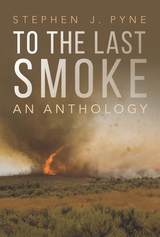 To the Last Smoke: An Anthology
Stephen J. Pyne
University of Arizona Press, 2020 From boreal Alaska to subtropical Florida, from the chaparral of California to the pitch pine of New Jersey, America boasts nearly a billion burnable acres. In nine previous volumes, Stephen J. Pyne has explored the fascinating variety of flame region by region. In To the Last Smoke: An Anthology, he selects a sampling of the best from each. To the Last Smoke offers a unique and sweeping view of the nation’s fire scene by distilling observations on Florida, California, the Northern Rockies, the Great Plains, the Southwest, the Interior West, the Northeast, Alaska, the oak woodlands, and the Pacific Northwest into a single, readable volume. The anthology functions as a color-commentary companion to the play-by-play narrative offered in Pyne’s Between Two Fires: A Fire History of Contemporary America. The series is Pyne’s way of “keeping with it to the end,” encompassing the directive from his rookie season to stay with every fire “to the last smoke.”
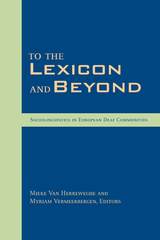 To the Lexicon and Beyond: Sociolinguistics in European Deaf Communities
Mieke Van Herreweghe
Gallaudet University Press, 2004 Volume 10 of the series explores sociolinguistics in various European Deaf communities. Editors Van Herreweghe and Vermeerbergen present a wide array of research inspired by the Sociolinguistics Symposium 14 held at Ghent University, Belgium, in April 2002. Noted contributors from Finland, Belgium, Ireland, the Netherlands, Germany, Sweden, Spain and the United Kingdom offer insights gleaned from the languages of their countries.
Part One of this five-part volume investigates multilingualism and language contact among Finland-Swedish Deaf People. Part Two looks at regional variation and the evolution of signs in Flemish Sign Language, as well as gender-influenced variation in Irish Sign Language. Language policy and planning receives consideration in the third part, with a study of sign language lexical variation in the Netherlands and an analysis of the risks of codification in Flemish Sign Language. Part Four examines the implementation of bilingual programs for deaf students throughout Europe, and updates research on language use visually oriented in Swedish Deaf education classrooms.
The final part of To the Lexicon and Beyond: Sociolinguistics in European Deaf Communities presents data on language attitudes, including a census of sign language users in Spain that reveal a changing language community. The last chapter of this fascinating assembly assays British Deaf communities and language identity in relation to issues of transnationality in the 21st century.
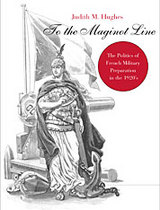 To the Maginot Line: The Politics of French Military Preparation in the 1920’s
Judith M. Hughes
Harvard University Press, 1971 “[A] stimulating and excellently documented book…Individual personalities are particularly well handled. Foch and Pétain, Poincaré and Blum—all emerge with veritable life in them. The trends of French interwar history are deftly carried through onto these pages with an unobtrusive lucidity and persuasiveness.”—Michael Hurst, American Historical Review
“Admirable…Instead of working backward from 1940, seeking causes and culprits of collapse in the 1930s, Ms. Hughes has wisely chosen to begin in 1918 and to focus upon the 1920s. This chronology has given her a fresher perspective and a wider scope for sympathy than other commentators of the period. It is the great merit of this book that it passes judgments with compassion and restraint. Indeed, Professor Hughes insists upon viewing French military policy in the broadest possible context of international developments, domestic politics, economic problems, and intellectual moods; from these elements, she weaves a dilemma of tragic dimensions in which the confusions and mistakes of individuals are reviewed with kindness and realism.”—Charles C. Bright, Political Science Quarterly
The decision to fortify northeastern France has usually been considered a tragic mistake, an example of bad planning and missed opportunities. Not so, says Judith M. Hughes, who provides a convincing view of how France’s military and political leaders tried to safeguard their nation—and why they failed.
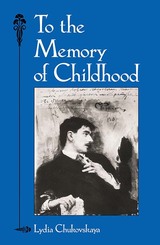 To the Memory of Childhood
Lydia Chukovskaya
Northwestern University Press, 1988 For years Lydia Chukovskaya's support for persecuted writers cut her off from her own audience. Even her name was banned in the USSR, and she was expelled from the Union of Writers in 1974. Though unable to publish at home and cut off from contacts with readers and editors, Chukovskaya continued to write. To the Memory of Childhood, her loving chronicle of growing up beside the Gulf of Finland with her father, the writer Kornei Chukovsky, reveals the sources of her strength and her belief in the power of the written word.
Her father is a household name in Russia because of his tales in verse for children. But his literary accomplishments ranged far beyond bedtime stories. As a critic he wrote controversial articles and lively profiles of cultural figures; as a translator he introduced Whitman, Twain, Kipling, and Wilde to Russian readers. When his children's literature was attacked in the 1920s and 1930s, he turned to editing, scholarship, and articles on translation. A man of boundless energy, he played a vital role in his country's cultural life until his death in 1969. "I am not writing Kornei Ivanovich's biography," Chukovskaya says, "but he was the author of my childhood."
 To the Mormon Newlyweds Who Thought the Bellybutton Was Somehow Involved
Deja Earley
Signature Books, 2018 This extraordinary poetry collection opens with the author as a little girl delighted with the jewelry being sold by a vendor along the beach, unaware that the bowtied rabbit earrings symbolize the Playboy empire.
In navigating her life as a free-spirited Mormon, each of Earley’s poems expresses the tension she feels in adhering to and expanding the confines of her faith. From awkward first kisses shared on a church couch to refusing to talk to men who are not Mormon “lest I fall from grace, on my ass,” her poems remain funny, wry, thoughtful. Despite the promise not to talk to non-Mormon men, her final poems detail her marriage to a Catholic husband who offers Hail Mary prayers after a lost pregnancy while she struggles to find comfort from an elusive Mother in Heaven. Despite their differences and moments of heartache, they thrive, allowing themselves to “imagine we’re floating in bright bubbles of light.” It is an emotional roadmap for anyone else facing such tensions, joys, and accommodations.
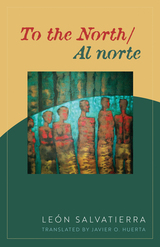 To the North/Al norte: Poems
Leon Salvatierra
University of Nevada Press, 2022 The University of Nevada Press is pleased to publish its first dual-language (Spanish-English) book of poetry, To the North/Al norte: Poems, by the Nicaraguan poet León Salvatierra. The work is rooted in the Central American diaspora that emerged from the civil wars in the 1980s. The poems are tied together through the experiences, memories, visions, and dreams of a 15-yearold boy who embarked on a journey to the United States with a group of forty other migrants from Central America. After being undocumented for eleven years, Salvatierra established himself in the United States, first becoming a naturalized citizen and then obtaining a university education.
Salvatierra mixes lyrical and prose poems to explore the experience of exile in a new country. His powerful metaphors and fresh images inhabit spaces fraught with the violence, anxiety, and vulnerability that undocumented Central American migrants commonly face in their transnational journeys. His vivid memories of Nicaragua tie the personal experiences of his poetic subjects to the geopolitical history between the Central American region and the United States.
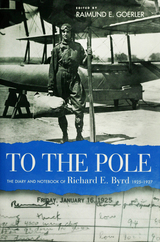 TO THE POLE: The Diary and Notebook of Richard E. Byrd, 1925–1927
Edited by Raimund E. Goerler
Ohio State University Press, 1998 On May 9, 1926, Richard E. Byrd announced to the world that he and copilot Floyd Bennett were the first to fly an airplane over the North Pole. Documents published here for the first time provide new insights into this most controversial accomplishment of Byrd's career. Some journalists at the time questioned whether Byrd's airplane, the Josephine Ford, could have reached the North Pole and returned in less than sixteen hours. More questions arose after Byrd's death in 1957. A Swedish meteorologist concluded that the Josephine Ford would have needed a beneficial wind to accomplish the feat, and his study of weather data indicated that there had been no such wind. In 1973 another author reported that Byrd's pilot had later confessed to Bernt Balchen, a Norwegian pilot who had assisted Byrd, that they had only circled on the horizon out of sight of reporters and landed when enough time had passed to claim the North Pole. To the Pole presents transcriptions of Byrd's handwritten diary and notebook, which were discovered by Ohio State University archivist Raimund Goerler in 1996 when he was cataloging Byrd's papers for the university. In his diary Byrd recorded his preparations for the North Pole flight, and he used it as a message pad to communicate with his pilot when the deafening noise from the plane's engines rendered verbal communication impossible. Byrd also wrote his navigational calculations on the leaves of his diary, and photographs of these crucial pages are presented in the book as well, along with a copy of Byrd's official report on the expedition to the National Geographic Society.
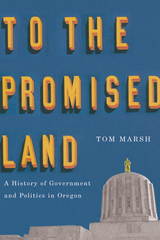 To the Promised Land: A History of Government and Politics in Oregon
Tom Marsh
Oregon State University Press, 2012 The first comprehensive political history of Oregon, To the Promised Land also examines the social and economic changes the state has pioneered during its almost two hundred years. Highlighting major political figures, campaigns, ballot measures, and the history of legislative sessions, Tom Marsh traces the evolution of Oregon from incorporated territory to a state at the forefront of national environmental and social movements.
From Jason Lee’s first letter urging Congress to take possession of the Oregon Country to John Kitzhaber’s precedent-setting third term as governor, from the land frauds of the early 20th century to the state’s land-use planning goals, from the Beach Bill to the Bottle Bill, this book tells Oregon’s story.
Featuring interesting trivia, historical photographs, and biographical sketches of key politicians, To the Promised Land is an essential volume for readers interested in Oregon’s history.
 To the Third Empire: Ibsen’s Early Drama
Brian Johnston
University of Minnesota Press, 1980 To the Third Empire was first published in 1980. Minnesota Archive Editions uses digital technology to make long-unavailable books once again accessible, and are published unaltered from the original University of Minnesota Press editions. Critical acclaim greeted Brian Johnston's 1975 book on Ibsen's final phase, The Ibsen Cycle. Choice called it "the single most provocative and critically exciting books of Ibsen criticism in decades." Johnston now turns his attention to the early works, using the same thematic premise - that the plays follow a clear progression, influenced by the Hegalian aesthetic that pervaded Europe in the mid-nineteenth century. The result is an explanation of the early career that demonstrates both its unity and its essential relation to the realistic cycle that followed. In advancing his argument Johnston provides close readings of ten plays, ranging from Cataline to Emperor and Galilean and including Brand and Peer Gynt. Scholars and students of drama, comparative literature, and Ibsen studies will find To the Third Empire an essential work.
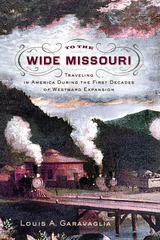 To the Wide Missouri: Traveling in America During the First Decades of Westward Expansion
Louis A. Garavaglia
Westholme Publishing, 2011 The Fascinating History of the Rapid Expansion of Roads, Canals, and Railways in the First Decades of the United States
While the great overland migration routes to America’s far west are well known and documented—the California, Oregon, Mormon, and Santa Fe Trails, the Central Overland and Pony Express—less attention has been given to how Americans in the first decades of the republic traveled across the western frontiers of the original colonies. Following the revolution, Americans began to seek their fortunes to the west in greater numbers. Land grants to veterans inspired others to move, including tradesmen, merchants, and tavern owners. With the Louisiana Purchase in 1803, the country doubled in size, and the rate of migration became extraordinary, with wider and more durable roads built, ferries installed at river crossings, canals cut to move goods, regular stage routes established, and ultimately the first railroad tracks laid down. Entire regions that supported few communities in the 1790s exploded in population, and as a result seven new states were admitted to the Union in the decade following the War of 1812. John Bradbury, who traveled through the United States between 1809 and 1811, wrote that “In passing through the upper parts of Virginia, I observed a great number of farms that had been abandoned, on many of which good houses had been erected, and fine apple and peach orchards had been planted. On enquiring the reason, I was always informed that the owners had gone to the western country.” In Maryland, a newspaper reporter wrote, “The time is close at hand when the region west of the Allegheny mountains will sway the destinies of the nation.” By 1839, the National Road extended more than 700 miles from Washington, DC, to central Illinois, New York’s Erie Canal operated from Albany to Buffalo, and the Baltimore and Ohio Railroad carried passengers briskly west, ultimately to the Ohio River. To the Wide Missouri: Traveling in America During the First Decades of Westward Expansion by Louis Garavaglia covers the routes and methods that emigrants used to reach the west in the forty-year period following the Louisiana Purchase. Using contemporary maps and the graphic descriptions found in diaries, journals, letters, and newspaper accounts, the author details not only the land and water routes that led settlers to the western country, but also illustrates the hardship, perseverance, humor, and romance that colored their journey.
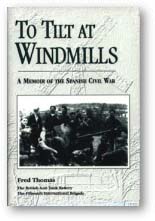 To Tilt at Windmills: A Memoir of the Spanish Civil War
Fred A. Thomas
Michigan State University Press, 1996 To Tilt at Windmills is the memoir of Briton Fred Thomas who served with the International Brigades in the Spanish Civil War (July 1936-March 1939).
Inspired by a memorable return to Iberian battlefields forty years later, and based on diaries kept during the many months Thomas spent as a gunner with the British Anti-Tank Battery, the narrative moves eloquently along a journey into the war zone, through the several campaigns in which he fought and where he was twice wounded, and finally to the withdrawal of the Brigades from the conflict. What distinguishes Thomas' account is the remarkable detail provided by the diaries and the measured tone of his reminiscence, There is, as well, the poignant inquiry of the veteran into the shape and meaning of experience as a young soldier. The historian Paul Preston has cited the "warmth, directness and deep humanity" of To Tilt at Windmills, "an important contribution to the collective memory of the war.
To Train His Soul in Books: Syriac Asceticism in Early Christianity
Robin Darling Young
Catholic University of America Press, 2011 To Train His Soul in Books explores numerous aspects of this rich religious culture, extending previous lines of scholarly investigation and demonstrating the activity of Syriac-speaking scribes and translators busy assembling books for the training of biblical interpreters, ascetics, and learned clergy.
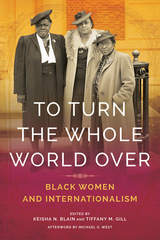 To Turn the Whole World Over: Black Women and Internationalism
Edited by Keisha N. Blain and Tiffany M. Gill
University of Illinois Press, 2019 Black women undertook an energetic and unprecedented engagement with internationalism from the late nineteenth century to the 1970s. In many cases, their work reflected a complex effort to merge internationalism with issues of women's rights and with feminist concerns. To Turn the Whole World Over examines these and other issues with a collection of cutting-edge essays on black women's internationalism in this pivotal era and beyond. Analyzing the contours of gender within black internationalism, scholars examine the range and complexity of black women's global engagements. At the same time, they focus on these women's remarkable experiences in shaping internationalist movements and dialogues. The essays explore the travels and migrations of black women; the internationalist writings of women from Paris to Chicago to Spain; black women advocating for internationalism through art and performance; and the involvement of black women in politics, activism, and global freedom struggles. Contributors: Nicole Anae, Keisha N. Blain, Brandon R. Byrd, Stephanie Beck Cohen, Anne Donlon, Tiffany N. Florvil, Kim Gallon, Dayo F. Gore, Annette K. Joseph-Gabriel, Grace V. Leslie, Michael O. West, and Julia Erin Wood
To Us, All Flowers Are Roses: POEMS
Lorna Goodison
University of Illinois Press, 1995 Writing in The Hudson Review,
David Mason has characterized Lorna Goodison's work as a "revelation
to me, much of it beautiful for its simple negotiation of the line between
life and art."
One of the most distinguished
contemporary poets of the Caribbean, Goodison draws on both African and
European inheritances in her finely crafted poems, which often carry a
sense of language's healing power in the face of the pain of the past.
She deals thematically with the struggle of Caribbean women and writes
in a fashion that has developed from conversational to more ritualistic.
From reviews of Goodison's
earlier works:
"The evocative power
of Lorna Goodison's poetry derives its urgency and appeal from the heart-and-mind
concerns she has for language, history, racial identity, and gender."
Andrew Salkey -- World Literature Today
"A marvelous poet, one
to savor and to chant aloud."
-- Pat Monaghan, Booklist
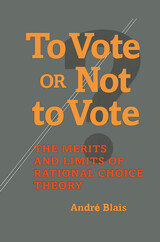 To Vote or Not to Vote: The Merits and Limits of Rational Choice Theory
Andre Blais
University of Pittsburgh Press, 2000
What makes people decide to vote? In addressing this simple question, André Blais examines the factors that increase or decrease turnout at the aggregate, cross-national level and considers what affects people’s decision to vote or to abstain. In doing so, Blais assesses the merits and limitations of the rational choice model in explaining voter behavior. The past few decades have witnessed a rise in the popularity of the rational choice model in accounting for voter turnout, and more recently a groundswell of outspoken opposition to rational choice theory.
Blais tackles this controversial subject in an engaging and personal way, bringing together the opposing theories and literatures, and offering convincing tests of these different viewpoints. Most important, he handles the discussion in a clear and balanced manner. Using new data sets from many countries, Blais concludes that while rational choice is an important tool—even when it doesn’t work—its empirical contribution to understanding why people vote is quite limited.
Whether one supports rational choice theory or opposes it, Blais’s evenhanded and timely analysis will certainly be of interest, and is well-suited for advanced undergraduate and graduate-level classes.
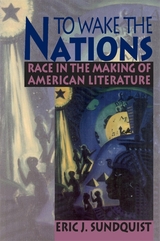 To Wake the Nations: Race in the Making of American Literature
Eric J. Sundquist
Harvard University Press, 1993 This powerful book argues that white culture in America does not exist apart from black culture. The revolution of the rights of man that established this country collided long ago with the system of slavery, and we have been trying to reestablish a steady course for ourselves ever since. To Wake the Nations is urgent and rousing: we have integrated our buses, schools, and factories, but not the canon of American literature. That is the task Eric Sundquist has assumed in a book that ranges from politics to literature, from Uncle Remus to African American spirituals. But the hallmark of this volume is a sweeping reevaluation of the glory years of American literature—from 1830 to 1930—that shows how white literature and black literature form a single interwoven tradition.
By examining African America’s contested relation to the intellectual and literary forms of white culture, Sundquist reconstructs the main lines of American literary tradition from the decades before the Civil War through the early twentieth century. An opening discussion of Nat Turner’s “Confessions,” recorded by a white man, Thomas Gray, establishes a paradigm for the complexity of meanings that Sundquist uncovers in American literary texts. Focusing on Frederick Douglass’s autobiographical books, Herman Melville’s Benito Cereno, Martin Delany’s novel Blake; or the Huts of America, Mark Twain’s Pudd’nhead Wilson, Charles Chesnutt’s fiction, and W. E. B. Du Bois’s The Souls of Black Folk and Darkwater, Sundquist considers each text against a rich background of history, law, literature, politics, religion, folklore, music, and dance. These readings lead to insights into components of the culture at large: slavery as it intersected with postcolonial revolutionary ideology; literary representations of the legal and political foundations of segregation; and the transformation of elements of African and antebellum folk consciousness into the public forms of American literature.
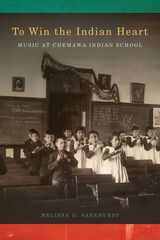 To Win the Indian Heart: Music at Chemawa Indian School
Melissa D. Parkhurst
Oregon State University Press, 2014 Since 1879, Indian children from all regions of the United States have entered federal boarding schools—institutions designed to assimilate them into mainstream society. Chemawa Indian School in western Oregon, one of the nation’s oldest and the longest still in continuous operation, is an emblem of a system that has intimately impacted countless lives and communities.
In To Win the Indian Heart: Music at Chemawa Indian School, Melissa Parkhurst records the history of the school’s musical life. She explores the crucial role music was meant to play in the total transformation of Indian children, and the cultural recovery and resiliency it often inspired instead. Parkhurst chronicles the complex ways in which students, families, faculty, and administrators employed music, both as a tool for assimilation and, conversely, as a vehicle for student resistance—a subject long overlooked in literature on Indian education and the assimilation campaign.
Combining oral histories of Chemawa alumni with archival records of campus life, the book examines the prominent forms of music making at Chemawa—school band, choirs, private lessons, pageants, dance, garage bands, and powwows. Parkhurst traces the trajectory of federal Indian policy, highlighting students’ creative responses and the ways in which music reveals the inherent contradictions in the U.S. government’s assimilation practices.
To You I Call: Psalms Throughout Our Lives
Rabbi Jade Sank Ross
Central Conference of American Rabbis, 2024 Psalms have been part of Jewish ritual and liturgy for centuries, expressing praise to God, feelings of sorrow and longing, and much more. Rabbi Jade Sank Ross’s To You I Call is an invitation to make the ancient words of psalms part of our daily lives. The book pairs seventy-two psalms with a range of life moments, from giving birth to retirement to experiencing antisemitism—times of grief and gratitude, anticipation and despair, pain and relief. Rabbi Sank Ross’s original, authentic framing and Rabbi Richard N. Levy’s beautiful, contemporary translations let readers forge a deep and personal connection with the words of the Psalmist. With sensitivity and vulnerability, To You I Call brings the psalms to life for our lives, today.
 To Your Posts!: Fort Meigs in the War of 1812 through the Voices of Those Who Fought There
Larry L. Nelson
Michigan State University Press, 2025 To Your Posts! Fort Meigs in the War of 1812 through the Voices of Those Who Fought There recounts the history of Fort Meigs, a U.S. military garrison built on the outermost reaches of Ohio’s northwestern frontier during the War of 1812. Troops commanded by William Henry Harrison erected the fort in the late winter and early spring of 1813. Built at the foot of the Maumee River Rapids, the site of present-day Perrysburg in Wood County, the post successfully withstood two determined sieges by allied British, Canadian, and Native forces later that year. Those victories, resulting in the garrison’s continued American occupation throughout 1815, contributed significantly to the United States’ eventual successes in the Detroit Theater at the end of the war. Using numerous primary sources including letters, diaries, and other documents from the period, many published here for the first time, To Your Posts! tells the story of Fort Meigs through the voices of those who served at the post during the War of 1812.
To Zenzi
Robert L. Shuster
New Issues Poetry and Prose, 2021 To Zenzi is the extraordinary story of Tobias Koertig’s odyssey through the apocalypse of Berlin in 1945. An orphaned thirteen-year-old who loves to draw, Tobias is coerced into joining the German youth army in the last desperate weeks of the war. Mistaken for a hero on the Eastern Front, he receives an Iron Cross from Hitler himself, who discovers the boy’s cartoons and appoints Tobias to sketch pictures of the ruined city.
Shuttling between the insanity of the Führer’s bunker and the chaotic streets, Tobias must contend with a scheming Martin Bormann, a deceitful deserter, the Russian onslaught, and his own compounding despair—all while falling for Zenzi, a girl of Jewish descent (a mischling) who relays secret news of death camps and convinces Tobias to make a treacherous escape to the Americans.
With thrilling risks in plotting and prose, with moments of pathos and absurdity, Shuster richly conjures a mad, tragic world.
A Toast to Horace
Edward Kennard Rand
Harvard University Press There is magic in this brief appreciation of Horace, his poetry and his outlook on life; for the reader is irresistibly compelled to put out his hand and take down either the original or a translation of Horace’s works. If any words of any modern man can keep alive the memory of an ancient, certainly Mr. Rand’s will do so. We wish that everyone pretending to literary taste could be required to read the essay.
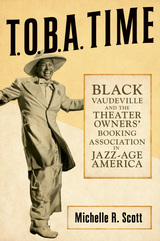 T.O.B.A. Time: Black Vaudeville and the Theater Owners’ Booking Association in Jazz-Age America
Michelle R. Scott
University of Illinois Press, 2023 Black vaudevillians and entertainers joked that T.O.B.A. stood for “tough on black artists.” But the Theater Owner’s Booking Association (T.O.B.A.) played a foundational role in the African American entertainment industry and provided a training ground for icons like Cab Calloway, Bessie Smith, Ethel Waters, Sammy Davis Jr., the Nicholas Brothers, Count Basie, and Butterbeans and Susie. Michelle R. Scott’s institutional history details T.O.B.A.’s origins and practices while telling the little-known stories of the managers, producers, performers, and audience members involved in the circuit. Looking at the organization over its eleven-year existence (1920–1931), Scott places T.O.B.A. against the backdrop of what entrepreneurship and business development meant in black America at the time. Scott also highlights how intellectuals debated the social, economic, and political significance of black entertainment from the early 1900s through T.O.B.A.’s decline during the Great Depression. Clear-eyed and comprehensive, T.O.B.A. Time is a fascinating account of black entertainment and black business during a formative era.
Toby Snax
Written and illustrated by Kristin Hersh
University of Texas Press, 2016 Toby Snax is a little bunny who’s reluctant to experience things away from home. When Mama asks him to join her on a trip, he needs a bit of encouragement. So Mama tells Toby about the wondrous things that await him out in the wide world, helping him to look forward to new adventures. This charming, gentle book will resonate with any child who’s nervous about trying new things. The acclaimed musician Kristin Hersh created Toby Snax to encourage her son, Bodhi, to embrace the experiences of touring the world together while she performed both solo and with her bands 50 Foot Wave and Throwing Muses. The first edition of the book sold out immediately and has become highly collectible. This new edition makes Toby Snax available again for all fans of Hersh’s evocative storytelling, as well as children—or even adults—who need a little reassurance that the world is full of wonders.
 The Tocco of the Greek Realm: Nobility, Power and Migration in Latin Greece (14th – 15th centuries)
Nada Zečević
Central European University Press, 2015 This book is about the Tocco family, the most prominent kindreds in Latin Greece during the 14th and 15th centuries. Originally from the Italian South, their five generations ruled the Greek regions of the Heptanese, Epiros and Peloponnese. By exploring the elaborate structures of their power, this monograph reveals an intricate nexus of dynamic personal and political relations, as well as larger socio-historical processes that transformed this family from junior nobility of the Angevin Naples into independent elite ruling a region on the crossroads between the Byzantine East and the Latin West. In doing so, this saga of the Tocco nobility, power and migration gives a critical overview of the early-modern and modern scholarship dealing with this family, cross-examining, at the same time, a most extensive pool of primary sources: Latin and Greek narratives, family documents and genealogies until now largely unpublished or little known to the scholarship, legal sources and diplomatic correspondence, commercial books and archeological reports.
Tocharian and Indo-European Studies 21
Edited by Birgit Anette Olsen, Hannes Fellner, Michaël Peyrot, and Georges-Jean Pinault
Museum Tusculanum, 2022 A diverse and comprehensive treatment of the relationships between ancient Tocharian A and B and other Indo-European languages.
This book offers the most diverse and comprehensive treatment of the relationships between ancient Tocharian A and B and other Indo-European languages. Studying now-extinct languages from the first millennium, early twentieth-century archaeologists discovered previously unknown Tocharian A and Tocharian B writings on Buddhist manuscripts near northwest China. Volumes in the Tocharian and Indo-European Studies series present the authoritative study of these two closely related languages, focusing both on philological and linguistic approaches toward their relationship with other Indo-European languages.
|
|

